Inbox and environment news: Issue 510
September 12 - 18, 2021: Issue 510
2021 Centre For Volunteering Senior Volunteer Of The Year: Bilgola Plateau's Lyn Millett, Wildlife Carer

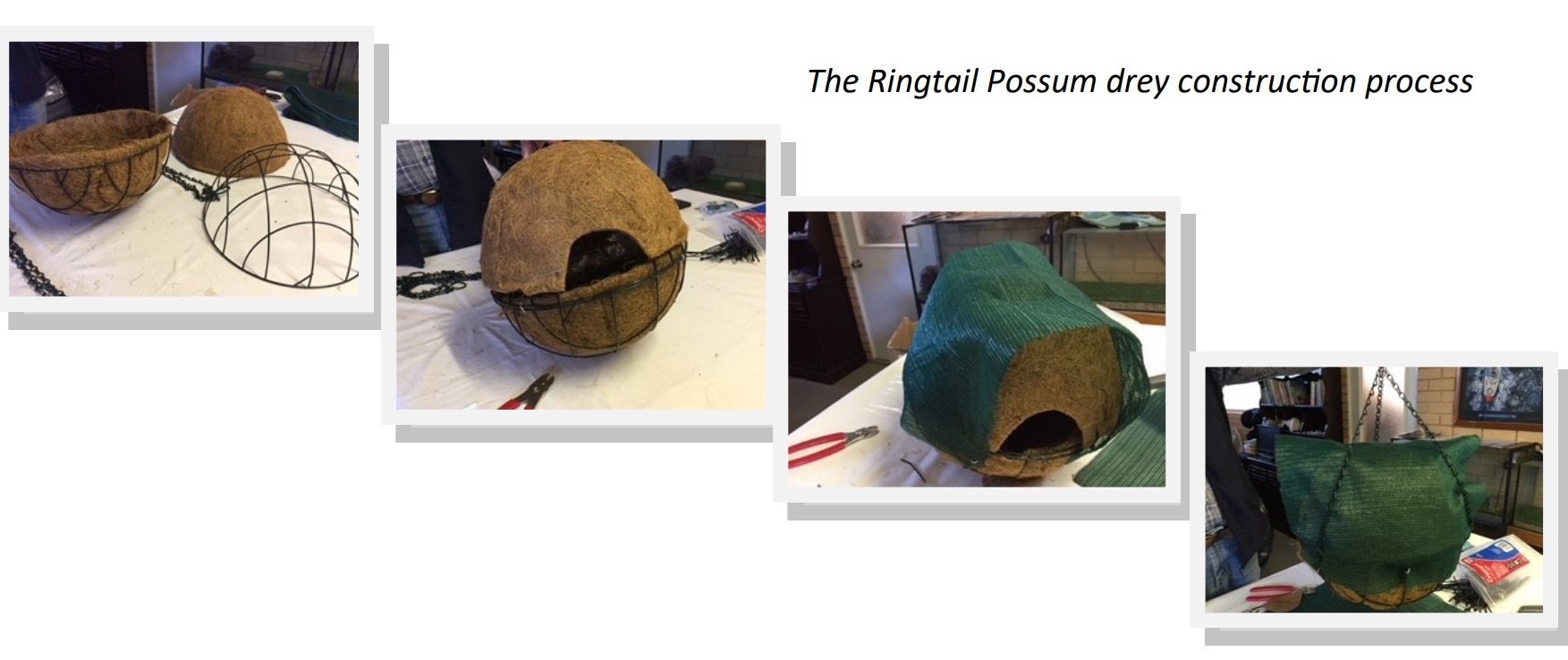
.jpg?timestamp=1631219892742)
Bilgola Bends Clean-Up
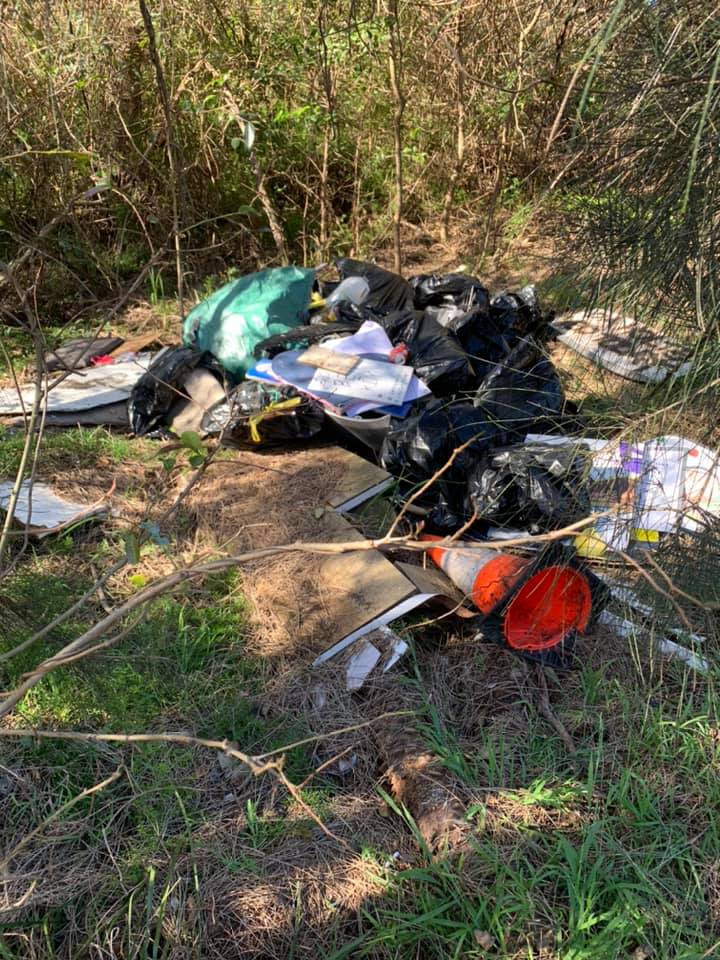
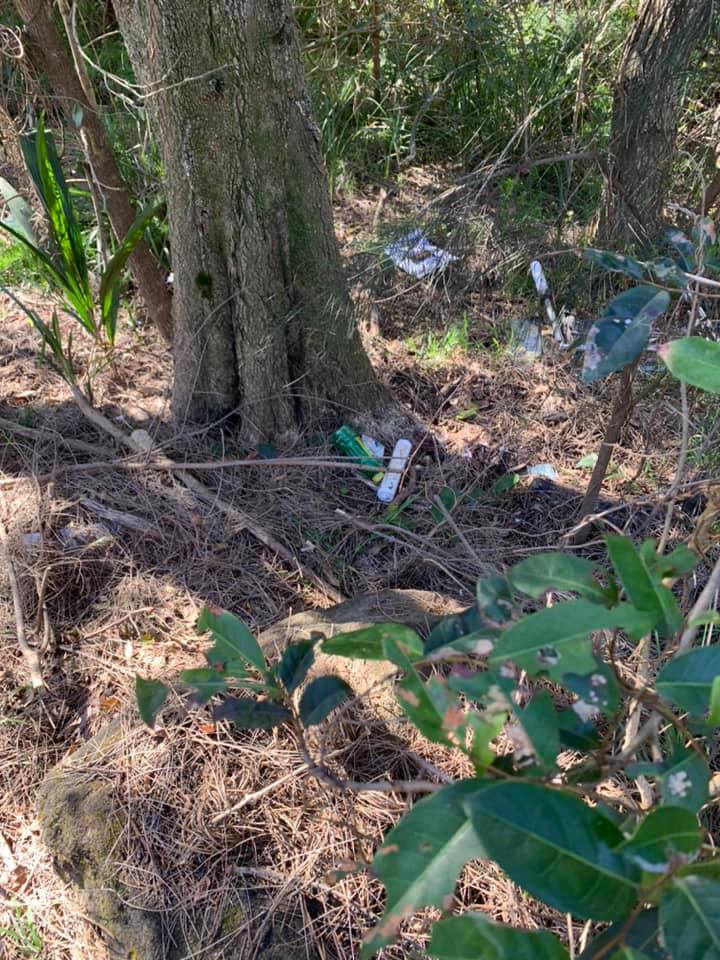
Migratory Bird Season
Baby Wildlife Season

Harry the ringtail possum. Sydney Wildlife photo
September Is Koala Month & Biodiversity Month
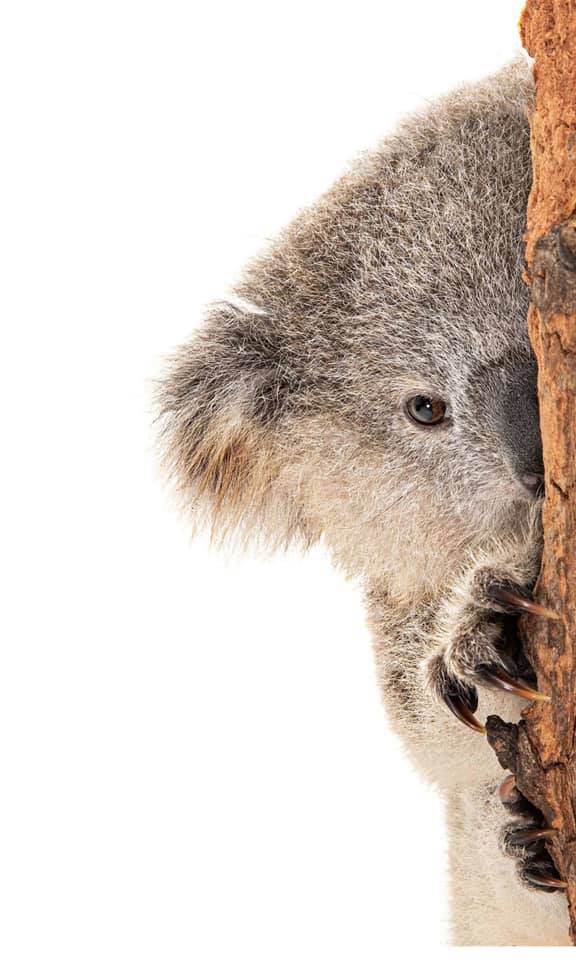
World Shorebirds Day 2021: New Documentary 'On The Right Track' Highlights Impact Of 4WD On Nesting Shorebirds
Coastal Collection – Starring 12 Charismatic Bird Species
Platypus To Make A Comeback In Australia's Oldest National Park
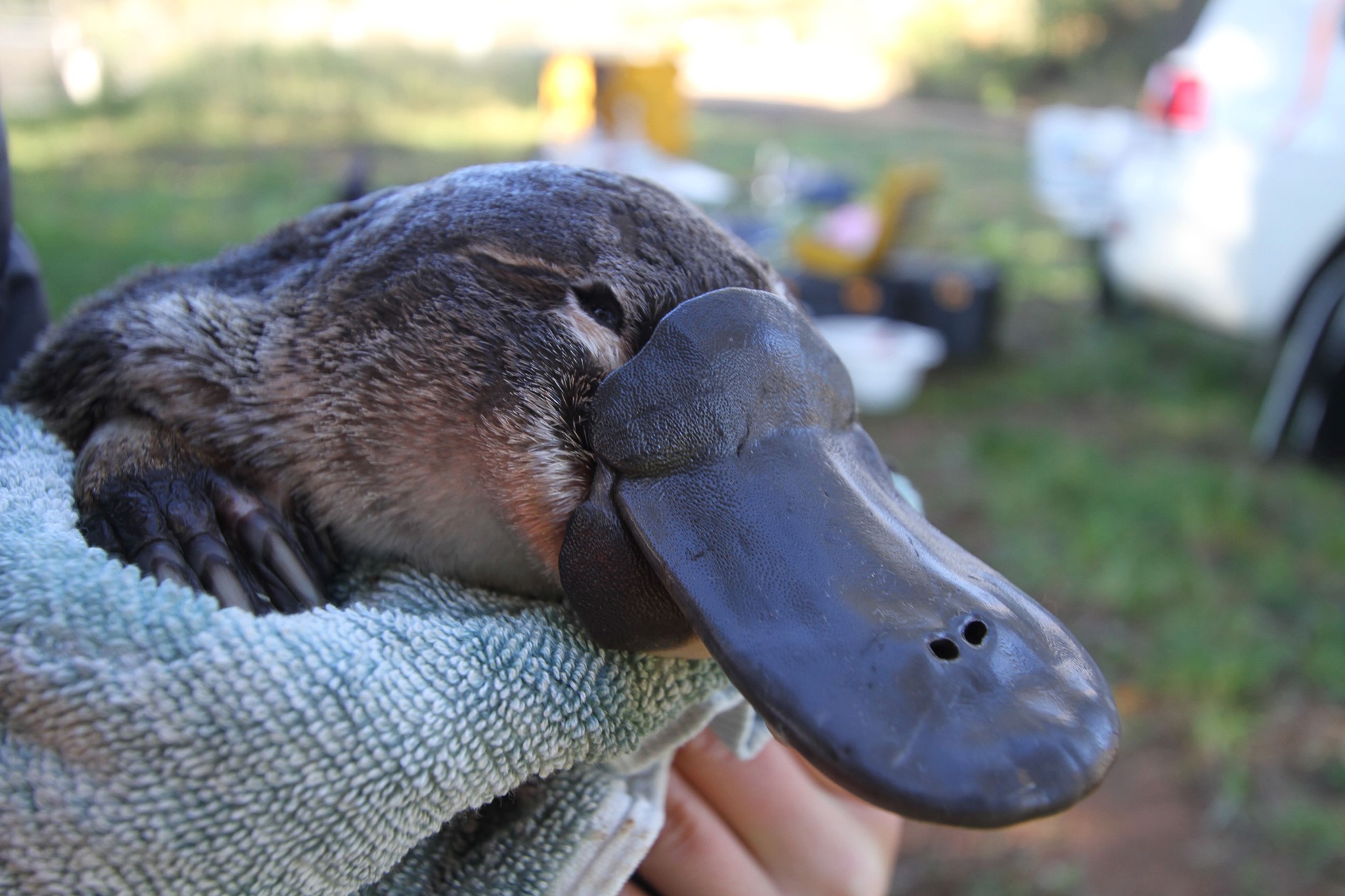
UNSW Team Of Ecologists To Develop 'Ecological Balance Sheet' For Royal National Park
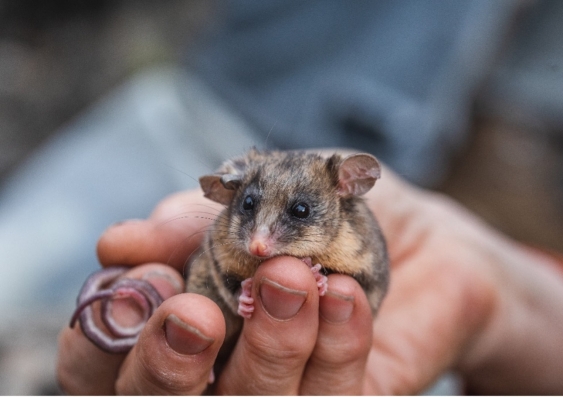
Keeping Cats And Wildlife Safe: Poll
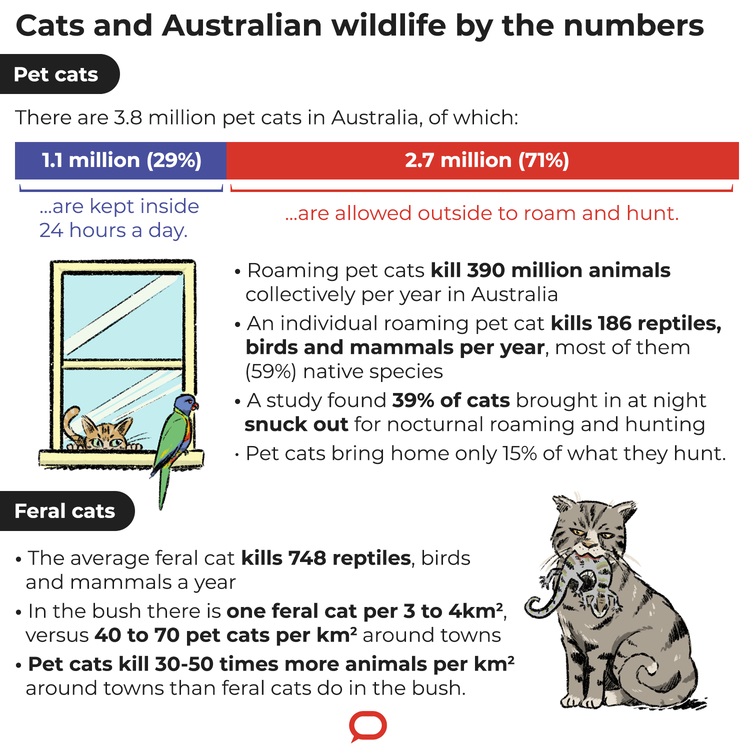
Seven Personality And Behaviour Traits Identified In Cats
September 7, 2021
Researchers at the University of Helsinki have developed a new comprehensive questionnaire for surveying feline personality and behaviour. A dataset of more than 4,300 cats representing 26 breed groups revealed seven personality and behaviour traits, with significant differences observed between breeds.
Cats are our most common pets, and feline behaviour is increasingly being investigated due to a range of behavioural problems. Another topic of interest in addition to behaviour traits is personality since it can be connected to behavioural problems.
"Compared to dogs, less is known about the behaviour and personality of cats, and there is demand for identifying related problems and risk factors. We need more understanding and tools to weed out problematic behaviour and improve cat welfare. The most common behavioural challenges associated with cats relate to aggression and inappropriate elimination," says doctoral researcher Salla Mikkola from the University of Helsinki and the Folkhälsan Research Center.
Seven feline personality and behaviour traits
In a questionnaire designed by Professor Hannes Lohi's research group, personality and behaviour were surveyed through a total of 138 statements. The questionnaire included comprehensive sections on background and health-related information. By employing, among other means, factor analysis to process the data, seven personality and behaviour traits in all were identified.
- Activity/playfulness
- Fearfulness
- Aggression towards humans
- Sociability towards humans
- Sociability towards cats
- Litterbox issues (relieving themselves in inappropriate places, precision in terms of litterbox cleanliness and substrate material)
- Excessive grooming
"While the number of traits identified in prior research varies, activity/playfulness, fearfulness and aggression are the ones from among the traits identified in our study which occur the most often in prior studies. Litterbox issues and excessive grooming are not personality traits as such, but they can indicate something about the cat's sensitivity to stress," Mikkola adds.

Differences in the prevalence of traits seen between breeds
In addition to individuals, clear personality differences can be found between breeds. In other words, certain personality and behaviour traits are more common among certain cat breeds.
"The most fearful breed was the Russian Blue, while the Abyssinian was the least fearful. The Bengal was the most active breed, while the Persian and Exotic were the most passive. The breeds exhibiting the most excessive grooming were the Siamese and Balinese, while the Turkish Van breed scored considerably higher in aggression towards humans and lower in sociability towards cats. We had already observed the same phenomenon in a prior study," says Professor Hannes Lohi from the University of Helsinki and the Folkhälsan Research Center.
The researchers wish to emphasise that no pairwise comparisons between breeds were carried out at this juncture.
"We wanted to obtain a rough idea of whether there are differences in personality traits between breeds. In further studies, we will utilise more complex models to examine factors that affect traits and problematic behaviour. In these models, we will take into consideration, in addition to its breed, the cat's age, gender, health and a wide range of environmental factors," Mikkola says.
Assessing reliability and validity
Feline behaviour and personality can be studied, for example, through questionnaires aimed at cat owners. Such questionnaires can measure feline behaviour in the long term and in everyday circumstances, which is impossible in behavioural tests. Furthermore, cats do not necessarily behave in test settings in a way typical of themselves. Due to their subjective nature, the reliability of the questionnaires must be assessed before the data can be exploited further.
"Internationally speaking, our study is the most extensive and significant survey so far, and it provides excellent opportunities for further research. The reliability of prior feline behavioural questionnaires has not been measured in such a versatile manner, nor are they as comprehensive as this one. Establishing reliability is key to making further analyses worthwhile and enabling the reliable identification of various risk factors," says Lohi.
The researchers reached out to cat owners who responded to the questionnaire one to three months ago, requesting them to fill out the questionnaire again or ask another adult living in the same household to respond to the questionnaire regarding the same cat. The goal was to assess the questionnaire's reliability both temporally and between respondents. Based on two additional datasets accumulated through this method, it was possible to evaluate the reliability of the questionnaire temporally and between respondents.
"By comparing the responses, we noted that the responses provided for the same cat were very similar, while the personality and behaviour traits were found to be reproducible and reliable. We also examined the validity of the questionnaire or whether it measures what it intended to measure. In these terms, too, the questionnaire functioned well," says Mikkola.
The research conducted by Lohi's group will make it possible to identify genetic, environmental and personality factors relating to problematic feline behaviour.
Salla Mikkola, Milla Salonen, Emma Hakanen, Sini Sulkama, Hannes Lohi. Reliability and Validity of Seven Feline Behavior and Personality Traits. Animals, 2021; 11 (7): 1991 DOI: 10.3390/ani11071991
Image: Compilded by Milla Salonen from photos of Heikki Siltala (catza.net/fi)
Bird Malaria Spreading Via Global ‘Hotspots’
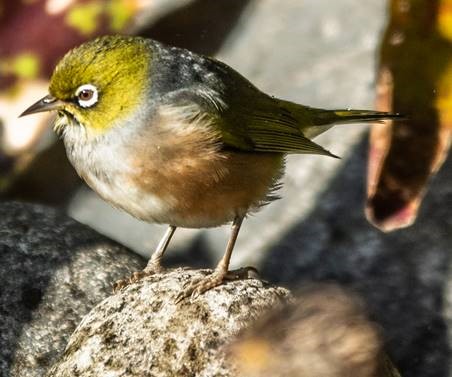 "In fact, here in Australia, some of these blood parasites are causing high infection rates in our songbirds, including silvereyes (Zosterops lateralis) and many species of honeyeaters (the Meliphagidae family)."
"In fact, here in Australia, some of these blood parasites are causing high infection rates in our songbirds, including silvereyes (Zosterops lateralis) and many species of honeyeaters (the Meliphagidae family)."Ancient Marsupial 'Junk DNA' Might Be Useful After All Scientists Say
Certainty For NSW Community And Industry On Energy From Waste
Central Coast Factory Fined For Discharging Wastewater
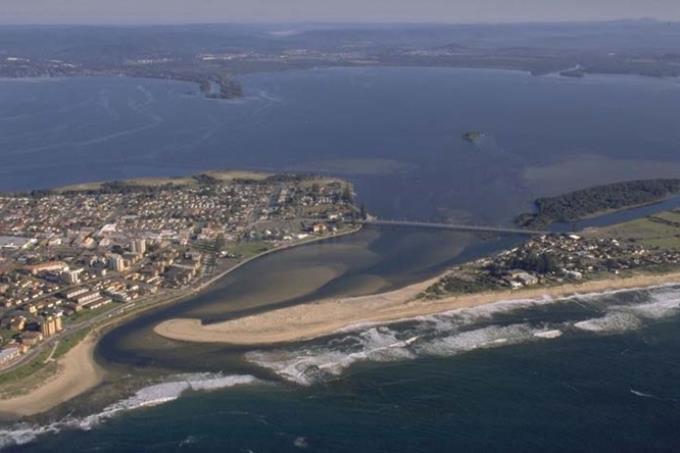 An Australian food company has been fined by the NSW Environment Protection Authority for allegedly discharging wastewater into a local waterway from its food production factory near Wyong.
An Australian food company has been fined by the NSW Environment Protection Authority for allegedly discharging wastewater into a local waterway from its food production factory near Wyong.Fisheries Officers Crackdown On Non-Compliance
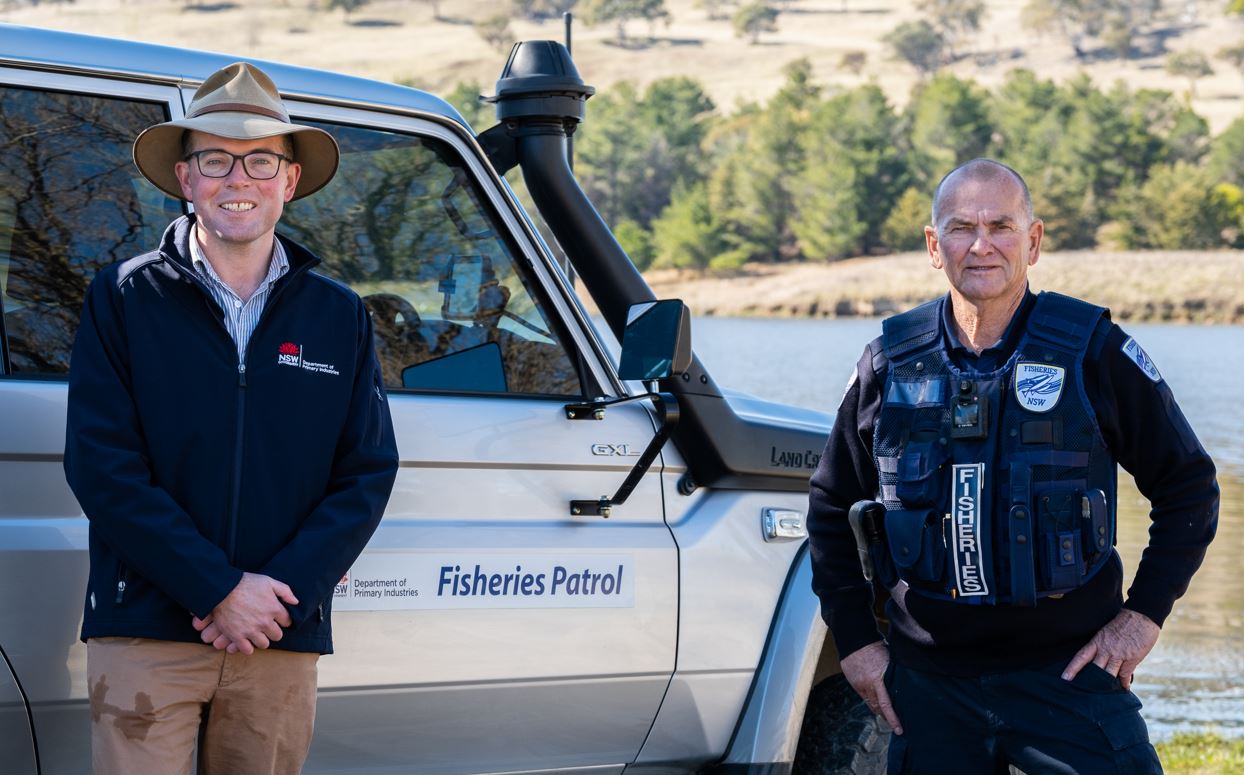
Brisbane To Pilot New Recycle Mate App
Yes, it is entirely possible for Australia to phase out thermal coal within a decade

Australia has received seemingly contradictory messages about coal this week.
In a UK study published today in Nature, scientists found Australia must keep 95% of coal in the ground if we have any hope of stopping the planet warming beyond the crucial limit of 1.5℃.
These findings echo the message of senior United Nations official Selwin Hart, who earlier this week urged Australia to end the use of coal by 2030. He warned if the world doesn’t boost climate action urgently, Australia can expect more frequent and severe climate disasters such as droughts, heatwaves, fires and floods.
Meanwhile, markets for coal seem to be sending the opposite message.
The price of Newcastle thermal coal recently reached a record high of US$180 per tonne due to rising electricity demand in India, China and other Asian countries. That seems to suggest whatever the consequences, Australia and the world are not going to give up on coal or other carbon-based fuels.
But it’s a mistake to place too much weight on fluctuations in coal markets. Earlier this year, the price was about US$50 per tonne and seemed likely to fall further. The current price tells us nothing about the choices we face in reducing emissions by 2030.
It’s entirely feasible for Australia to phase out thermal coal by 2030 — we just need political will.
World Economies Must Decarbonise
The authors of the new modelling study in Nature examined the world’s reserves of oil, gas and coal, and determined how much would have to be left untouched for at least a 50% chance of limiting global warming to 1.5℃.
Overall, it found nearly 60% of the world’s oil and fossil methane gas, and 90% of coal must remain unextracted by 2050. But the estimate for exporters like Australia is even higher.
This means production in most regions must peak now, or in the next decade, and that stronger policies are needed to restrict production and reduce demand.
The study reinforces how urgent it is to decarbonise economies. As Selwin Hart, the Special Advisor to the UN Secretary-General on Climate Action, noted in his speech to the Crawford Leadership Forum:
Decarbonisation of the global economy is quickly gathering pace. And there are huge opportunities to create more jobs, better health, and a stronger and fairer economy for those countries and companies that move first and fastest.
Is An End To Coal Feasible?
But would it really be possible for Australia to phase out coal by 2030, as Hart insists?
To consider this, it’s important to first distinguish between thermal coal and metallurgical coal. Thermal coal is used to generate electricity, while metallurgical coal is used in steelmaking.
Blast furnaces using metallurgical coal will ultimately be replaced by alternative technologies, such as using “green” hydrogen produced using clean electricity.
That process has begun, but it will take a long time, and can’t start until electricity generation is decarbonised. So, it makes sense to focus on phasing out thermal coal first.
But if decarbonisation of the global economy requires a rapid end to the use of thermal coal, why has its price suddenly surged?
A number of factors determine the thermal coal market, and fluctuations don’t tell us much about what the coal market will look like in 2030.
The recent increase in prices was caused by a combination of the rapid recovery from the pandemic recession, rising gas prices, weather-related disruptions to coal supply from Indonesia, and drought in China. It’s worth noting that despite high prices, the volume of seaborne thermal coal has actually declined.
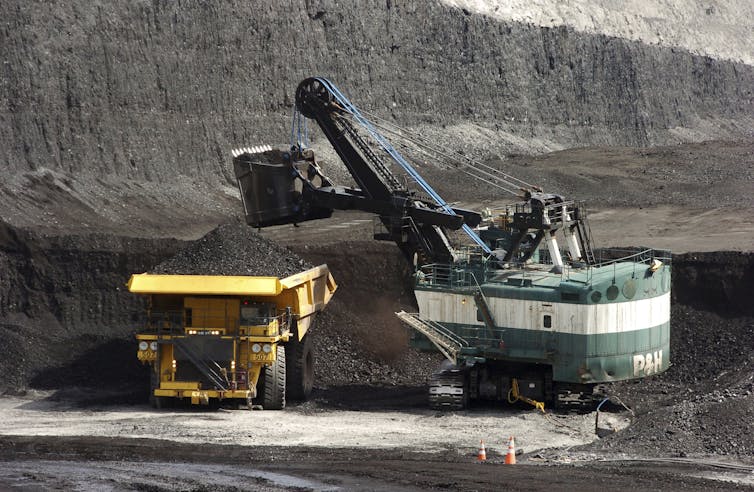
Ending Thermal Coal In Australia Would Be Easy
Given a modest amount of political will, or just the end of obstructionism from the federal government, Australia could easily replace coal-fired electricity generation with a combination of solar and wind, backed by storage.
Most of Australia’s coal-fired power plants were commissioned in the 20th century with obsolete sub-critical technology, and would be approaching the end of their operational lives even in the absence of climate change concerns.
Bringing those dates forward to 2030 or earlier could be almost costless. We could easily double our current rate of installation of utility-scale solar and wind generation, if the federal government got out of the way and let the states tackle the job.
Only five coal plants have been commissioned this century. The Bluewater plant in Western Australia has already been written off as worthless because of competition from solar and wind power.
The remaining four, all in Queensland, have a total capacity of less than 3 gigawatts. Allowing for the fact solar photovoltaic (PV) only operates in daylight hours, this is about the same as one million 10-kilowatt rooftop solar installations (about average for new installations). Queensland already has more than 750,000 solar rooftops, and capacity for another million.
More notably, the cost of decarbonising electricity supply is a fraction of the amount we have collectively spent to respond to the problem of the COVID-19 pandemic. Not only is COVID a smaller threat in the long run than climate change but a comprehensive response to pandemics requires us to stabilise the climate and stop the destruction of natural environments.
Read more: How to transition from coal: 4 lessons for Australia from around the world
Managing the transition for the coal workforce would be more challenging, but still entirely feasible, as countries such as Spain and Germany have shown.
In a report I prepared for the Australia Institute last year, I found Australia could successfully transition the workforce with a mixture of measures including early retirement, retraining, and investments in renewable energy targeted at coal-dependent regions.
The cost of this would be around A$50 million a year, over ten years. That’s less than the estimated cost of a week of COVID lockdown in Sydney.
But Would This Condemn Developing Countries To Energy Poverty?
The reality is it makes economic and environmental sense for all countries to shift away from coal.
The central government in China has committed to reach net zero carbon emissions by 2060. But many provincial governments still see investment in coal plants and other polluting industries as an engine of growth, not to mention a lucrative source of kickbacks and donations.
The picture in India is similarly complex. Coal remains the main source of electricity, but most electricity generation businesses have abandoned new investments in coal-fired power and many have stopped bidding for access to domestic coal supplies.
We can’t do much to influence energy policy in China and India. But a commitment to reduce and ultimately eliminate exports of thermal coal would not, as some have suggested, condemn these and other developing countries to poverty.
Rather, it would strengthen the hand of advocates of clean energy against the established interest groups that defend coal.![]()
John Quiggin, Professor, School of Economics, The University of Queensland
This article is republished from The Conversation under a Creative Commons license. Read the original article.
A promising new dawn is ours for the taking – so let’s stop counting the coal Australia must leave in the ground
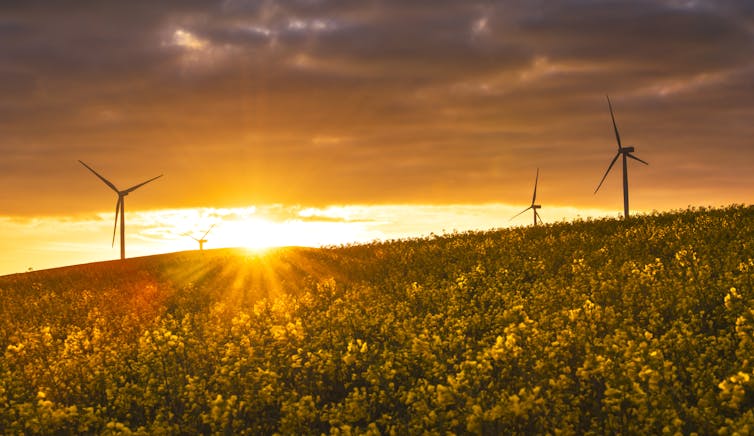
A study out today says the vast majority of Earth’s coal, including 95% of Australia’s, cannot be burned if global warming is to be limited to 1.5℃ this century. The findings are undoubtedly true. But examining how much fossil fuel the world can still use is not the question we should be asking.
Instead, the most useful questions are: how do we advance Australia’s economic future outside high-emissions industries? And how can we seize the opportunities presented by the declines of coal, and then gas, rather than watching the economy go underwater as we try to stem an unstoppable tide?
The world is moving away fossil fuels, and there’s nothing Australia can do about it. Racing to dig up and sell whatever fossil fuels we can before the timer stops is not a future-proof strategy. We need to prepare for the change and diversify the economy.
How much coal must remain in the ground is beside the point. Instead, we should grasp this moment – turning it into a positive step for the world community and future generations.

The Numbers Game
The new study by researchers at University College London examines how much fossil fuel can still be burned if we hope to keep the global average temperature rises to within 1.5℃ – the ambitious end of the Paris Agreement goals. It compares this “budget” with the known stores of coal, oil and gas in various parts of the world.
The study finds the vast majority of remaining fossil fuels must remain in the ground – specifically 89% of coal, 59% of gas and 58% of oil. For Australia, that equates to 95% of our coal reserves and 35% of our gas.
The research is a follow-up to a well-known 2015 study based on the 2℃ warming scenario. Similar findings have also been made in other research.
While it’s long been clear that much of Earth’s fossil fuel deposits must stay in the ground, there are uncertainties around the numbers. These come from varying assumptions about:
the exact size of the remaining global carbon budget for any particular temperature increase
how the carbon budget might be distributed between coal, oil and gas (which depends on technology choices and costs)
the extent of carbon capture and storage (or carbon use) and removal of carbon dioxide (CO₂) from the atmosphere
how much fossil fuel would be available for extraction.
The study released overnight offers results only from a single model and data set. The results remind us how little time remains to keep using fossil fuels, but we should not focus unduly on the headline numbers the study produced.
Read more: Yes, it is entirely possible for Australia to phase out thermal coal within a decade
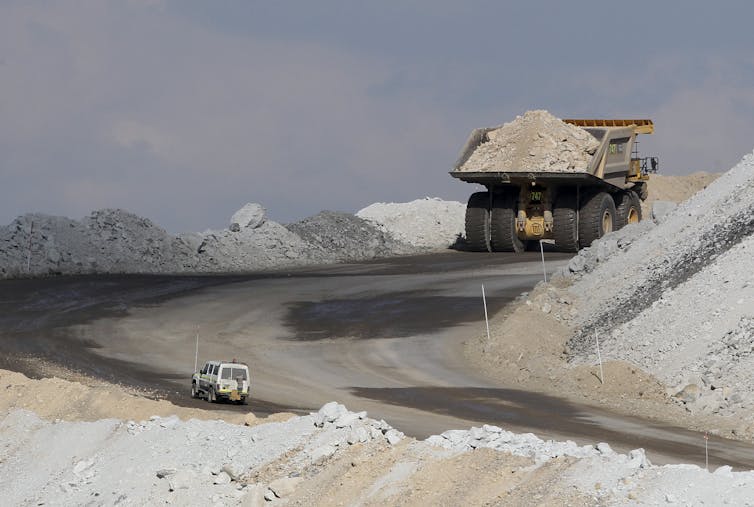
3 Lenses On The End Of The Fossil Fuel Age
Just as the Stone Age didn’t end for a lack of stones, the fossil fuel age won’t end for a lack of coal, gas or oil.
So while humanity is not running out of fossil fuels, we are running out of options for the waste product, carbon dioxide – and running out of time to deal with it.
Countries that produce and export large amounts of fossil fuels must address this undeniable reality. We characterise three different ways they can do this.
The first is the “hell-for-leather” approach: extract, use and sell whatever fossil fuels you can while there’s still a market, and promote the global use of fossil fuels to extend the ride. This is the natural stance for companies focused solely on fossil fuel production.
Some countries that export fossil fuels are pursuing such strategies. In Australia, a statement by federal Resources Minister Keith Pitt this week can be interpreted along such lines.
In this mindset, remaining fossil fuel deposits should be exploited to the maximum, at whatever cost. It emphasises specific business interests, while defining national interests in narrow and short-sighted terms.
It also disregards the global climate change objective and international relations with countries that emphasise climate concerns. In short, it risks train wrecks down the track.
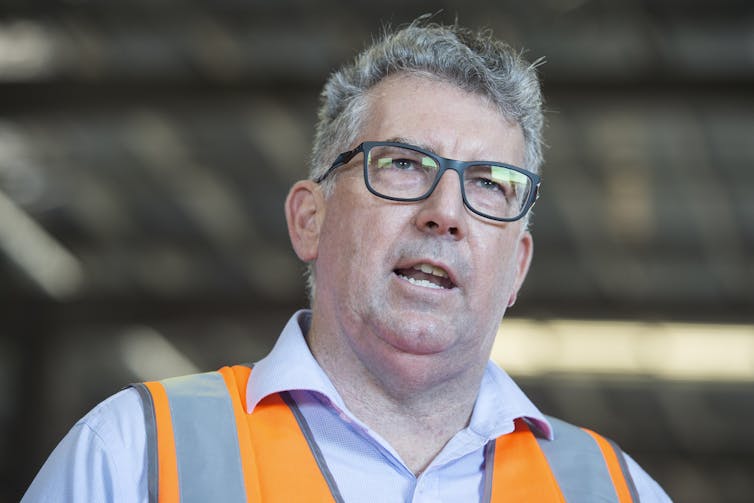
A second approach is to concede fossil fuels are on a long-term downward trajectory, due to climate change concerns and rapid improvements in clean technologies. It accepts this change is driven by consumers and there is nothing fossil fuel exporters can do about it.
The logical consequence is to prepare for the inevitable decline and cushion the transition. That could include using some revenue from fossil fuels to invest in a socially and environmentally sensitive transition.
Under this approach, the amount of fossil fuel available underground is simply irrelevant. The deposits are redundant – just like all those stones were at the end of the Stone Age. The question of what proportion must remain unexploited is of no particular interest.
A third option is to understand the challenge as a positive one: take the global shift away from fossil fuels as an opportunity to modernise and massively diversify the economy.
Taking this perspective, leaving coal in the ground is a positive step that helps nations and regions evolve in desirable ways and helps the world community, and future generations, deal with climate change. Not mining coal, then, takes on an ethical dimension – perhaps it can be seen as “ethi-coal”.

Preparing For A Post-Fossil Future
Whichever lens one chooses to look through, clean technologies will displace the burning of coal, oil and gas.
In Australia, large corporations (and to a lesser extent, some employees and public finances) have done well out of coal and gas. But that’s far from the only way we can derive large export revenues.
Australia is exceptionally well placed to build up an energy and processing industry based on its practically limitless renewable energy potential, coupled with experience with and predisposition towards large resource industries. This could include clean hydrogen and even green steel.
But to once again become dependent on just a few large industries, such as minerals or energy, should not be the goal here. Rather, we should use the global low-carbon transition as a platform for a large range of new industries. There are many opportunities in new technologies and practices.
So let’s keep our eye on the big picture: diversifying the economy into a broad range of activities with low environmental footprints, underpinned by modern infrastructure, top quality education and a strong social and health system.
Therein lies a desirable and economically sound future for Australia – one where we won’t be worrying one bit about all the coal left in the ground.![]()
Frank Jotzo, Professor, Crawford School of Public Policy and Head of Energy, Institute for Climate Energy and Disaster Solutions, Australian National University and Mark Howden, Director, ANU Institute for Climate, Energy and Disaster Solutions, Australian National University
This article is republished from The Conversation under a Creative Commons license. Read the original article.
Climate change means Australia may have to abandon much of its farming
Andrew Wait, University of Sydney and Kieron Meagher, Australian National UniversityThe findings of the Intergovernmental Panel on Climate Change suggest Australia may have to jettison tracts of the bush unless there is a massive investment in climate-change adaptation and planning.
The potential impacts of climate change on employment and the livability of the regions have not been adequately considered. Even if emissions are curtailed, Australia likely faces billions of dollars of adaptation costs for rural communities.
As the IPCC’s Sixth Assessment Report (published last month) makes clear, the climate will change regardless of any mitigation actions taken now.
Even under its modest conservative projections, worldwide temperatures will rise by 1.5℃. That may not sound like much, but it will double the frequency of droughts — from once every 10 years to once every five.
Worse still, a 2℃ temperature rise — also a likely outcome without substantial emission reductions — will make droughts 2.5 times more frequent.
Farm Profits Are Falling
Climate change is already hurting Australian farmers. Compared with historical averages, agricultural profits have fallen 23% over the 20 years to 2020. This trend will continue.
The Australian Bureau of Agricultural and Resource Economics and Sciences (ABARES) predicts a likely scenario is that overall farm profit will fall by 13% by 2050. There will be significant differences between regions. Cropping profits in Western Australia, for example, are predicted to drop 32%.
Effect of 2001-2020 seasonal conditions on farm profit

With higher emissions, the reductions will be worse. Estimates of the fall in farm profits range from 11% to 50%.
These changes go beyond the cycles of weather with which Australian farmers have always had to cope. Inconsistent water supplies, increased natural disasters and greater production risks will render agricultural production in many areas uneconomic.
Due to these climatic changes agricultural assets, both land and infrastructure, could become virtually worthless – so-called stranded assets.
No Future Without Water
Vibrant regional communities aren’t just about farms. They are interdependent networks of businesses, towns, public infrastructure and people.
The effect of falls in farm income will ripple throughout these communities. Lower output will mean fewer jobs. If farms close, so will other regional businesses, leading to more stranded assets. Those affected could face displacement along with an inability to sell their homes and businesses.
And of course these communities can’t survive without water.
So far development planning in Australia has not adequately considered the potential impacts of the climate on livability, especially in rural communities. This failure to account for climate change exacerbates the potential for stranded assets.
For example, the NSW Auditor General reported in September 2020 that the state government had “not effectively supported or overseen town water infrastructure planning in regional NSW since at least 2014”. This contributed during the intense drought of 2019 to at least ten regional NSW cities or towns coming close to “zero” water.
Read more: Helping farmers in drought distress doesn't help them be the best
Population Pressures
In some areas these water problems are being compounded by population growth.
Consider, for instance, the NSW townships surrounding Canberra. In January 2020 the town of Braidwood (about halfway between Canberra and Batemans Bay) had to start trucking in water when its own water source, the Shoalhaven river, stopped flowing. Yet nearby Bungedore (about 50 km away) is building a new high school due to population growth.
This “tree-change” trend, with people leaving cities in search of a better lifestyle and more affordable housing, is widespread. It appears to have been amplified by the COVID-19 pandemic, with figures showing net internal migration of people out of Sydney and Melbourne.
More Investment In Adaptation Needed
There is an urgent need for a comprehensive assessment by all levels of government of risks to livelihoods in agriculture and regional communities, and of the default risk on stranded assets.
Budget projections need to account for climate-change adaptation and economic structural change.
In last year’s budget the federal government committed to investing A$20 billion “to ensure Australia is leading the way in the adoption of new low-emissions technologies while supporting jobs and strengthening our economy”.
As important as this is, we must start planning and spending on adaptation.
Read more: Australian farmers are adapting well to climate change, but there's work ahead
The A$1.2 billion over five years the federal budget allocated for natural disasters is just the beginning. In some regions changed farming practices, subsidised insurance and investment in water infrastructure may be enough. But proper infrastructure takes many years to plan, and to build.
Some areas are going to become unviable. We will need deal with the loss of entire communities, and internal climate refugees.
It is time to start budgeting for the costs of living with climate change, not just the costs of cutting emissions.![]()
Andrew Wait, Professor, University of Sydney and Kieron Meagher, Professor, Research School of Economics, Australian National University
This article is republished from The Conversation under a Creative Commons license. Read the original article.
How urban soundscapes affect humans and wildlife — and what may have changed in the hush of lockdown
Kurt Iveson, University of Sydney and Dieter Hochuli, University of SydneyThe dull roar of traffic, the barking of dogs in backyards and the screeching of cockatoos at dusk. The shattering of early morning quiet by the first plane overhead or the garbage truck on its rounds. The squealed delights and occasional fights of a children’s playground.
These sounds and many more create what Canadian composer R Murray Schafer famously called a “soundscape”. Schafer, who passed away last month, helped us realise we experience cities with our ears as well as our eyes.
In recent years, studies have confirmed these soundscapes affect the well-being of urban inhabitants — both human and non-human. But with much of the country back under lockdown, urban soundscapes have changed, sometimes bringing delight, but sometimes causing new distress.
So let’s take a moment to consider how soundscapes influence our lives, and the lives of urban wildlife.
When Sounds Become ‘Noise’
Whether it’s housemates, traffic, or construction, we tend to respond to many urban sounds by defining them as “noise”, and try to shut them out. We do this using a range of techniques and technologies: building regulations on soundproofing, controls on the times for certain activities like construction, and planning measures.
But noise mapping efforts show such regulations tend to produce uneven urban soundscapes — some people are more exposed to loud or annoying sounds than others.
Housing quality is a major factor here, and noise problems are likely exacerbated under lockdown. A recent study of pandemic housing inequality in Sydney found increased exposure to noise during lockdown is significantly contributing to poor well-being.
For example, sounds travelling across internal and external walls of apartments were frequently a source of tension in pre-pandemic times. Now, with so many more people spending more time at home, these domestic sounds inevitably increase.
Read more: Coronavirus reminds us how liveable neighbourhoods matter for our well-being
It’s not just humans whose lives are disrupted by city noise, as many animals use sound to communicate.
The ever-vigilant New Holland honeyeaters of Australian cities use their alarm calls to warn their friends and neighbours of danger, while the iconic chorus of banjo frogs in wetlands are the hopeful calls of males seeking mates.
Noisy environments can dramatically change how these animals behave. In some cases, animals adapt to their noisy environment. Some frogs, for example, overcome traffic noise disrupting their sex lives by calling at a higher pitch. Likewise, populations of bow-winged grasshoppers in Germany exposed to road noise sing at higher frequencies than those living in quieter areas.
For other animals, such as microbats in England, disruptive noise changes how they forage and move around their environments.
Read more: How noise pollution is changing animal behaviour
In extreme cases, these human-associated noises can drive animals away from their homes, as the disruptions to their lives becomes untenable.
Urban black-tufted marmosets in Brazil have been shown to avoid areas with abundant food where noise may interfere with their vocal communication. And research shows intruding noise in stopovers for migratory birds in the United States reduces their diversity by 25%, with some species avoiding the stopovers altogether.
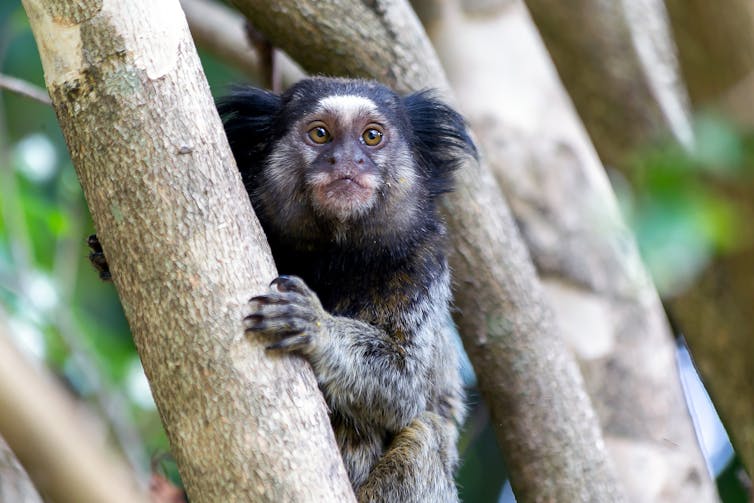
A New Quiet?
The soundscape of cities in lockdown can be dramatically different from what we have come to accept as normal.
First, there are new noises. For example, in Sydney’s areas of concern subject to tighter lockdown restrictions, people are living with the frequent intrusive noise of police helicopters patrolling their neighbourhoods, making announcements over loudspeakers about compliance.
But in other cases, as our movements and activities are restricted, some city sounds associated with a negative impact on well-being are significantly reduced. People who live near major roads, aircraft flight paths, or construction sites will certainly be noticing the quiet as road traffic is greatly reduced and non-essential construction is paused.
But of course, while this silence might be golden for some, for others the sound of silence is the sound of lost work and income. This quietude may even be considered as unwelcome or even eerie — the sonic signature of isolation, confinement and loss.
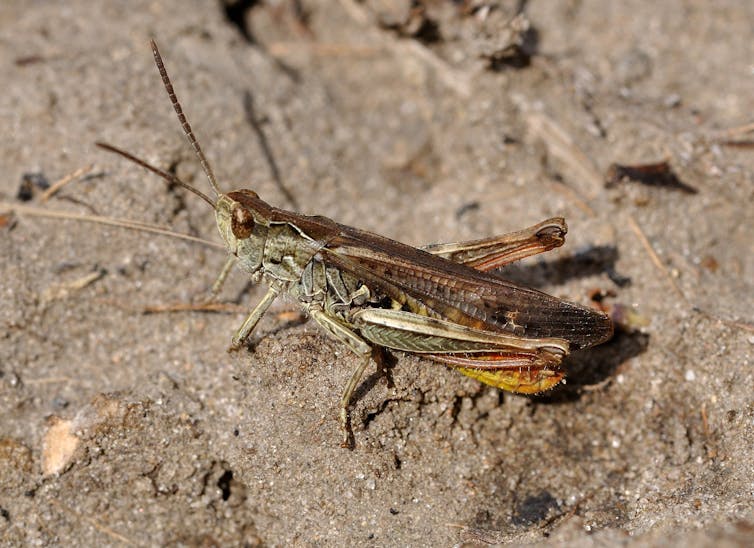
Just as many animals adapt to or avoid noisy urban environments, there is a chance many will respond to this natural experiment playing out. Quieter urban environments may see the return of some of our more noise sensitive species, but this depends on the species.
The Brazilian marmosets mentioned earlier didn’t return to those locations even during quieter times, suggesting the noise left a disruptive legacy on their habitat choice, well after it was experienced. On the other hand, other experiments show some species of birds rapidly returned to sites after noise was removed from the landscape.
Read more: Birdwatching increased tenfold last lockdown. Don't stop, it's a huge help for bushfire recovery
While it’s too early to confirm any early speculation about nature returning to quieter urban environments during lockdown, there is compelling evidence many people will benefit from engaging with local nature more actively than they did before.
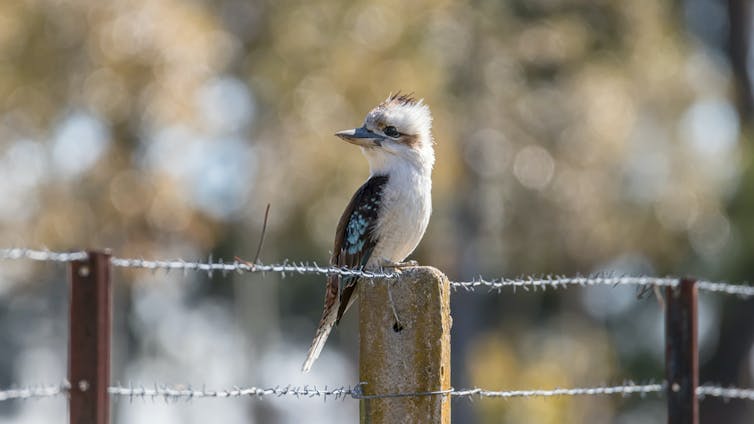
Many more Australians are acting as urban field naturalists. Birdwatching, for example, increased tenfold in lockdown last year.
It’s clear people are seeing novelty and wonder in animals and plants that have survived and even thrived in our cities right beneath our noses the whole time. Our increased use of local greenspace during the pandemic has created new opportunities to find the extraordinary in the ordinary.
Rethinking Post-Pandemic Soundscapes
What might we learn from this natural experiment about the soundscapes we take for granted and the soundscapes we actually want?
This is an invitation to think about whether we ought to do more to control sounds we consider “noise”. Yes, decibel levels of activities like car and air traffic matter. But it’s also an opportunity to think beyond controlling sounds, and consider how we might create soundscapes to enhance human and non-human well-being. This is easier said than done, given there’s no universal measure of what sounds give pleasure and what sounds are perceived as noise.
This aligns with the growing body of evidence on the need to reduce noise pollution and protect biodiversity when planning and managing our cities.
Like just about every other dimension of urban life, envisioning and creating an improved urban soundscape requires careful attention to spatial inequality and diversity - including of species - and a capacity to work through our differences in a fair and just way.
Read more: Where the wild things are: how nature might respond as coronavirus keeps humans indoors ![]()
Kurt Iveson, Associate Professor of Urban Geography and Research Lead, Sydney Policy Lab, University of Sydney and Dieter Hochuli, Professor, School of Life and Environmental Sciences, University of Sydney
This article is republished from The Conversation under a Creative Commons license. Read the original article.
What ancient Chinese roofs can tell us about climate change

To reconstruct a picture of past climates, scientists often examine trapped bubbles in ice cores or the width of rings inside old trees. A new study, published in Science Advances by researchers at Nanjing University in China suggests that there may even be clues to changes in past weather conditions in buildings.
The researchers compared data on shifting weather patterns between AD750 and 1750 with examples of preserved roofs built in China during the millennium. They found that during periods with heavier snowfall, roofs were built with steeper slopes, while warmer periods gave rise to buildings with more gently sloping roofs.
The study covered two large swings in the global climate: the medieval warm period, which roughly ran from the tenth to the 13th century, and the little ice age, which saw shorter summers and bitter winters between the 15th and 19th centuries.
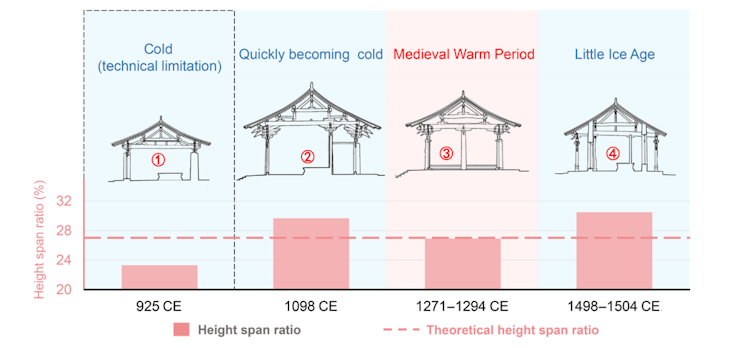
Changing weather patterns may have spurred innovation too, as the researchers note that frigid weather around 1700 coincided with new methods that made the construction of steeper and straighter roofs safer and more reliable.
It’s incredible to think that something as subtle as the angles of pitched roofs might intimately reflect changes in the weather over ten centuries. It’s a compelling story, but as someone who has studied architectural history for many years, I have some doubts.
Architecture And The Climate
The researchers made two basic points. One, that roofs are built steeper in eras and places with heavier snowfall. And two, that there is a close correlation between weather patterns and roof angles that betrays a sensitivity in architecture to very small changes in the climate.
The first point is fairly easy to prove and probably undisputed among academics. A carpenter will correct the roof angle once a building has collapsed under heavy snow, and showing this with the example of historic buildings in China has its merit.
The second point, to my mind, is not coherently proven by this study and may even be impossible to prove. The researchers mention studying around “200 [building] remains over a millennium”, but it’s not clear whether these are equally spaced out across the study period. They could get away with it being historians as opposed to, let’s say, medical doctors, where sample size is the litmus test of sound methodology.
It’s also unclear why roofs in warm times should become less steep. The researchers ought to be commended for trying to address this problem though, as the study notes that Chinese people may have failed to maintain steeper roofs in times when snowfall was less severe due to “costs and the diverse need for sunshine and rainfall sheltering”. The researchers nonetheless do not develop this point or explain why flatter roofs should be more cost effective.
Building a roof is not a collective event akin to population decline, infant mortality or market prices, however. It depends on the conscious decision of a particular person – a client, architect or artisan. To prove a connection, the researchers would need a theory of how builders would be able to react to tiny changes in the climate with tiny changes in roof angles. Exaggerating this climate connection in architecture might imply, wrongly, that premodern societies were predominantly shaped by some inexplicable harmony between people and nature, with an ability to respond to tiny changes in the environment that were lost in later periods.

Such fine-scale responses between building and weather as far as I know, do not happen in the present. Snowfalls became lighter and less frequent in the UK throughout the 20th century, but it would be unconvincing to tie this to the proliferation of modern flat roofs, which have become just as popular in snowy Russia. And even a fundamental decision such as choosing between a flat roof or a pitched one seems to defy climatic necessities, as the lamentably high number of leaking flat roofs in rain-swept Glasgow where I live demonstrates.
Nonetheless, the study provides an eloquent reminder of how natural variation in the weather has been an influence on architecture throughout history, often as much as changing styles and tastes.
Most of the buildings we live, work and socialise in were designed with little thought paid to the unprecedented weather extremes that climate scientists warn are in store this century. That will have to change. Historians may one day study the era we live in and note how architecture regained a sense of environmental limits, as leaky and inefficient designs were swept away by buildings that were resilient in the face of increasing storms.![]()
Florian Urban, Professor of Architectural History, Glasgow School of Art
This article is republished from The Conversation under a Creative Commons license. Read the original article.
African tropical mountain forests store far more carbon than previously thought – new research

Tropical forests are well known for being the “lungs” of our planet. Through photosynthesis, the trees in these forests produce oxygen and remove enormous amounts of carbon dioxide from the atmosphere, helping to mitigate global warming.
The world’s most famous tropical forests found on lowlands, like those of the Amazon or Borneo, are celebrated for their ability to store carbon. The Amazon rainforest itself holds up to five years’ worth of human carbon emissions in its trees and soil.
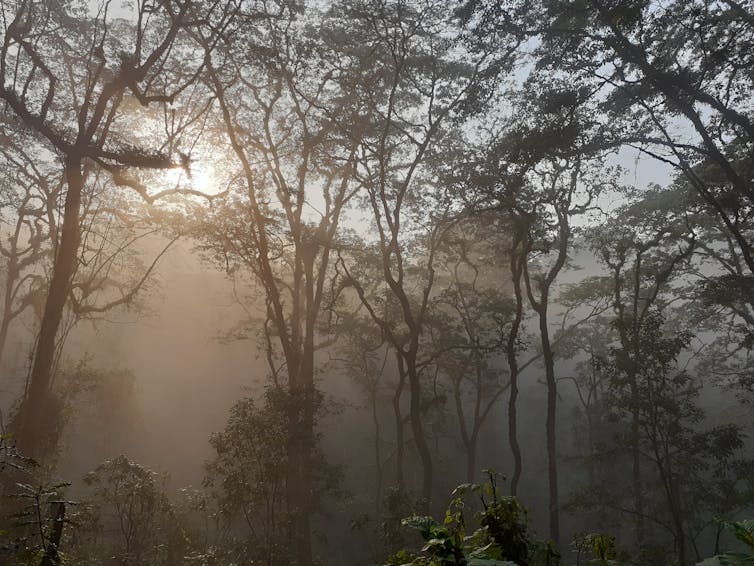
While tropical forests can also be found on tropical mountains such as Mount Kinabalu in Borneo, these have long been assumed to store much less carbon. On mountains, temperature decreases with increasing elevation, negatively affecting tree growth. Also, common mountain features such as thick fog, wind and steep slopes tend to constrain tree height.
If trees are smaller, and grow slower, then mountain forests should contain less carbon sequestered from the atmosphere through growth processes: a hypothesis which has been reflected in studies of tropical mountains in the Andes and southeast Asia.
But our research, recently published in Nature, shows that tropical mountain forests in Africa actually store as much carbon per hectare as those found in African lowlands – a finding specific to the continent.
This is because, although African tropical mountain forests have fewer trees (about 450 per hectare compared to 600 in other continents) than their lowland counterparts, they have a greater abundance of large trees (over 70 cm in diameter), whose increased mass means they hold on to more carbon.
We wondered if this unusual finding was thanks to elephant populations resident in many African tropical mountain regions, who eat and destroy smaller tree stems – creating room for others to grow larger – and also transport nutrients which are limited in mountain soils.
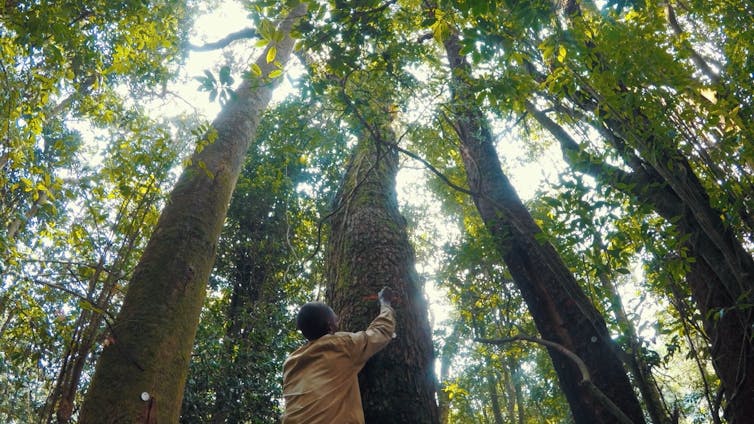
But we didn’t find significant differences in tree height between forests with and without elephants, although unfortunately our data only showed us if elephants were present in a given area and not how many were around. Other explanations could include the low frequency of tropical cyclones or active volcanoes in Africa, making it less likely for trees to be destroyed before they grow tall.
Carbon Storage
A group of 101 researchers working at different institutions across Africa, Europe, North America, Asia and New Zealand measured 72,336 trees with trunks of over 10cm diameter on 44 mountains in 12 countries within the African continent. For each tree we recorded trunk diameter, species and height.
We used an equation to estimate the carbon stored in these forests, since actually cutting, drying and weighing trees – technically the most accurate method for analysing carbon capture – would rather undermine our aim to mitigate climate change.
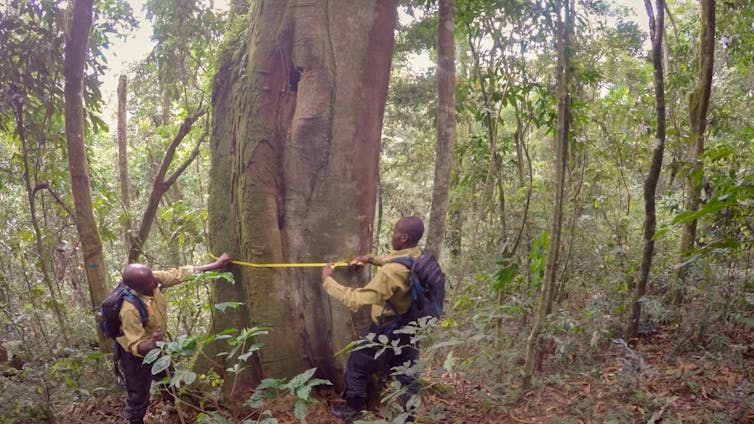
We then calculated how much tropical mountain forest had been lost in the African continent over the past 20 years, using data from satellites. We estimated that 0.8 million hectares had been lost, mostly in DRC, Uganda and Ethiopia.
Unexpectedly, given the steep terrains which make logging operations or large-scale farming challenging, we found that in many African countries deforestation rates were higher in the mountains than the lowlands.
So if these mountain forests store more carbon than expected, we are releasing more carbon dioxide into the atmosphere than previously assumed. In fact, the 0.8 million hectares of mountain forest destroyed since 2001 has emitted more than 450 million tonnes of carbon dioxide into the planet’s atmosphere, accelerating global warming.
Biodiversity Loss
African tropical mountain forests are not only carbon-rich: they are also rich in biodiversity. Among their huge trees live elephants, mountain gorillas, chimpanzees, and numerous species of birds, amphibians and snakes found nowhere else in the world. Continued deforestation will push many of these creatures further towards extinction.
These forests also act as “water towers” (like giant water tanks), irrigating agricultural land and supplying numerous vital river systems including the Congo and the Nile. This makes them crucial for local and regional crop growth, hydropower systems providing renewable energy, and inland fisheries supporting nutritious diets and livelihoods for local communities.
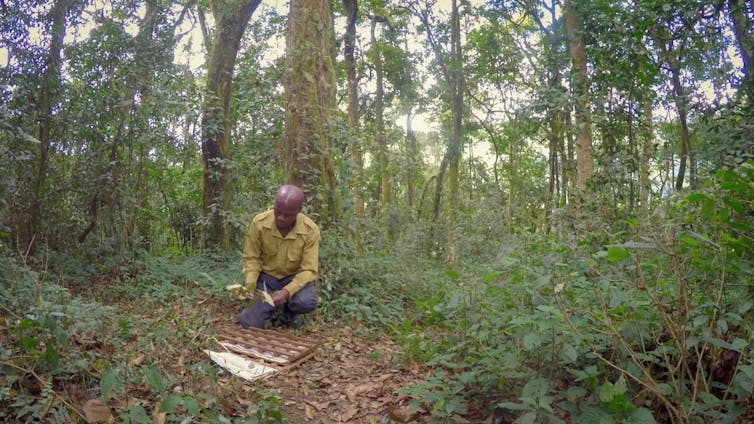
Mountain forests often collect water droplets from fog in a process known as “occult precipitation”. This makes local landscapes much more humid than if the forests were not present. Destroying these forests is therefore not only terrible for our global climate, but also for regional weather and biodiversity, since many species require the specific conditions created by this humidity to thrive.
But our study also provides some hope. If these forests store more carbon than previously assumed, it could allow us to increase the economic benefits awarded to developing countries who successfully decrease deforestation, meaning greater incentives for forest conservation – and better futures for those who call the mountain forests home.![]()
Aida Cuní Sanchez, Postdoctoral Research Associate, University of York; Martin Sullivan, Lecturer in Statistical Ecology, Manchester Metropolitan University, and Phil Platts, Research Fellow, University of York
This article is republished from The Conversation under a Creative Commons license. Read the original article.
Want to act on climate change but not sure how? Tweaking these 3 parts of your life will make the biggest difference

Last month’s dire report by the Intergovernmental Panel on Climate Change may have left you feeling overwhelmed, or unsure what to do next. We often hear about ways everyday people can tackle climate change, but which acts will make the biggest difference?
The academic literature tells us three spheres of our lives contribute most to climate change: home energy use, transport, and food consumption. Together, these activities comprise about 85% of a household’s carbon footprint.
As one study showed, by adopting readily available practices, households in developed countries can cut their carbon footprint by 25% with little or no reduction in well-being.
Clearly, national governments must set, and meet, ambitious emissions-reduction targets. But 72% of global greenhouse gas emissions are related to household consumption. So small changes at the household level really can make a world of difference. Here’s a guide to get you on the right path.
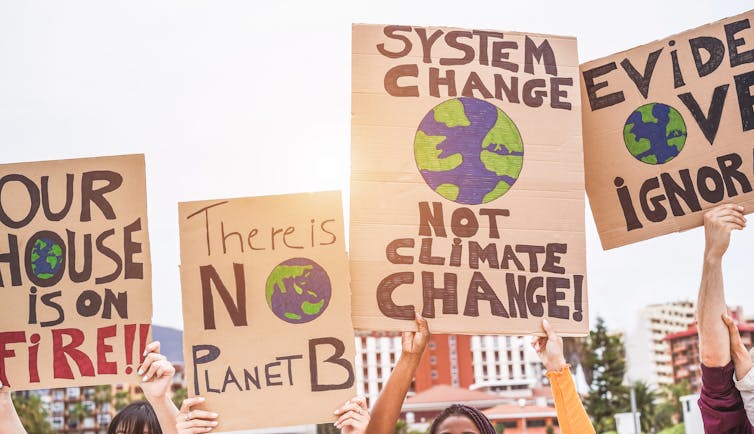
1. Home
Using energy in the home more efficiently is a good way to reduce your impact on the climate. Signing up to so-called “demand response” programs is a relatively new way to do this.
Demand response involves making changes to energy use to reduce stress on the electricity grid during times of high demand. In Australia, this often entails electricity companies offering financial incentives to households so they use less energy at peak times.
For example in Queensland, the state-owned company Energex offers up to A$400 to those who install a “PeakSmart” air conditioner. When the electricity system is under stress, the electricity network will remotely switch the air-conditioner into a lower performance mode.
Energy retailers have also been trialling demand response programs in other states. For example under AGL’s Peak Energy Rewards program, customers can choose to receive an SMS message prompting them to reduce their energy use at peak times. By turning up the temperature on the air conditioning or waiting to do the laundry, people can earn discounts on their energy bills.
Demand response leads to less electricity use and reduces the need for fossil-fuel electricity generation at times of high demand – and so, can cut greenhouse gas emissions in the electricity sector.

2. Transport
If you drive a traditional petrol or diesel vehicle, try to reduce the amount of time your engine idles. Research last year found Australian motorists are likely to idle more than 20% of the time they’re driving. If idling was eliminated from all journeys, the emissions saved would equal that of removing up to 1.6 million cars from the road.
While some idling is unavoidable such as when stopped at traffic lights, drivers can turn their engines off while parked and waiting in their vehicle.
And drive smoothly, not aggressively. Driving with limited acceleration and braking has been found to significantly reduce emissions.
You might be thinking of making your next car an electric vehicle. While the cost of electric vehicles has traditionally been prohibitive for many people, the technology is expected to reach price parity with conventional cars in Australia in the next few years. And these days, you can even get a good second-hand deal.
There’s a lot of misinformation out there about whether electric cars are a good choice for the planet. So where does the truth lie?
It’s true that electricity used to charge an electric vehicle’s battery is often sourced from fossil fuels. And energy is still required to make an electric vehicle - in particular, the battery.
Read more: Want an electric car? Here's how to buy second-hand
However, last year, research found in 95% of the world, electric vehicles were less emissions-intensive than traditional cars over their full life cycle – even accounting for the current emissions intensity of electricity generation.
If you buy an electric vehicle, it’s important to ensure potential emissions savings are realised. One way of doing this is by recharging during the middle of the day when renewable electricty is most abundant. And don’t forget, as renewable energy forms an ever-increasing share of the electricity mix, the climate benefits of electric vehicles become even greater.
And of course, don’t forget about the obvious low- or zero-emission ways to get around: walking, cycling, catching public transport and car pooling.

3. Food
Research earlier this year showed food systems are responsible for a third of human-caused greenhouse gas emissions. And recent studies show even if the world stopped burning fossil fuels immediately, emissions from the global food system could still push global temperatures over the 1.5℃ warming threshold.
Reducing meat consumption is a well-known way to cut your carbon footprint. In fact, recent research from Sweden showed just how high emissions from meat and dairy products are, compared with substitute products. It found:
- lamb is 25 times more polluting than tofu
- milk is five times as polluting as oat drink
- dairy-based cheese is four times as polluting as vegan cheese.
Read more: Ordinary people, extraordinary change: addressing the climate emergency through 'quiet activism'
In Australia, the range of meat alternatives is growing quickly. In just one example, Sydney-based All G Foods is developing plant-based mince, sausages, chicken and bacon, as well as “cow-free” dairy products. Helped along by $5 million in federal government funding, the company’s first product launches this month.
Another food that promises to help cut your carbon footprint is seaweed. Australia is only just catching on to the benefits of commercial seaweed production, which can be grown with few environmental costs.
Australia’s first factory manufacturing food-grade seaweed products opened in New South Wales last year. It has the capacity to put seaweed into pastas, and even muesli!

Reduce, Reuse, Inspire
Reducing your climate footprint is not just about buying “green” stuff: it’s also about avoiding consumption in the first place. So try to buy less – and if you can’t avoid it, try and buy second-hand.
You never know, you might start a revolution. Evidence suggests people who observe their peers undertaking environmentally friendly behaviour often adopt similar actions.
Andreas Chai, Associate Professor, Griffith University
This article is republished from The Conversation under a Creative Commons license. Read the original article.
Australia’s first offshore wind farm bill was a long time coming, but here are 4 reasons it’s not up to scratch yet
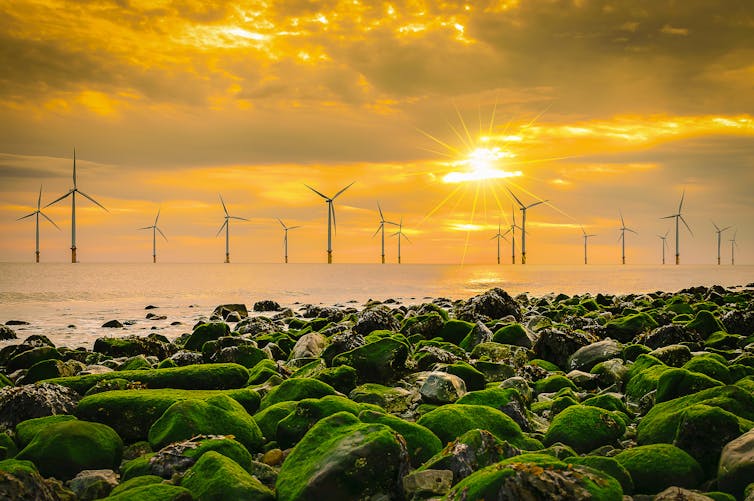
After years of waiting, the federal government finally introduced Australia’s first offshore electricity legislation in parliament yesterday. The bill will establish a regulatory framework for the offshore wind industry, paving the way for more than ten proposed projects.
Australia’s wind resources are among the world’s best, comparable to the North Sea between Britain and Europe where offshore energy is an established industry. In fact, research from July found if all the proposed offshore wind farms were built, their combined energy capacity would be greater than all of Australia’s coal-fired power plants.
But Australia’s lack of legal framework has meant we’re yet to commission our first offshore wind farm.
The new legislation took years of stakeholder anticipation leading to public consultation in 2020, but upon first reading one is left a little wanting. We find four reasons the bill isn’t up to scratch yet, from its inadequate safety provisions to vague wording around Native Title rights and interests.
A Huge Opportunity
The International Renewable Energy Agency (IRENA) identifies offshore wind as key in the transition from fossil fuels to clean energy, calling for the world’s offshore wind capacity to increase ten-fold, to 45 gigawatts per year by 2050.
In line with IRENA’s position, many of Australia’s trading partners have ambitious targets for offshore wind, including the UK, US, European Union, Korea and Japan. For example, the UK’s target is to reach a total of 40 gigawatts of offshore wind energy by 2030.
This new bill is Australia’s attempt to join its partners. It will give offshore electricity projects the framework for construction, operation, maintenance, and more.
One project, for example, is the Star of the South, which plans to build an offshore wind farm off the coast of Gippsland in Victoria. This project has the potential to supply 20% of the state’s energy needs. Like Australia’s other 12 proposed offshore wind projects, it has been waiting on an appropriate regulatory framework to go ahead.
Read more: Wind turbines off the coast could help Australia become an energy superpower, research finds
Offshore wind is essential to help Australia cut its greenhouse gas emissions and create a sustainable and affordable electricity market. Indeed, the explanatory memorandum that accompanies the bill notes that if passed, the legislation will establish certainty that investors crave, potentially leading to billions of dollars worth of investment.
Wind energy infrastructure projects will also create thousands of jobs. Recent estimates suggest the offshore wind industry could create as much as 8,000 jobs each year from 2030. The Star of the South alone expects to create 2,000 direct jobs in Victoria over its lifetime, including 200 ongoing local jobs.
But The Bill Doesn’t Go Far Enough
This bill represents a first attempt to establish a world-class regulatory regime. But does it?
Well, first of all it didn’t get off to a good start. In 2020, the government committed to having the legislation settings and framework in place by mid 2021. This target was not delivered.
And upon closer examination of the bill, we find critical omissions compared to best practice in North Sea jurisdictions.
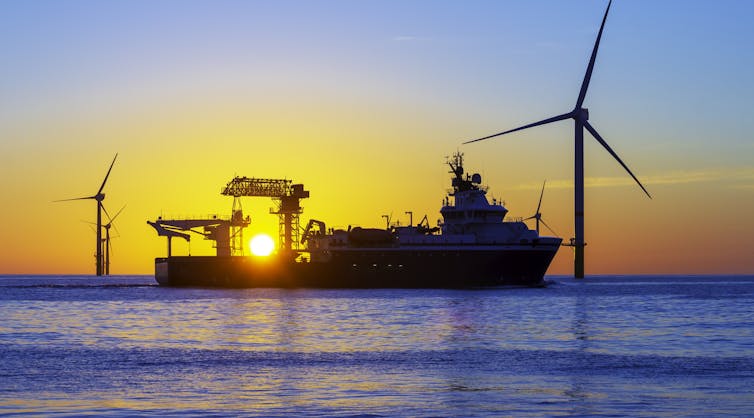
1. Weak protections for the environment
To protect the environment, projects need to create a management plan that complies with requirements under the federal environment law. But this won’t ensure marine life is unharmed by enormous, noisy turbines.
According to a major, independent review earlier this year, Australia’s environment law is outdated and flawed.
Read more: A major report excoriated Australia's environment laws. Sussan Ley's response is confused and risky
It only addresses select environmental issues. The law is far too broad to deal with the unique requirements of offshore wind turbines, which Australian waters have never experienced before.
For example, under the bill’s broad management plan requirements, many environmental issues such as underwater noise and impacts on fish spawning would likely not be addressed.
Compare this to jurisdictions in the North Sea. In the UK, offshore wind projects require a thorough strategic environmental assessment, detailing all possible environmental impacts.
2. Native Title holders lose out
Offshore energy project developers are prohibited from interfering with Native Title rights and interests. But the bill allows interference if it’s “necessary” for the for the “reasonable exercise” of project rights and obligations.
This raises a critical question — what is considered “necessary” and “reasonable”?
This vague wording could see projects go ahead when it conflicts with Aboriginal and Torres Strait Islander communities and their Native Title rights.
Read more: Why most Aboriginal people have little say over clean energy projects planned for their land
3. Inadequate safety provisions
Offshore wind energy development holds inherent risks, such as transporting and constructing wind turbine components in hazardous environments, which are often subject to extreme weather. Without a solid safety framework, construction may lead to injuries or deaths, similar to those that have occurred in the North Sea.
Under the new legislation, the National Offshore Petroleum Safety and Environmental Management Authority (NOPSEMA) would be appointed as the offshore wind regulator. NOPSEMA would oversee safety using the generic Work, Health and Safety Act 2011.
But the bill says parts of the Work, Health and Safety Act will need to be modified so they’re “fit for purpose”. It would require extra provisions, exclusions and workarounds, making the assurance of structures difficult.
Compare this to offshore petroleum operations, which get a bespoke safety framework , one NOPSEMA is already familiar with. Why isn’t one put in place for offshore wind farms?
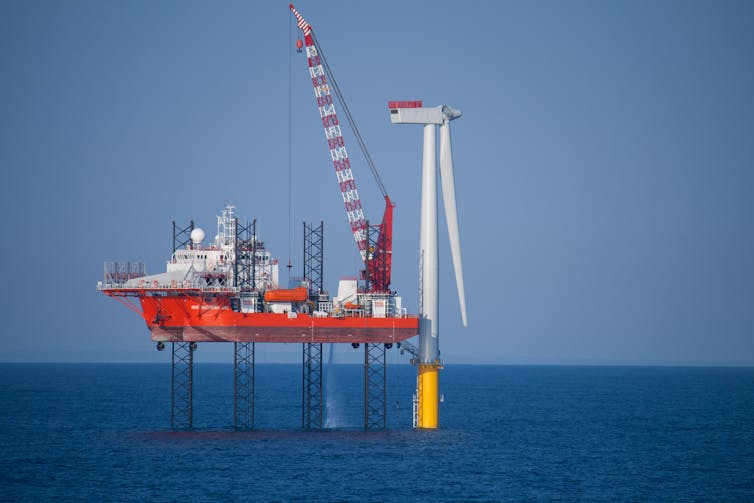
4. It may leave the community behind
In Denmark, offshore wind turbines are located less than 16 kilometres from the coastline. They’re obliged to offer at least 20% of ownership shares to local citizens.
But under Australia’s proposed bill, there are no explicit community benefit schemes. This is an important omission, because creating laws to increase community participation and engagement could reduce any risk of “not in my backyard” (Nimbyism) attitudes. It would also ensure hosting communities are actively involved early and frequently throughout the lifecycle of offshore wind projects.
In crafting best practice regulation coupled with community benefit schemes, the opportunities are limitless. A first step could be to create further public submission opportunities for communities to comment on the bill.
Offshore wind is our golden ticket to a reliable, affordable, and clean energy future. Investing in the offshore wind industry is a no-brainer for Australia, but it needs to be done right.
Read more: A '100% renewables' target might not mean what you think it means. An energy expert explains ![]()
Madeline Taylor, Senior Lecturer, Macquarie University and Tina Soliman Hunter, Professor of Energy and Natural Resources Law, Macquarie University
This article is republished from The Conversation under a Creative Commons license. Read the original article.
Photos from the field: why losing these tiny, loyal fish to climate change spells disaster for coral
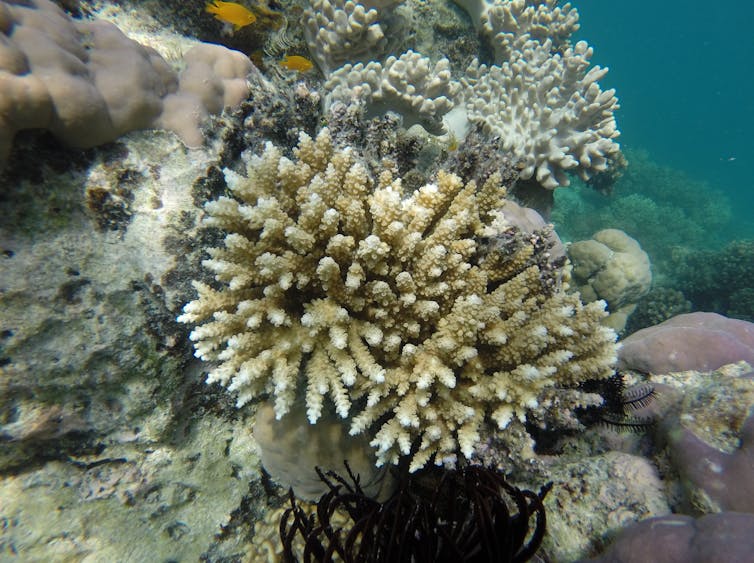
Environmental scientists see flora, fauna and phenomena the rest of us rarely do. In this series, we’ve invited them to share their unique photos from the field.
If you’ve ever dived on a coral reef, you may have peeked into a staghorn coral and seen small fish whizzing through its branches. But few realise that these small fish, such as tiny goby fish, play a crucial role in helping corals weather the storm of climate change.
But alarmingly, our new research found gobies decline far more than corals do after multiple cyclones and heatwaves. This is concerning because such small fish — less than 5 centimetres in length — are critical to coral and reef health.
Unfortunately, the number of cyclones and heatwaves is on the rise. These disasters have begun to occur back-to-back, leaving no time for marine life to recover.
With the recent push by UNESCO to list the Great Barrier Reef as “in danger”, the world is currently on edge about the status of coral reefs. We’re at a critical stage to take all the necessary measures to save coral reefs worldwide, and we must broaden our focus to understand how the important relationships between corals and fish are affected.
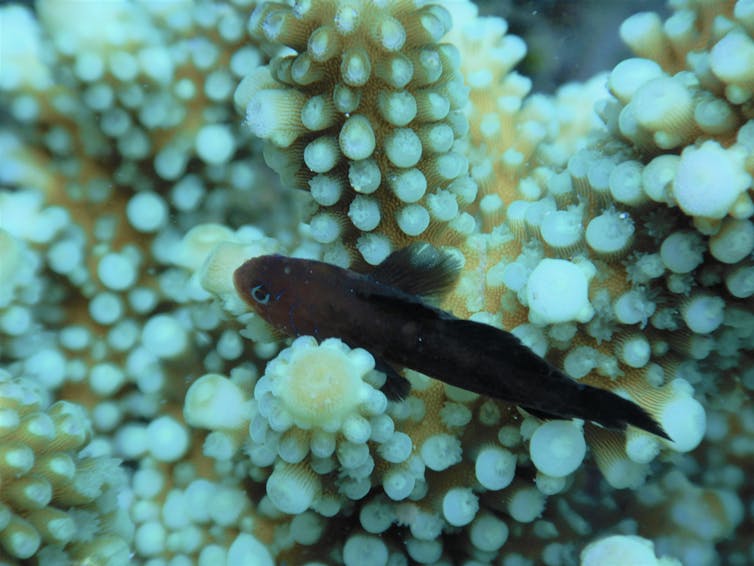
Goby Fish: The Snack-Sized Friends Of Coral
In all environments, organisms can form relationships where they work together to improve each other’s health. This is called a mutual symbiosis, like a you-scratch-my-back principle.
In coral reefs, other examples of mutual symbioses include invisible zooxanthellae algae living within coral tissue, small cleaner fish removing parasites from big fish, and eels and groupers hunting together.
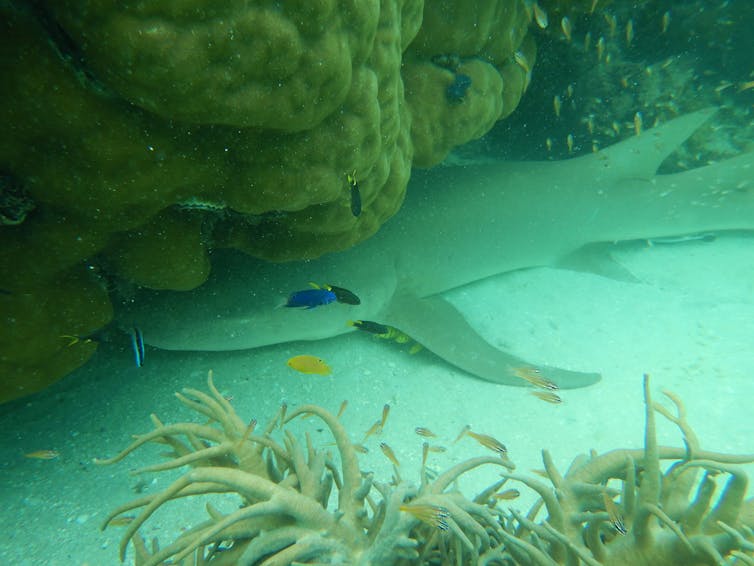
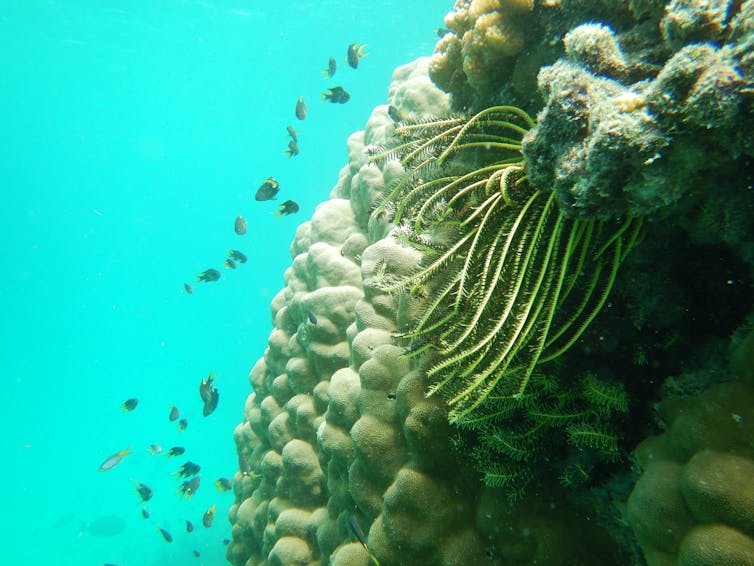
Gobies that live in corals are small, snack-sized fish that rarely venture beyond the prickly borders of their protective coral homes. The Great Barrier Reef is home to more than 20 species of coral gobies, which live in more than 30 species of staghorn corals.
In return for the coral’s protection, the gobies pluck off harmful algae growing on coral branches, produce a toxin to deter potential coral-eating fish, and reduce heat stress by swimming around the coral and stopping stagnant water build up.


Even if their corals become stressed and bleached, they remain steadfast within the coral, helping it to survive. Without their full-time cleaning staff, corals would be more susceptible when threatened with climate change.
Unfortunately, just like Nemos (clownfish) living inside anemones, climate change threatens the mutual symbioses between gobies and corals.
Coral Gobies In Decline
While SCUBA diving, we surveyed corals and their goby friends over a four-year period (2014-17) of near-continuous devastation at Lizard Island, on the Great Barrier Reef. Over this time, two category 4 cyclones and two prolonged heatwaves wreaked havoc on this world-renowned reef.

What we saw was alarming. After the two cyclones, the 13 goby species (genus Gobiodon) and 28 coral species (genus Acropora) we surveyed declined substantially.
But after the two heatwaves, gobies suddenly fared even worse than corals. While some coral species persisted better than others, 78% no longer housed gobies.
Importantly, every single goby species either declined, or worse, completely disappeared. The few gobies we found were living alone, which is especially concerning because gobies breed in monogamous pairs, much like most humans do.
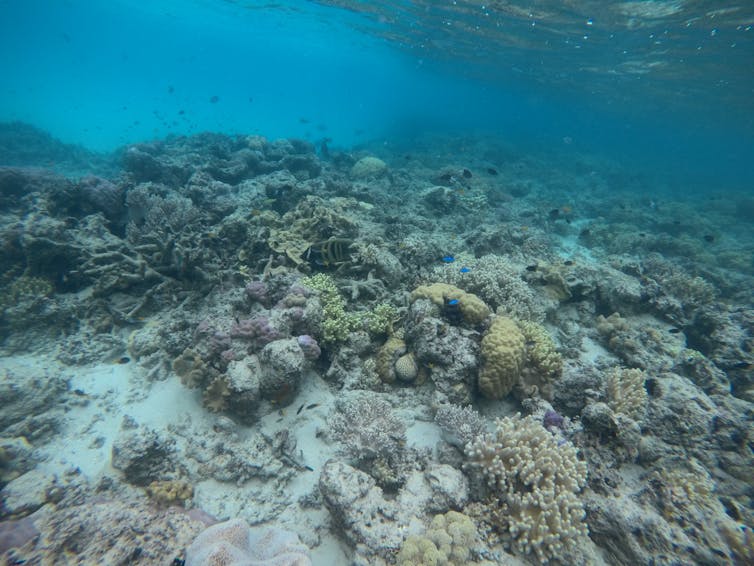
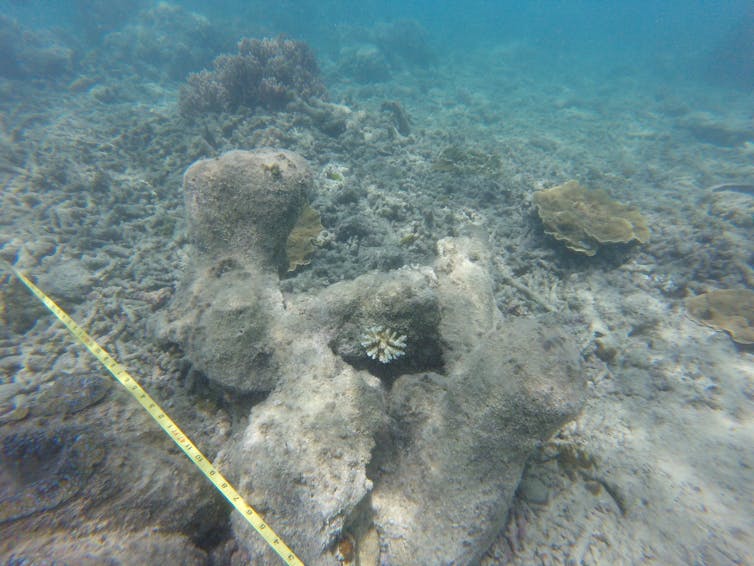
Without Urgent Action, The Outlook Is Bleak
More and more studies are showing reef fish behave differently in warmer and more acidic water.
Warmer water is even changing reef fish on a genetic level. Fish are struggling to reproduce, to recognise what is essential habitat, and to detect predators. Research has shown clownfish, for example, could not tell predatory fish (rockcods and dottybacks) from non-predators (surgeonfishes and rabbitfishes) when exposed to more acidic seawater.
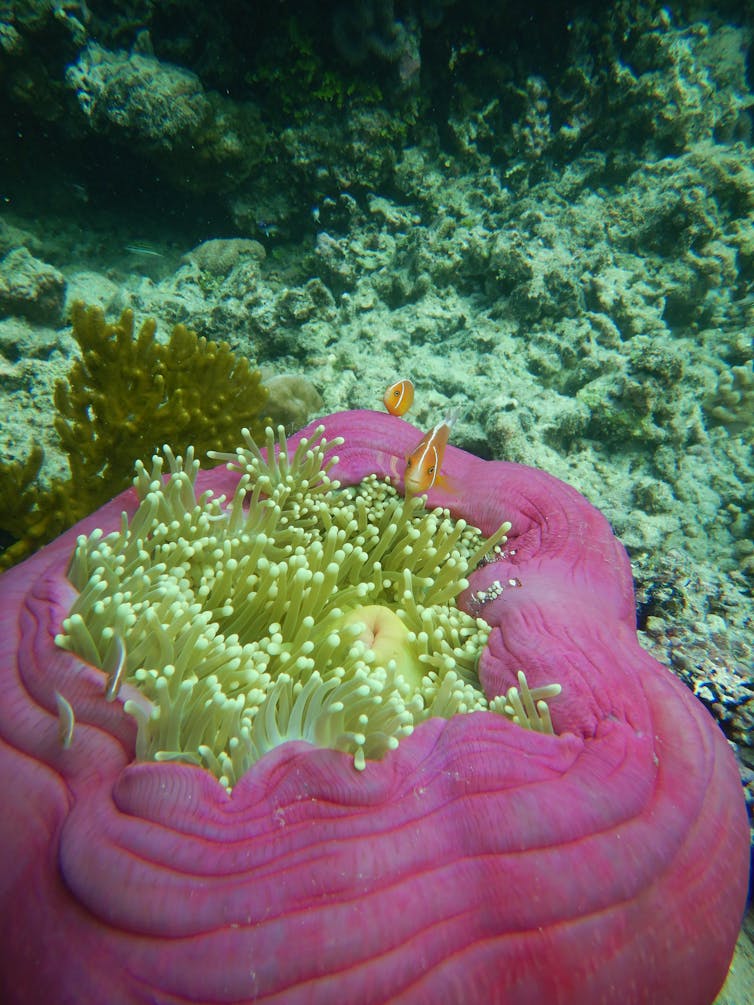
The bigger picture looks bleak. Corals are likely to become increasingly vulnerable if their symbiotic gobies and other inhabitants continue to decline. This could lead to further disruptions in the reef ecosystem because mutual symbioses are important for ecosystem stability.
We need to broaden our focus to understand how animal interactions like these are being affected in these trying times. This is an emerging field of study that needs more research in the face of climate change.
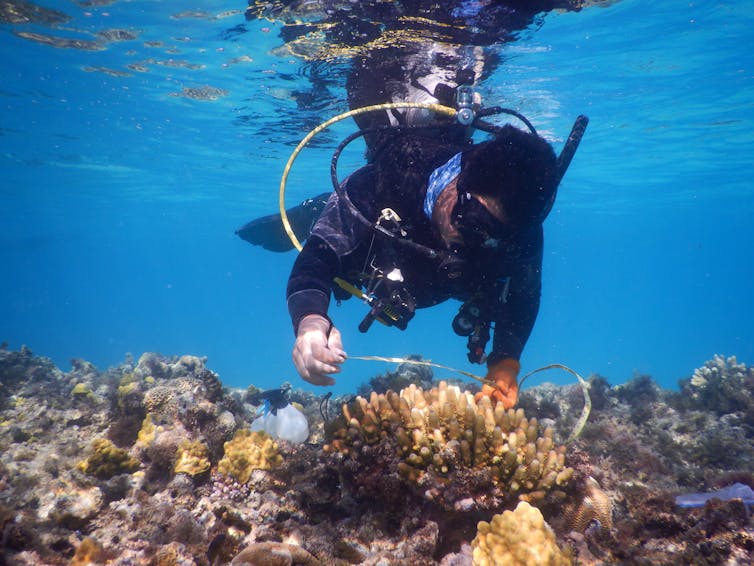
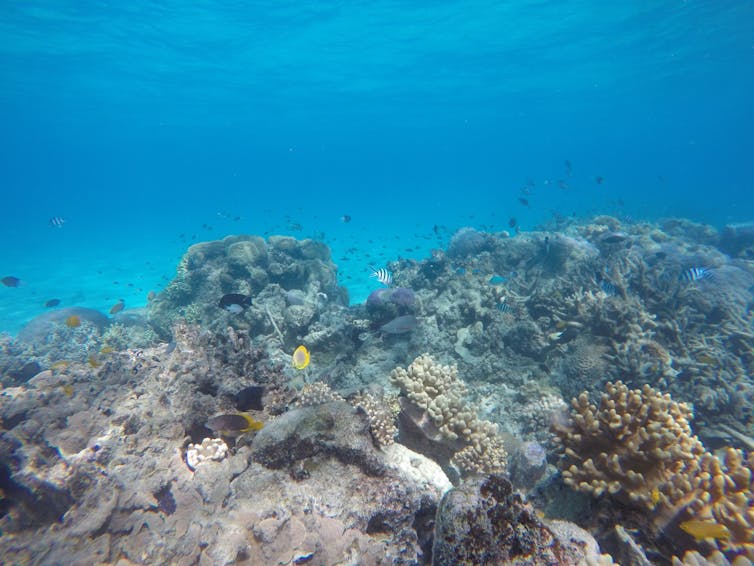
On a global scale, multiple disturbances from cyclones and heatwaves are becoming the norm. We need to tackle the problem from multiple angles. For example, we must meet net zero carbon emissions by 2050 and stop soil erosion and agricultural runoff from flowing into the sea.
If we do not act now, gobies and their coral hosts may become a distant memory in this warming climate.![]()
Catheline Y.M. Froehlich, PhD Fellow, University of Wollongong; Marian Wong, Senior Lecturer, University of Wollongong, and O. Selma Klanten, Research Scientist, University of Technology Sydney
This article is republished from The Conversation under a Creative Commons license. Read the original article.
New research reveals animals are changing their body shapes to cope with climate change
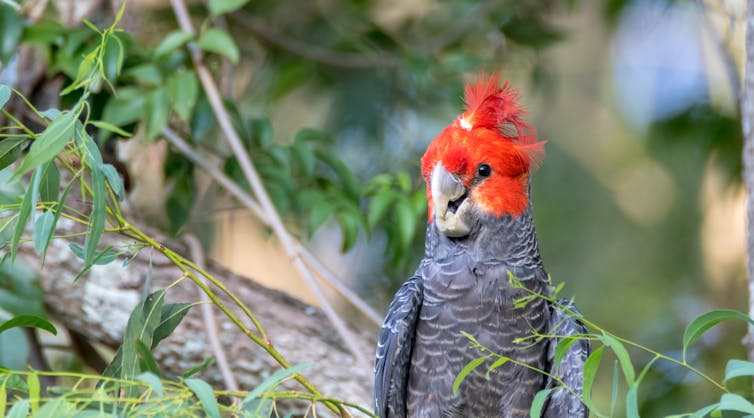
Global warming is a big challenge for warm-blooded animals, which must maintain a constant internal body temperature. As anyone who’s experienced heatstroke can tell you, our bodies become severely stressed when we overheat.
Animals are dealing with global warming in various ways. Some move to cooler areas, such as closer to the poles or to higher ground. Some change the timing of key life events such as breeding and migration, so they take place at cooler times. And others evolve to change their body size to cool down more quickly.
Our new research examined another way animal species cope with climate change: by changing the size of their ears, tails, beaks and other appendages. We reviewed the published literature and found examples of animals increasing appendage size in parallel with climate change and associated temperature increases.
In doing so, we identified multiple examples of animals that are most likely “shape-shifters” – including species in Australia. The pattern is widespread, and suggests climate warming may result in fundamental changes to animal form.
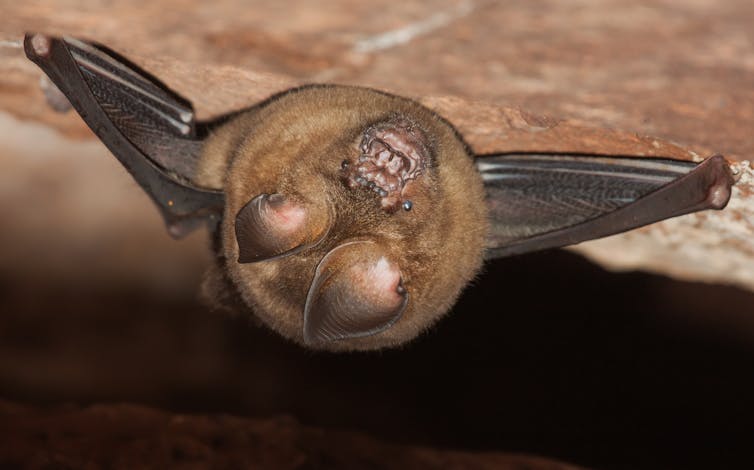
Adhering To Allen’s Rule
It’s well known that animals use their appendages to regulate their internal temperature. African elephants, for example, pump warm blood to their large ears, which they then flap to disperse heat. The beaks of birds perform a similar function – blood flow can be diverted to the bill when the bird is hot. This heat-dispersing function is depicted in the thermal image of a king parrot below, which shows the beak is warmer than the rest of the body.
All this means there are advantages to bigger appendages in warmer environments. In fact, as far back as the 1870s, American zoologist Joel Allen noted in colder climates, warm-blooded animals – also known as endotherms – tended to have smaller appendages while those in warmer climates tend to have larger ones.
This pattern became known as Allen’s rule, which has since been supported by studies of birds and mammals.
Biological patterns such as Allen’s rule can also help make predictions about how animals will evolve as the climate warms. Our research set out to find examples of animal shape-shifting over the past century, consistent with climatic warming and Allen’s rule.
Read more: Photos from the field: why losing these tiny, loyal fish to climate change spells disaster for coral
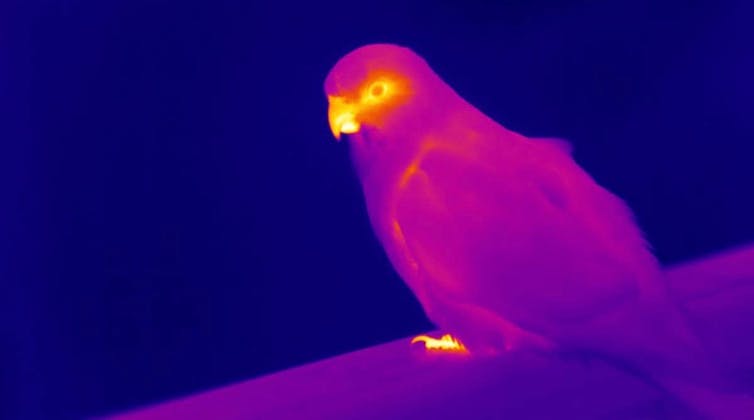
Which Animals Are Changing?
We found most documented examples of shape-shifting involve birds – specifically, increases in beak size.
This includes several species of Australian parrots. Studies show the beak size of gang-gang cockatoos and red-rumped parrots has increased by between 4% and 10% since since 1871.
Mammal appendages are also increasing in size. For example, in the masked shrew, tail and leg length have increased significantly since 1950. And in the great roundleaf bat, wing size increased by 1.64% over the same period.
The variety of examples indicates shape-shifting is happening in different types of appendages and in a variety of animals, in many parts of the world. But more studies are needed to determine which kinds of animals are most affected.

Other Uses Of Appendages
Of course, animal appendages have uses far beyond regulating body temperature. This means scientists have sometimes focused on other reasons that might explain changes in animal body shape.
For example, studies have shown the average beak size of the Galapagos medium ground finch has changed over time in response to seed size, which is in turn influenced by rainfall. Our research examined previously collected data to determine if temperature also influenced changes in beak size of these finches.
These data do demonstrate rainfall (and, by extension, seed size) determines beak size. After drier summers, survival of small-beaked birds was reduced.
But we found clear evidence that birds with smaller beaks are also less likely to survive hotter summers. This effect on survival was stronger than that observed with rainfall. This tells us the role of temperature may be as important as other uses of appendages, such as feeding, in driving changes in appendage size.
Our research also suggests we can make some predictions about which species are most likely to change appendage size in response to increasing temperatures – namely, those that adhere to Allen’s rule.
These include (with some caveats) starlings, song sparrows, and a host of seabirds and small mammals, such as South American gracile opossums.

Read more: We name the 26 Australian frogs at greatest risk of extinction by 2040 — and how to save them
Why Does Shape-Shifting Matter?
Our research contributes to scientific understanding of how wildlife will respond to climate change. Apart from improving our capacity to predict the impacts of climate change, this will enable us to identify which species are most vulnerable and require conservation priority.
Last month’s report by the Intergovernmental Panel on Climate Change showed we have very little time to avert catastrophic global warming.
While our research shows some animals are adapting to climate change, many will not. For example, some birds may have to maintain a particular diet which means they cannot change their beak shape. Other animals may simply not be able to evolve in time.
So while predicting how wildlife will respond to climate change is important, the best way to protect species into the future is to dramatically reduce greenhouse gas emissions and prevent as much global warming as possible.![]()
Sara Ryding, PhD Candidate, Deakin University and Matthew Symonds, Associate professor, Deakin University
This article is republished from The Conversation under a Creative Commons license. Read the original article.
Bushcare In Pittwater
Where we work Which day What time
Avalon
Angophora Reserve 3rd Sunday 8:30 - 11:30am
Avalon Dunes 1st Sunday 8:30 - 11:30am
Avalon Golf Course 2nd Wednesday 3 - 5:30pm
Careel Creek 4th Saturday 8:30 - 11:30am
Toongari Reserve 3rd Saturday 9 - 12noon (8 - 11am in summer)
Bangalley Headland 2nd Sunday 9 to 12noon
Bayview
Winnererremy Bay 4th Sunday 9 to 12noon
Bilgola
North Bilgola Beach 3rd Monday 9 - 12noon
Algona Reserve 1st Saturday 9 - 12noon
Plateau Park 1st Friday 8:30 - 11:30am
Church Point
Browns Bay Reserve 1st Tuesday 9 - 12noon
McCarrs Creek Reserve Contact Bushcare Officer To be confirmed
Clareville
Old Wharf Reserve 3rd Saturday 8 - 11am
Elanora
Kundibah Reserve 4th Sunday 8:30 - 11:30am
 Mona Vale
Mona Vale Mona Vale Beach Basin 1st Saturday 8 - 11am
Mona Vale Dunes 2nd Saturday +3rd Thursday 8:30 - 11:30am
Newport
Bungan Beach 4th Sunday 9 - 12noon
Crescent Reserve 3rd Sunday 9 - 12noon
North Newport Beach 4th Saturday 8:30 - 11:30am
Porter Reserve 2nd Saturday 8 - 11am
North Narrabeen
Irrawong Reserve 2nd Saturday 2 - 5pm
Palm Beach
North Palm Beach Dunes 3rd Saturday 9 - 12noon
Scotland Island
Catherine Park 2nd Sunday 10 - 12:30pm
Elizabeth Park 1st Saturday 9 - 12noon
Pathilda Reserve 3rd Saturday 9 - 12noon
Warriewood
Warriewood Wetlands 1st Sunday 8:30 - 11:30am
Whale Beach
Norma Park 1st Friday 9 - 12noon
Western Foreshores
Coopers Point, Elvina Bay 2nd Sunday 10 - 1pm
Rocky Point, Elvina Bay 1st Monday 9 - 12noon
Gardens And Environment Groups And Organisations In Pittwater
Avalon Golf Course Bushcare Needs You


Pittwater Reserves

New Shorebirds WingThing For Youngsters Available To Download
A Shorebirds WingThing educational brochure for kids (A5) helps children learn about shorebirds, their life and journey. The 2021 revised brochure version was published in February 2021 and is available now. You can download a file copy here.
If you would like a free print copy of this brochure, please send a self-addressed envelope with A$1.10 postage (or larger if you would like it unfolded) affixed to: BirdLife Australia, Shorebird WingThing Request, 2-05Shorebird WingThing/60 Leicester St, Carlton VIC 3053.

 Shorebird Identification Booklet
Shorebird Identification Booklet
The Migratory Shorebird Program has just released the third edition of its hugely popular Shorebird Identification Booklet. The team has thoroughly revised and updated this pocket-sized companion for all shorebird counters and interested birders, with lots of useful information on our most common shorebirds, key identification features, sighting distribution maps and short articles on some of BirdLife’s shorebird activities.
The booklet can be downloaded here in PDF file format: http://www.birdlife.org.au/documents/Shorebird_ID_Booklet_V3.pdf
Paper copies can be ordered as well, see http://www.birdlife.org.au/projects/shorebirds-2020/counter-resources for details.
Download BirdLife Australia's children’s education kit to help them learn more about our wading birdlife
Shorebirds are a group of wading birds that can be found feeding on swamps, tidal mudflats, estuaries, beaches and open country. For many people, shorebirds are just those brown birds feeding a long way out on the mud but they are actually a remarkably diverse collection of birds including stilts, sandpipers, snipe, curlews, godwits, plovers and oystercatchers. Each species is superbly adapted to suit its preferred habitat. The Red-necked Stint is as small as a sparrow, with relatively short legs and bill that it pecks food from the surface of the mud with, whereas the Eastern Curlew is over two feet long with a exceptionally long legs and a massively curved beak that it thrusts deep down into the mud to pull out crabs, worms and other creatures hidden below the surface.
Some shorebirds are fairly drab in plumage, especially when they are visiting Australia in their non-breeding season, but when they migrate to their Arctic nesting grounds, they develop a vibrant flush of bright colours to attract a mate. We have 37 types of shorebirds that annually migrate to Australia on some of the most lengthy and arduous journeys in the animal kingdom, but there are also 18 shorebirds that call Australia home all year round.
What all our shorebirds have in common—be they large or small, seasoned traveller or homebody, brightly coloured or in muted tones—is that each species needs adequate safe areas where they can successfully feed and breed.
The National Shorebird Monitoring Program is managed and supported by BirdLife Australia.
This project is supported by Glenelg Hopkins Catchment Management Authority and Hunter Local Land Services through funding from the Australian Government’s National Landcare Program. Funding from Helen Macpherson Smith Trust and Port Phillip Bay Fund is acknowledged.
The National Shorebird Monitoring Program is made possible with the help of over 1,600 volunteers working in coastal and inland habitats all over Australia.
The National Shorebird Monitoring program (started as the Shorebirds 2020 project initiated to re-invigorate monitoring around Australia) is raising awareness of how incredible shorebirds are, and actively engaging the community to participate in gathering information needed to conserve shorebirds.
In the short term, the destruction of tidal ecosystems will need to be stopped, and our program is designed to strengthen the case for protecting these important habitats.
In the long term, there will be a need to mitigate against the likely effects of climate change on a species that travels across the entire range of latitudes where impacts are likely.
The identification and protection of critical areas for shorebirds will need to continue in order to guard against the potential threats associated with habitats in close proximity to nearly half the human population.
Here in Australia, the place where these birds grow up and spend most of their lives, continued monitoring is necessary to inform the best management practice to maintain shorebird populations.
BirdLife Australia believe that we can help secure a brighter future for these remarkable birds by educating stakeholders, gathering information on how and why shorebird populations are changing, and working to grow the community of people who care about shorebirds.
To find out more visit: http://www.birdlife.org.au/projects/shorebirds-2020/shorebirds-2020-program
Aussie Bread Tags Collection Points

Full HSC To Go Ahead
September 10, 2021
Minister for Education Sarah Mitchell today announced that students will be able to sit their HSC exams and receive their results in time for university offers to be made.
The NSW Education Standards Authority (NESA) has issued a revised timetable, with 110 exams taking place over 19 days, ending on December 3rd.
Students will receive their ATARs on 20 January 2022, with their HSC results released on 24 January.
Ms Mitchell said that after a disruptive and stressful year, students now have the certainty of the timetable and eight weeks to focus on preparing for their exams.
“Being able to sit all their exams safely is the best and fairest outcome for our HSC students,” Ms Mitchell said.
“Whether our students go on to university, vocational training or take on employment, it is important all of them are able to sit their exams and demonstrate what they know.
“I know that teachers, families and friends are supporting our HSC students every step of the way, and that the whole NSW community is wishing them well after a tough 18 months.”
Chair of the NESA Board Professor Peter Shergold said that providing a fair, equitable and safe opportunity for students to receive the HSC in 2021 continues to be at the forefront of every decision made by NESA.
“Revising the timetable to start on 9 November and deliver results on 24 January required the reconfiguration of a massive logistical operation involving over 100,000 people,” Professor Shergold said.
“I am grateful to the NSW Vice Chancellors Committee and the Universities Admission Centre (UAC) for their support, and for working with us to deliver an outcome which will see students receive their results and their university offers in a timely way.”
Strict COVID safe protocols supported by NSW Health will be in place to protect students, exam supervisors and school staff when HSC exams start on November 9 2021.
The protocols for a COVID-safe HSC require exam supervisors to be fully vaccinated and strongly encourage eligible HSC students to receive two vaccine doses before exams start.
Other safety measures include:
- Mandatory face masks for students and staff, indoors and outdoors
- Check-in and health screening protocols for students and staff
- Physical distancing between students and staff at all times
- Minimising mingling of student groups
- Keeping exam group sizes as small as possible
- Desks spaced a minimum of 1.5 metres apart and exam rooms well ventilated
- Hygiene marshals and regular cleaning of exam rooms.
An illness and misadventure process is available for students who are unable to attend an exam due to having a positive COVID-19 test result, or being a close contact.
68,710 students are on track to receive the HSC in 2021, according to the HSC Enrolment Snapshot which will be released on Monday by NESA.
View the 2021 HSC exam timetable: https://educationstandards.nsw.edu.au/wps/portal/nesa/11-12/hsc/key-dates-exam-timetables/hsc-written-exam-timetable
Celebrating 20 Years Of Young Writers
September 7, 2021
The creativity of Extension English 2 students from last year’s HSC is showcased in a newly released anthology.

Complex story: Included in the anthology is Sienna Baker, from Randwick Girls High School.
As the Young Writers Showcase enters its 20th year, 18 impressive young writers from the 2020 HSC are being celebrated for their outstanding talents in writing.
Minister for Education Sarah Mitchell said over the past two decades, the Showcase had given audiences the opportunity to celebrate the gifts and creativity of HSC English Extension 2 students.
“For many of the students whose work is published, this is just the beginning of their wonderful journey into creativity, storytelling and production,” Ms Mitchell said.
“The depth and breadth of work we see in the annual anthology is truly remarkable – the pieces not only showcase students’ impressive writing ability, but also their view of the world, their values, and what’s important to them.”
Over the years, Young Writers has showcased more than 340 students’ work, with many going on to use the skills they developed in the classroom in their future endeavours, including script writing, storytelling, podcasting and more.
Former Sydney Girls High student Nieshanka Nanthakrishnakumar had her major work published as part of NESA’s Young Writers Showcase anthology in 2018, and said it gave her the confidence to pursue her passion in slam poetry.
Ms Nanthakrishnakumar has since gone on to perform at the Sydney Writers Festival, Vivid's 'I'm Not Racist, But....' comedy festival, the 2019 Melbourne Spoken Word Festival and the National Poetry Slam Australia.
“Being published straight out of school gave me the confidence I was initially lacking as a writer. As cliché as it sounds, it was one of the first times I felt 'seen' and it was extremely validating to know that people appreciated my work and wanted to hear what I had to say, especially as a person of colour artist,” Ms Nanthakrishnakumar said.
“It demonstrated what I was capable of and encouraged me to seek new prospects. To this day, high school students who have read my piece in Young Writers, tell me that my work really resonated with them. It's exciting to know that my work is out there in the world to be accessed and appreciated by others. It's also pretty cool to be able to say you are a 'published' poet.”
The young writers to feature in this years’ showcase have been selected from more than 1,385 students who studied HSC English Extension 2 in 2020.
The Young Writers Showcase is usually launched at WordeXpress, a partnership between the State Library of NSW and NESA. Due to COVID restrictions, it will go ahead online this year.
Dr John Vallance, State Librarian at the State Library, said despite not being able to celebrate with the students in person, the public would still have the opportunity to witness the talented writers’ work.
“If the young writers in this year’s 20th anniversary showcase keep writing after they leave school, Australia’s literary culture will be very bright. The State Library is here to encourage them all to do just that,” Dr Vallance said.
The State Library will also offer workshops for current students and publish the students’ reflections statements so that future English Extension 2 students can see how high the standard is.
You can read about the young writers who are included in this year’s and the works they have created on the NSW Education Standards Authority website.
After Dark Photo Competition: Northern Beaches
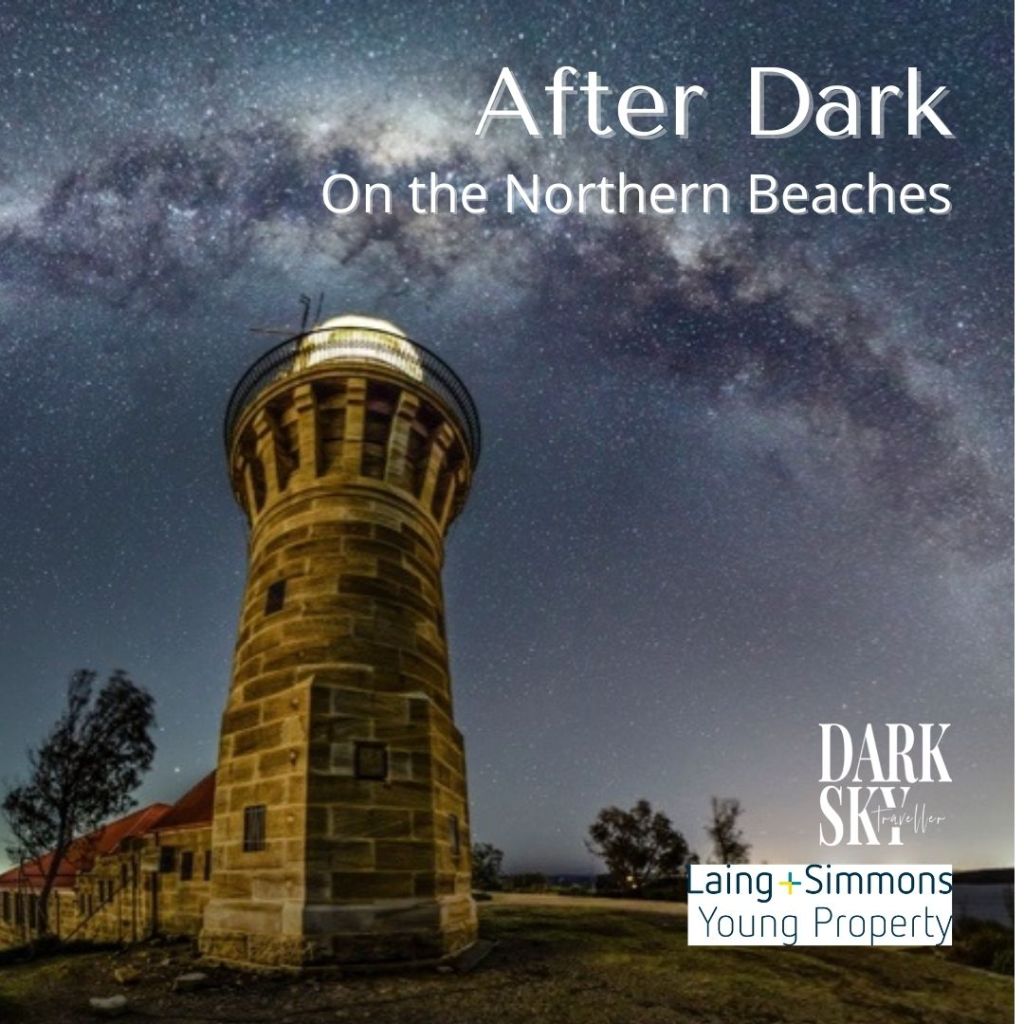 The Northern Beaches are one of the best places in Sydney to view the night sky and appreciate this wonderful asset.
The Northern Beaches are one of the best places in Sydney to view the night sky and appreciate this wonderful asset.Details
- Land – manmade and/or natural formations, wildlife, flora or fauna
- Sea – waterways, beaches, or marine areas, sea life
- Sky – aspects of the night sky, moon, starscapes, clouds or wildlife
- Junior – under 16 years featuring any one of these categories.
- Entry fees are $10 for the first category entered and $10 for each subsequent category entered.
- Up to six entries per category are permitted.
- Fees should be paid by the PayPal gateway on the entry website. Credit and debit cards can be used on this gateway.
- If entry payments are not received by the deadline, then the submitted entries will not be accepted for judging.
- Entries will be accepted only from Australian residents of the Commonwealth of Australia and its Territories.
- There will be two sections of entry – General and Junior (18 or younger)
- There will be three categories of entry for the General Section; Portraying the night time environment featuring Land, Sea or Sky.
- The Junior Section is for photographers 18 years old or younger and will have one open category.
- All entries must be taken within the Northern Beaches LGA and must be taken between sunset and sunrise.
- Images can be taken at any time of the year on or after 1 September 2019.
- The top 5 images of each category will be judged by the organising committee and will be hung at the Studio, Careel Bay Marina for general public display.
- Photographers represented in the top 5 images of each category will be notified that they are in the top 20 images (15 September 17:00 AEST).
- There is a limit of six (6) entries per category per photographer.
- In the case of images with multiple authors, the instigator of the image will be considered to be the principal author and the one who “owns” the image. The principal author MUST have performed the majority of the work to produce the image. All authors MUST be identified and named in the entry form along with their contributions to the production of the image.
- Entries must be in digital form and will be accepted ONLY through submission via the dedicated website at: afterdark.myphotoclub.com.au
- To preserve anonymity, the submitted image files should not contain identifying metadata.
- For judging purposes, still images must be submitted as JPG files with the longest side having a dimension no greater than 4,950 pixels in Adobe 1998 colour space.
- All photographs must have been taken no more than 2 years before the closing date of entry.
- Entry fees are $20 for the first entry and $10 each subsequent entry. Fees should be paid by the PayPal gateway on the entry website. Credit and debit cards can be used on this gateway.
- If entry payments are not received by the deadline, then the submitted entries will not be accepted for judging.
- Photographers of the top 20 images (5 in each category) will be notified 15 September and images printed, framed and hung by the organising. Artists may choose to pay $55 for this service to be undertaken on their part or undertake printing and framing at their own cost. Images must be ready for hanging 17:00 (AEST) 29 September 2021.
- Images will be listed on sale during the exhibition at the artist’s discretion. $100 of the sale will be donated to the charity the Australasian Dark Sky Alliance.
- Winners for the Land Scape, Sea Scape, Sky Scape and Youth entry will be announced Thursday 30th September 2021.
- People’s choice will confirmed by popular vote throughout the exhibition and will be announced on Saturday 30 October, 2021.
- Submissions close at 24:00 (AEST) on Wednesday, 1 September 2021. No entries will be accepted past this date.
- All winners should make an effort to attend the presentation of the awards on 30 September 2021
- The winning entries will be exhibited for the entire Exhibition After Dark, at the Studio, Careel Bay Marina between 30 September and 2 November, 2021.
- Permission to reproduce entries for publication to promote the competition and exhibitions and dark sky-related events and activities on the northern beaches will be assumed as a condition of entry. The copyright of the image remains with the author, and we will try to ensure that the author is credited where the image is used.
- All entries must be true images, faithfully reflecting and maintaining the integrity of the subject. Entries made up of composite images taken at different times and/or at different locations and/or with different cameras will not be accepted. Image manipulations that produce works that are more “digital art” than true astronomical images, will be deemed ineligible. If there is any doubt about the acceptability of an entry, then the competition organisers should be contacted, before the entry is submitted, for adjudication on the matter at the following email address: marnie@darkskytraveller.com.au
- If after the judging process, an image is subsequently determined to have violated the letter and/or the spirit of the rules, then that image will be disqualified. Any prizes consequently awarded for that image must be returned to the competition organisers.
- The competition judges reserve the right to reject any entry that, in the opinion of the judges, does not meet the conditions of entry or is unsuitable for public display. The judges’ decisions will be final.
- Submission of an entry implies acceptance of all the conditions of entry and the decisions of the competition judges.
- Entries Open: 24:00 (AEST) Sunday, 11 July 2021
- Entries Close: 24:00 (AEST) Wednesday, 1 September 2021
- Top 20 announced: 17:00 Wednesday, 15 September 2021
- Photography bump in: Midday Wednesday 29 September 2021
- Exhibition Launch and Presentation of Awards: Thursday 30 September 2021
- Bump out – 2 November 2021
- Category Winner: An image deemed to be the best in that category as judged by the judging panel.
- “The People’s Choice”: This will be judged by gathering votes obtained in the exhibition venue, and online.
- Category Winner: $200 – to each of the image deemed to be the best in each of the four (4) category.
- “The People’s Choice”: $200 – will be judged by gathering votes obtained in the exhibition venue, and online.
Award Winning CGI 3D Animated Short Film: "The Legend Of The Crabe Phare" - By Crabe Phare
A Graduation film by The talented Crabe Phare Team produced at SUPINFOCOM Valenciennes.
Co-Directed by :
Gaëtan BORDE, cargocollective.com/gaetanborde
Benjamin LEBOURGEOIS, lebourgeois-b.com
Alexandre VEAUX, alexv-portfolio.com
Mengjing YANG, catherine_sh@163.com
Claire VANDERMEERSCH. cargocollective.com/cleo2015
Original Soundtrack :
Valentin LAFORT http://www.valentinlafort.com/
Voice actor :
Andy DUPONT
End Title
Julien Loth
AWARDS :
Prix du Public - Panam Anim 2015
Prix du Public - Courts Devant 2015
Best Student Project - Siggraph 2016
Best Student Film - Anim’est 2016
Best 3D Animation Movie - Effets Stars 2016
Best European Student Film - Anim!Arte 2016
2nd Best International Student Film - Anim!Arte 2016
Prix du Public - Festival du Film Environnemental 2016
Prix Jeune Public - RISC 2016
Mention Spéciale - Plein la Bobine 2016
Special Mention - Multivision 2016
Prix du Jury Jeune - Savigny 2017
Audience Award - Cryptshow 2017
You can contact/follow us, on the facebook page : facebook.com/crabephare
John Lennon’s Imagine At 50: A Deceptively Simple Ballad, A Lasting Emblem Of Hope
September 9, 2021
by Leigh Carriage, Senior Lecturer in Music, Southern Cross University
1971 was a tumultuous year. The counter-cultural movement of the 60s was still being felt. Demonstrations were held opposing the Vietnam War and in August, Australia and New Zealand withdrew their troops.
Apollo 15 landed on the moon. Feminist Gloria Steinem made her first address to women in America. Switzerland held a referendum on women’s suffrage. In New York, John Lennon sat down at a brown model Z upright piano and began to write what would become an inter-generational, transnational phenomenon — and perhaps the gentlest of protest songs — Imagine.
Imagine was recorded on May 27, at Lennon’s new home studio. The song was released to the world as part of the album of the same name (co-produced by Lennon, his wife Yoko Ono and Phil Spector), on September 9.
For three minutes and three seconds, the lyrics of this gentle ballad present a vision of unity and of hope. It is a space in which to dream of real change in the world.
As with all songs, the interpretations are as broad as the listeners. For many, it is a call for peace; for others it is a prayer.
The verse lyrics, partly based on poetry by Ono, remove all the central components that seem to separate us: violence, hate, borders, poverty, greed, governments, religion, consumerism and capitalism.
The final verse offers a vision of a unified world at peace.
You may say I’m a dreamer
But I’m not the only one
I hope someday you’ll join us
And the world will live as one
Imagine would become Lennon’s best-selling single of his solo career. In 2004, Rolling Stone labelled it third on its list of the greatest songs of all time, saying “we need it more than he ever dreamed”.
Unpacking it musically
Imagine is often used to teach beginner music students, but it would be a mistake to think it is just a simple, soft rock, piano ballad.
This perception is due to Lennon’s highly effective crafting. As a peace anthem, the song appears simple, but dig a little deeper, and you find layers of complexity and nuance.
Imagine was written in the key of C major, which has no sharps or flats, so it is melodically and harmonically playable and broadly accessible.
The melody is comprised of small intervals (the difference in pitch between two notes), and repeating small motives (a fragment of melody repeated, manipulated or re-positioned throughout the melody), all within a singable range of one octave.
The introduction to the song sets up a gentle sway between harmonic resolution and tension, like waves on a beach.
The third, longer phrase (“Imagine all the people”) steps into a passage of unresolved tension. This culminates in a harmonic state of balance, like a broom standing on end. It can fall either way — forward into resolution (the next verse) or back into tension (the chorus). This balance is intensified as the rhythm section pauses and Lennon sings in falsetto.
Imagine there’s no heaven
It’s easy if you try
No hell below us
Above us, only sky
Imagine all the people
Livin’ for today
The opening piano chords also create a sense of pushing into tension before falling back to resolution, linking to the dreamlike feeling of the lyrics. The third phrase, “imagine all the people” starts on the four chord and holds that tension until “living for today” lands on G, creating more stability.
Perhaps the most distinctive part of Imagine is the short piano riff between the vocal lines. This riff uses just three notes — A, A# and B — called “chromatic passing notes”. Your ear thinks these notes will go up again, to the C chord. Instead, Lennon brings the listener’s ear down to the G melody note, creating a gentle sense of unpredictability.
Imagine transports the listener. The lyrics lift the spirit. The easy rises and falls of the melody comfort. Lennon’s familiar voice reassures.
A balm in times of crisis
Imagine has inspired an outstanding array of cover versions, sung by everyone from Elton John to Madonna. American singer Eva Cassidy’s interpretation remains a particular favourite. Her expression and subtle reinterpretation of the melody, her note choices and phrasing, are breathtaking.
At times of crisis, people have often turned to this song. Queen covered Imagine the day after Lennon’s death in 1980; Neil Young played it in the wake of 9/11.
After the 2015 terrorist attacks in Paris, people gathered on the streets as a man quietly played the song on a piano decorated with a peace symbol.
In March last year, at the beginning of the pandemic, Gal Gadot and other celebrities released a now ironically celebrated and much criticised version.
And last September, Melbourne students wrote their own version:
Imagine there’s no Corona
And we can see our friends
Our interconnectedness and reliance on one another are our biggest strengths. 50 years after Lennon wrote the song, Imagine will accompany us along the way: a lasting emblem of hope.
2021 Surfing NSW Event Update
September 10, 2021
Due to the rapidly shifting COVID-19 pandemic and the current public health order in NSW, Surfing NSW has made the hard decision to cancel or postpone all of October's events until a later in 2021.
After consultation with all event stakeholders, local councils, Office or Sport and NSW Sport, the following events will be impacted:
October Events
Woolworths Surfer Grom Comp // Northern Beaches 9-10 October (postponed)
The event will be moved to 11th -12th December 2021.
Havaianas NSW Grommet State Titles // 22-25 October (cancelled)
The Under-14’s division from the Havaianas NSW Grommet State Titles, will move to the Woolworths NSW Junior State Titles at Illawarra and form a part of the event schedule. Unfortunately, the Havaianas NSW Grommets State Titles event has had to be cancelled as there are no further available dates at Maroubra to run the competition in line with our entire NSW calendar of events. We look forward to bringing back this event in 2022. The Under-12’s divisions are encouraged to enter the Woolworths Surfer Grom Comp Series at either Coffs Harbour, Kiama, Cronulla and Northern Beaches.
Woolworths NSW Junior State Titles presented by Ocean and Earth (postponed)
This event will be postponed to a later date in 2021 in Illawarra. This date is to be confirmed upon our next events update on October 6th. The following divisions U14’s, U16’s, U18’s will all compete in this event in a revised straight knock-out format. If the Australian Junior Surfing Titles is cancelled, Surfing NSW will still aim to hold the NSW junior state titles for U18, U16 and U14 divisions in 2021 regardless (pending COVID-19 restrictions and timeframes at the time).
NSW High School State Titles at Illawarra (cancelled)
Due to the limited time available and return to school sport uncertainty, unfortunately, the NSW High School State Surfing Titles won’t run for 2021. If the Australian High School Surfing Titles runs for 2021 Surfing NSW will determine a selection process in the near future. This selection process will be confirmed (if required) on October 6th aligned to the next events update.
Volkswagen Tradies Surfmasters (cancelled)
The Volkswagen Tradies Surfmasters event has been unfortunately cancelled as there are no further dates available in 2021 in line with our entire NSW calendar of events. We look forward to bringing back this event in 2022.
Aloha Manly Junior Teams Event pres. by Hurley // Manly, 28 - 29 September (postponed)
The event will be moved to 4-5 December 2021.
The highest priority is the health and safety of all competitors and their families, staff, and event partners, as well as the local community with all event decisions being made.
We will be offering full refunds for those who are affected by the current COVID-19 situation or cannot attend the rescheduled date, however, it is important to note that competitors will lose their spot once a refund has been processed. If they decide to enter the event again at a later date, they will be at the end of the waitlist if it is full.
Surfing NSW is monitoring the evolving COVID-19 situation and will provide all competitors with changes as they come to hand.
The next events update and confirmation of new dates for the Woolworths NSW Junior State Titles will be on Wednesday the 6th of October 2021. We will email, post on socials and our website.
If you would like to process a refund or have a query please email events@surfingnsw.com.au
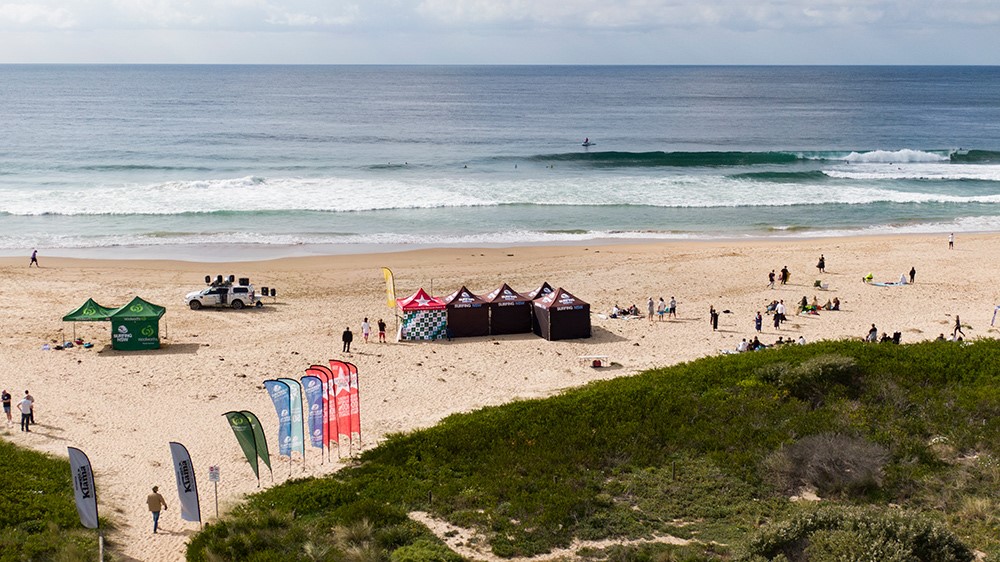
Photo: Ethan Smith / Surfing NSW
NESA Media Statement: HSC Major Projects
- Drama
- Textiles and Design
- Design and Technology
- Industrial Technology
- Visual Arts
- English Extension 2
- Music 1 (compositions)
- Music 2 and Extension (compositions and musicology)
- Society and Culture Personal Interest Project
HSC Online Help Guide
Stay Healthy - Stay Active: HSC 2021

TAFE Fee-Free Online Courses Available For 16-24 Year Olds
- live or work in NSW
- be an Australian Citizen, a permanent resident, a New Zealand citizen, or a humanitarian visa holder
- have left school
- aged from 16 - 24 inclusive, or
- in receipt of a Commonwealth Government benefit, or
- an unemployed person, or
- people expected to become unemployed
A Universal Equation For The Shape Of An Egg
 Researchers from the University of Kent, the Research Institute for Environment Treatment and Vita-Market Ltd have discovered a universal mathematical formula that can describe any bird's egg existing in nature, a feat which has been unsuccessful until now.
Researchers from the University of Kent, the Research Institute for Environment Treatment and Vita-Market Ltd have discovered a universal mathematical formula that can describe any bird's egg existing in nature, a feat which has been unsuccessful until now.
Egg-shape has long attracted the attention of mathematicians, engineers, and biologists from an analytical point of view. The shape has been highly regarded for its evolution as large enough to incubate an embryo, small enough to exit the body in the most efficient way, not roll away once laid, is structurally sound enough to bear weight and be the beginning of life for so many species. The egg has been called the "perfect shape."
Analysis of all egg shapes used four geometric figures: sphere, ellipsoid, ovoid, and pyriform (conical or pear-shaped), with a mathematical formula for the pyriform yet to be derived.
To rectify this, researchers introduced an additional function into the ovoid formula, developing a mathematical model to fit a completely novel geometric shape characterized as the last stage in the evolution of the sphere-ellipsoid, which it is applicable to any egg geometry.
This new universal mathematical formula for egg shape is based on four parameters: egg length, maximum breadth, shift of the vertical axis, and the diameter at one quarter of the egg length.
This long sought-for universal formula is a significant step in understanding not only the egg shape itself, but also how and why it evolved, thus making widespread biological and technological applications possible.
Mathematical descriptions of all basic egg shapes have already found applications in food research, mechanical engineering, agriculture, biosciences, architecture and aeronautics. As an example, this formula can be applied to engineering construction of thin walled vessels of an egg shape, which should be stronger than typical spherical ones.
This new formula is an important breakthrough with multiple applications including:
- Competent scientific description of a biological object. Now that an egg can be described via mathematical formula, work in fields of biological systematics, optimization of technological parameters, egg incubation and selection of poultry will be greatly simplified.
- Accurate and simple determination of the physical characteristics of a biological object. The external properties of an egg are vital for researchers and engineers who develop technologies for incubating, processing, storing and sorting eggs. There is a need for a simple identification process using egg volume, surface area, radius of curvature and other indicators for describing the contours of the egg, which this formula provides.
- Future biology-inspired engineering. The egg is a natural biological system studied to design engineering systems and state-of-the-art technologies. The egg-shaped geometric figure is adopted in architecture, such as London City Hall's roof and the Gherkin, and construction as it can withstand maximum loads with a minimum consumption of materials, to which this formula can now be easily applied.
Darren Griffin, Professor of Genetics in the University of Kent and PI on the research, said: "Biological evolutionary processes such as egg formation must be investigated for mathematical description as a basis for research in evolutionary biology, as demonstrated with this formula. This universal formula can be applied across fundamental disciplines, especially the food and poultry industry, and will serve as an impetus for further investigations inspired by the egg as a research object."
Dr Michael Romanov, Visiting Researcher at the University of Kent, said: "This mathematical equation underlines our understanding and appreciation of a certain philosophical harmony between mathematics and biology, and from those two a way towards further comprehension of our universe, understood neatly in the shape of an egg."
Dr Valeriy Narushin, former visiting researcher at the University of Kent, said: "We look forward to seeing the application of this formula across industries, from art to technology, architecture to agriculture. This breakthrough reveals why such collaborative research from separate disciplines is essential."
Valeriy G. Narushin, Michael N. Romanov, Darren K. Griffin. Egg and math: introducing a universal formula for egg shape. Annals of the New York Academy of Sciences, 2021; DOI: 10.1111/nyas.14680
Chicken egg (stock image). Credit: © yuthana Choradet / stock.adobe.com
SpaceX Inspiration4 mission will send 4 people with minimal training into orbit – and bring space tourism closer to reality
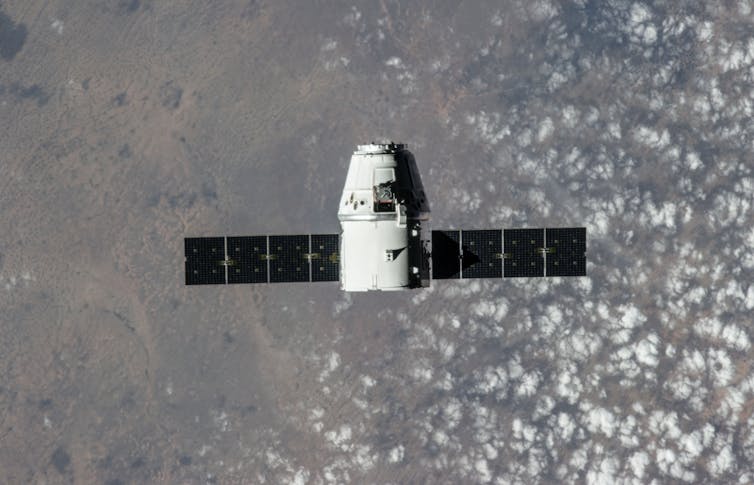
On Sept. 15, 2021, the next batch of space tourists are set to lift off aboard a SpaceX rocket. Organized and funded by entrepreneur Jared Isaacman, the Inspiration4 mission touts itself as “the first all-civilian mission to orbit” and represents a new type of space tourism.
The four crew members will not be the first space tourists this year. In the past few months, the world witnessed billionaires Richard Branson and Jeff Bezos launching themselves and a lucky few others into space on brief suborbital trips. While there are similarities between those launches and Inspiration4 — the mission is being paid for by one billionaire and is using a rocket built by another, Elon Musk — the differences are noteworthy. From my perspective as a space policy expert, the mission’s emphasis on public involvement and the fact that Inspiration4 will send regular people into orbit for three days make it a milestone in space tourism.

Why Inspiration4 Is Different
The biggest difference between Inspiration4 and the flights performed earlier this year is the destination.
Blue Origin and Virgin Galactic took – and in the future, will take – their passengers on suborbital launches. Their vehicles only go high enough to reach the beginning of space before returning to the ground a few minutes later. SpaceX’s Falcon 9 rocket and crew Dragon vehicle, however, are powerful enough to take the Inspiration4 crew all the way into orbit, where they will circle the Earth for three days.
The four-person crew is also quite different from the other launches. Led by Isaacman, the mission features a somewhat diverse group of people. One crew member, Sian Proctor, won a contest among people who use Isaacman’s online payment company. Another unique aspect of the mission is that one of its goals is to raise awareness of and funds for St. Jude Children’s Research Hospital. As such, Isaacman selected Hayley Arceneaux, a physician’s assistant at St. Jude and childhood cancer survivor, to participate in the launch. The final member, Christopher Sembroski, won his seat when his friend was chosen in a charity raffle for St. Jude and offered his seat to Sembroski.
Because none of the four participants has any prior formal astronaut training, the flight has been called the first “all civilian” space mission. While the rocket and crew capsule are both fully automated – no one on board will need to control any part of the launch or landing – the four members still needed to go through much more training than the people on the suborbital flights. In less than six months, the crew has undergone hours of simulator training, lessons in flying a jet aircraft and spent time in a centrifuge to prepare them for the G-forces of launch.
Social outreach has also been an important aspect of the mission. While Bezos’ and Branson’s flights brought on criticism of billionaire playboys in space, Inspiration4 has tried – with mixed results – to make space tourism more relatable. The crew recently appeared on the cover of Time magazine and is the subject of an ongoing Netflix documentary.
There have also been other fundraising events for St. Jude, including a 4-mile virtual run and the planned auction of beer hops that will be flown on the mission.

The Future Of Space Tourism?
Sending a crew of amateur astronauts into orbit is a significant step in the development of space tourism. However, despite the more inclusive feel of the mission, there are still serious barriers to overcome before average people can go to space.
For one, the cost remains quite high. Though three of the four are not rich, Isaacman is a billionaire and paid an estimated $200 million to fund the trip. The need to train for a mission like this also means that prospective passengers must be able to devote significant amounts of time to prepare – time that many ordinary people don’t have.
Finally, space remains a dangerous place, and there will never be a way to fully remove the danger of launching people – whether untrained civilians or seasoned professional astronauts – into space.
[Over 110,000 readers rely on The Conversation’s newsletter to understand the world. Sign up today.]
Despite these limitations, orbital space tourism is coming. For SpaceX, Inspiration4 is an important proof of concept that they hope will further demonstrate the safety and reliability of their autonomous rocket and capsule systems. Indeed, SpaceX has several tourist missions planned in the next few months, even though the company isn’t focused on space tourism. Some will even includes stops at the International Space Station.
Even as space remains out of reach for most on Earth, Inspiration4 is an example of how billionaire space barons’ efforts to include more people on their journeys can give an otherwise exclusive activity a wider public appeal.![]()
Wendy Whitman Cobb, Professor of Strategy and Security Studies, US Air Force School of Advanced Air and Space Studies
This article is republished from The Conversation under a Creative Commons license. Read the original article.
High Court rules media are liable for Facebook comments on their stories. Here’s what that means for your favourite Facebook pages

A publisher can be held responsible for defamatory comments readers leave on its Facebook pages, the High Court ruled today, in a decision that could have far-reaching consequences for social media users throughout Australia.
This decision may mean anyone who runs a social media page can theoretically be sued over disparaging comments posted by readers or random group members — even if you aren’t aware of the comment.
In other words, if you post content on your social media page and encourage or invite comments — and people post defamatory comments there — you’re legally the “publisher” of those comments and can be sued, thanks to today’s ruling.
Today’s case focused on Facebook but the implications are not Facebook-specific. It can apply equally to Twitter, Instagram, and other social media too — or websites (such as The Conversation) that have comments sections.
Facebook and Instagram page administrators can turn off comments altogether, and Twitter allows you to restrict comments so only certain people can post to it.
Today’s ruling may inspire many social media account managers to make greater use of these features and tightly restrict comments — or, where possible, switch them off completely.
Read more: Media companies can now be held responsible for your dodgy comments on social media
Former Don Dale Inmate Dylan Voller And The Comments
Today’s case centres on former Don Dale Youth Detention Centre inmate Dylan Voller, who you might remember as the young man wearing the spit hood in a Four Corners report on conditions in the Northern Territory juvenile justice system.
Three media companies published stories about Voller to their Facebook page, and readers left comments underneath those posts. The media stories themselves were not defamatory but Voller alleged some of those reader comments were, so he sued.
But he didn’t sue the commenters; he sued the media outlets who ran the Facebook pages, arguing they were “publishers” of the comments. Today’s case centred on whether or not the media companies could be defined as “publishers” of comments by readers and other “third party users”.
In 2019, the Supreme Court of New South Wales ruled in Voller’s favour. Justice Rothman held the media companies were indeed “publishers” of the comments from third-party users and were therefore responsible for them.
The media companies appealed, but last year the New South Wales Court of Appeal found again in Voller’s favour. In other words, the Court of Appeal agreed the media outlets were “publishers” of comments by random readers on their Facebook pages.
The decision sent shockwaves through the Australian media, which field countless comments on their social media pages every day. The media publishers appealed to the High Court, which brings us to today. The High Court decided:
The Court of Appeal was correct to hold that the acts of the appellants in facilitating, encouraging and thereby assisting the posting of comments by the third-party Facebook users rendered them publishers of those comments. The appeals should be dismissed with costs.
Five judges ruled in favour of Voller and two dissented (Justice Steward and Justice Edelman). Essentially, Voller won today, the media companies are indeed “publishers” and the media companies have to pay his legal costs.
Today’s ruling doesn’t mark the end of the line for this case.
Now it’s been established the media companies are publishers of the comments, Voller’s defamation case can start in earnest — in other words, it’s still yet to be decided whether or not the comments were in fact defamatory and what defences the media publishers might have under defamation law.
You might be wondering: can the person who posted the comment also be held responsible for their comment, under defamation law?
The answer is yes, they can. But from the perspective of someone suing, it might not be worth going after an individual social media user or a troll, especially if they are using a pseudonym. A plaintiff is more likely to want to go after the media company itself as the publisher, with their deeper pockets.

Broader Implications For Social Media Users
Today’s ruling may mean if you post something to a social media platform and encourage or invite third party comments, you could be liable for any comments that follow. So it could affect individuals, online community groups, neighbourhood Facebook pages, the local P&C Facebook page, and so on.
One of the interesting things about the Voller case is his legal team sued straight away — they didn’t issue a concerns notice first (which is basically a legal letter sent to the person or organisation alleged to have made the defamatory comments, giving them a chance to respond).
That wouldn’t be allowed now. Under new defamation laws that came into effect this July in NSW, Victoria, South Australia Queensland and the ACT, plaintiffs must now serve a concerns notice on each defendant and wait at least a fortnight before suing.
Those same reforms also introduced what’s called a “serious harm threshold”. Under this rule, the plaintiff has to prove they have, in fact, suffered (or are likely to suffer) serious harm to their reputation as a result of the published comments.
This clause aims to rule out trivial defamation cases because while it’s true anyone can cause serious harm to a person’s reputation on social media, there is also a lot of banter and to-ing and fro-ing which might be offensive but might not cause serious harm to a reputation. This may give some protection to admins of social media pages in future, particularly private individuals.
Read more: The policing of Australian satire: why defamation is still no joke, despite recent law changes ![]()
David Rolph, Professor of Law, University of Sydney
This article is republished from The Conversation under a Creative Commons license. Read the original article.
How ‘engagement’ makes you vulnerable to manipulation and misinformation on social media

Facebook has been quietly experimenting with reducing the amount of political content it puts in users’ news feeds. The move is a tacit acknowledgment that the way the company’s algorithms work can be a problem.
The heart of the matter is the distinction between provoking a response and providing content people want. Social media algorithms – the rules their computers follow in deciding the content that you see – rely heavily on people’s behavior to make these decisions. In particular, they watch for content that people respond to or “engage” with by liking, commenting and sharing.
As a computer scientist who studies the ways large numbers of people interact using technology, I understand the logic of using the wisdom of the crowds in these algorithms. I also see substantial pitfalls in how the social media companies do so in practice.
From Lions On The Savanna To Likes On Facebook
The concept of the wisdom of crowds assumes that using signals from others’ actions, opinions and preferences as a guide will lead to sound decisions. For example, collective predictions are normally more accurate than individual ones. Collective intelligence is used to predict financial markets, sports, elections and even disease outbreaks.
Throughout millions of years of evolution, these principles have been coded into the human brain in the form of cognitive biases that come with names like familiarity, mere-exposure and bandwagon effect. If everyone starts running, you should also start running; maybe someone saw a lion coming and running could save your life. You may not know why, but it’s wiser to ask questions later.
Your brain picks up clues from the environment – including your peers – and uses simple rules to quickly translate those signals into decisions: Go with the winner, follow the majority, copy your neighbor. These rules work remarkably well in typical situations because they are based on sound assumptions. For example, they assume that people often act rationally, it is unlikely that many are wrong, the past predicts the future, and so on.
Technology allows people to access signals from much larger numbers of other people, most of whom they do not know. Artificial intelligence applications make heavy use of these popularity or “engagement” signals, from selecting search engine results to recommending music and videos, and from suggesting friends to ranking posts on news feeds.
Not Everything Viral Deserves To Be
Our research shows that virtually all web technology platforms, such as social media and news recommendation systems, have a strong popularity bias. When applications are driven by cues like engagement rather than explicit search engine queries, popularity bias can lead to harmful unintended consequences.
Social media like Facebook, Instagram, Twitter, YouTube and TikTok rely heavily on AI algorithms to rank and recommend content. These algorithms take as input what you “like,” comment on and share – in other words, content you engage with. The goal of the algorithms is to maximize engagement by finding out what people like and ranking it at the top of their feeds.
On the surface this seems reasonable. If people like credible news, expert opinions and fun videos, these algorithms should identify such high-quality content. But the wisdom of the crowds makes a key assumption here: that recommending what is popular will help high-quality content “bubble up.”
We tested this assumption by studying an algorithm that ranks items using a mix of quality and popularity. We found that in general, popularity bias is more likely to lower the overall quality of content. The reason is that engagement is not a reliable indicator of quality when few people have been exposed to an item. In these cases, engagement generates a noisy signal, and the algorithm is likely to amplify this initial noise. Once the popularity of a low-quality item is large enough, it will keep getting amplified.
Algorithms aren’t the only thing affected by engagement bias – it can affect people, too. Evidence shows that information is transmitted via “complex contagion,” meaning the more times someone is exposed to an idea online, the more likely they are to adopt and reshare it. When social media tells people an item is going viral, their cognitive biases kick in and translate into the irresistible urge to pay attention to it and share it.
Not-So-Wise Crowds
We recently ran an experiment using a news literacy app called Fakey. It is a game developed by our lab, which simulates a news feed like those of Facebook and Twitter. Players see a mix of current articles from fake news, junk science, hyper-partisan and conspiratorial sources, as well as mainstream sources. They get points for sharing or liking news from reliable sources and for flagging low-credibility articles for fact-checking.
We found that players are more likely to like or share and less likely to flag articles from low-credibility sources when players can see that many other users have engaged with those articles. Exposure to the engagement metrics thus creates a vulnerability.
The wisdom of the crowds fails because it is built on the false assumption that the crowd is made up of diverse, independent sources. There may be several reasons this is not the case.
First, because of people’s tendency to associate with similar people, their online neighborhoods are not very diverse. The ease with which a social media user can unfriend those with whom they disagree pushes people into homogeneous communities, often referred to as echo chambers.
Second, because many people’s friends are friends of each other, they influence each other. A famous experiment demonstrated that knowing what music your friends like affects your own stated preferences. Your social desire to conform distorts your independent judgment.
Third, popularity signals can be gamed. Over the years, search engines have developed sophisticated techniques to counter so-called “link farms” and other schemes to manipulate search algorithms. Social media platforms, on the other hand, are just beginning to learn about their own vulnerabilities.
People aiming to manipulate the information market have created fake accounts, like trolls and social bots, and organized fake networks. They have flooded the network to create the appearance that a conspiracy theory or a political candidate is popular, tricking both platform algorithms and people’s cognitive biases at once. They have even altered the structure of social networks to create illusions about majority opinions.
[Over 110,000 readers rely on The Conversation’s newsletter to understand the world. Sign up today.]
Dialing Down Engagement
What to do? Technology platforms are currently on the defensive. They are becoming more aggressive during elections in taking down fake accounts and harmful misinformation. But these efforts can be akin to a game of whack-a-mole.
A different, preventive approach would be to add friction. In other words, to slow down the process of spreading information. High-frequency behaviors such as automated liking and sharing could be inhibited by CAPTCHA tests or fees. This would not only decrease opportunities for manipulation, but with less information people would be able to pay more attention to what they see. It would leave less room for engagement bias to affect people’s decisions.
It would also help if social media companies adjusted their algorithms to rely less on engagement to determine the content they serve you.![]()
Filippo Menczer, Luddy Distinguished Professor of Informatics and Computer Science, Indiana University
This article is republished from The Conversation under a Creative Commons license. Read the original article.
The daily dance of flowers tracking the sun is more fascinating than most of us realise

When I was a child, I was intrigued by the Queensland box (Lophostemon confertus) growing in our backyard. I noticed its leaves hung vertical after lunch in summer, and were more or less horizontal by the next morning.
This an example of heliotropism, which literally means moving in relation to the sun. We can see it most clearly as spring arrives and various species burst into flower — you might even get the feeling that some flowers are watching you as they move.
Many of us probably first got to know of heliotropism at home, kindergarten or primary school by watching the enormous yellow and black flowering heads of aptly name sunflowers, which moved as they grew.
These flowers track the course of the sun spectacularly on warm and sunny, spring or summer days. Sometimes they move through an arc of almost 180⁰ from morning to evening.
So with the return of sunny days and flowers in full bloom this season, let’s look at why this phenomenon is so interesting.
The Mechanics Of Tracking The Sun
A number flowering species display heliotropism, including alpine buttercups, arctic poppies, alfalfa, soybean and many of the daisy-type species. So why do they do it?

Flowers are really in the advertising game and will do anything they can to attract a suitable pollinator, as effectively and as efficiently as they can. There are several possible reasons why tracking the sun might have evolved to achieve more successful pollination.
By tracking the sun, flowers absorb more solar radiation and so remain warmer. The warmer temperature suits or even rewards insect pollinators that are more active when they have a higher body temperature.
Optimum flower warmth may also boost pollen development and germination, leading to a higher fertilisation rate and more seeds.
Read more: Why there's a lot more to love about jacarandas than just their purple flowers
So, the flowers are clearly moving. But how?
For many heliotropic flowering species, there’s a special layer of cells called the pulvinus just under the flower heads. These cells pump water across their cell membranes in a controlled way, so that cells can be fully pumped up like a balloon or become empty and flaccid. Changes in these cells allow the flower head to move.

When potassium from neighbouring plant cells is moved into the cells of the pulvinus, water follows and the cells inflate. When they move potassium out of the cells, they become flaccid.
These potassium pumps are involved in many other aspects of plant movement, too. This includes the opening and closing of stomata (tiny regulated leaf apertures), the rapid movement of mimosa leaves, or the closing of a fly trap.
But Sunflowers Dance Differently
In 2016, scientists discovered that the pin-up example of heliotropism — the sunflower — had a different way of moving.
They found sunflower movement is due to significantly different growth rates on opposite sides of the flowering stem.
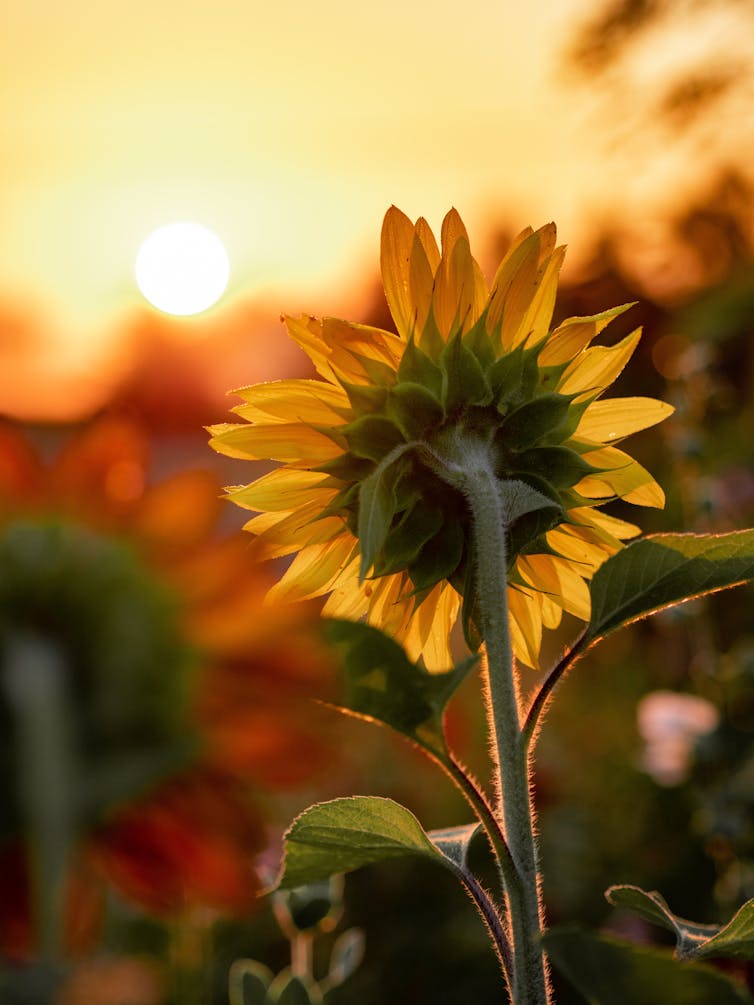
On the east-facing side, the cells grow and elongate quickly during the day, which slowly pushes the flower to face west as the daylight hours go by — following the sun. At night the west-side cells grow and elongate more rapidly, which pushes the flower back toward the east over night.
Everything is then set for the whole process to begin again at dawn next day, which is repeated daily until the flower stops growing and movement ceases.
Read more: The secret life of puddles: their value to nature is subtle, but hugely important
While many people are aware of heliotropism in flowers, heliotropic movement of leaves is less commonly noticed or known. Plants with heliotropic flowers don’t necessarily have heliotropic leaves, and vice versa.
Heliotropism evolves in response to highly specific environmental conditions, and factors affecting flowers can be different from those impacting leaves.

For example, flowers are all about pollination and seed production. For leaves, it’s for maximising photosynthesis, avoiding over-heating on a hot day or even reducing water loss in harsh and arid conditions.
Some species, such as the Queensland box, arrange their leaves so they’re somewhat horizontal in the morning, capturing the full value of the available sunlight. But there are also instances where leaves align vertically to the sun in the middle of the day to minimise the risks of heat damage.
Plants Are Dynamic
It’s easy to think of plants as static organisms. But of course, they are forever changing, responding to their environments and growing. They are dynamic in their own way, and we tend to assume that when they do change, it will be at a very slow and steady pace.
Heliotropism shows us this is not necessarily the case. Plants changing daily can be a little unsettling in that we sense a change but may not be aware of what is causing our unease.
As for me, I still keep a watchful eye on those Queensland boxes!
Gregory Moore, Doctor of Botany, The University of Melbourne
This article is republished from The Conversation under a Creative Commons license. Read the original article.
Friday Essay: an introduction to Confucius, his ideas and their lasting relevance

The man widely known in the English language as Confucius was born around 551 BCE in today’s southern Shandong Province. Confucius is the phonic translation of the Chinese word Kong fuzi 孔夫子, in which Kong 孔 was his surname and fuzi is an honorific for learned men.
Widely credited for creating the system of thought we now call Confucianism, this learned man insisted he was “not a maker but a transmitter”, merely “believing in and loving the ancients”. In this, Confucius could be seen as acting modestly and humbly, virtues he thought of highly.
Or, as Kang Youwei — a leading reformer in modern China has argued — Confucius tactically framed his revolutionary ideas as lost ancient virtues so his arguments would be met with fewer criticisms and less hostility.
Confucius looked nothing like the great sage in his own time as he is widely known in ours. To his contemporaries, he was perhaps foremost an unemployed political adviser who wandered around different fiefdoms for some years, attempting to sell his political ideas to different rulers — but never able to strike a deal.
It seems Confucius would have preferred to live half a millennium earlier, when China — according to him — was united under benevolent, competent and virtuous rulers at the dawn of the Zhou dynasty. By his own time, China had become a divided land with hundreds of small fiefdoms, often ruled by greedy, cruel or mediocre lords frequently at war.
But this frustrated scholar’s ideas have profoundly shaped politics and ethics in and beyond China ever since his death in 479 BCE. The greatest and the most influential Chinese thinker, his concept of filial piety, remains highly valued among young people in China, despite rapid changes in the country’s demography.
Despite some doubts as to whether many Chinese people take his ideas seriously, the ideas of Confucius remain directly and closely relevant to contemporary China.
This situation perhaps is comparable to Christianity in Australia. Although institutional participation is in constant decline, Christian values and narratives remain influential on Australian politics and vital social matters.
The danger today is in Confucianism being considered the single reason behind China’s success or failure. The British author Martin Jacques, for example, recently asserted Confucianism was the “biggest single reason” for East Asia’s success in the handling of the COVID-19 pandemic, without giving any explanation or justification.
If Confucius were alive, he would probably not hesitate to call out this solitary root of triumph or disaster as being lazy, incorrect and unwise.
Political Structure And Mutual Responsibilities
Confucius wanted to restore good political order by persuading rulers to reestablish moral standards, exemplify appropriate social relations, perform time-honoured rituals and provide social welfare.

He worked hard to promote his ideas but won few supporters. Almost every ruler saw punishment and military force as shortcuts to greater power.
It was not until 350 years later during the reign of the Emperor Wu of Han that Confucianism was installed as China’s state ideology.
But this state-sanctioned version of Confucianism was not an honest revitalisation of Confucius’ ideas. Instead, it absorbed many elements from rival schools of thought, notably legalism, which emerged in the latter half of China’s Warring States period (453–221 BCE). Legalism argued efficient governance relies on impersonal laws and regulations — rather than moral principles and rites.
Like most great thinkers of the Axial Age between the 8th and 3rd century BCE, Confucius did not believe everyone was created equal.
Similar to Plato (born over 100 years later), Confucius believed the ideal society followed a hierarchy. When asked by Duke Jing of Qi about government, Confucius famously replied:
let the ruler be a ruler; the minister, a minister; the father, a father; the son, a son.
However it would be a superficial reading of Confucius to believe he called for unconditional obedience to rulers or superiors. Confucius advised a disciple “not to deceive the ruler but to stand up to them”.
Confucius believed the legitimacy of a regime fundamentally relies on the confidence of the people. A ruler should tirelessly work hard and “lead by example”.
Like in a family, a good son listens to his father, and a good father wins respect not by imposing force or seniority but by offering heartfelt love, support, guidance and care.
In other words, Confucius saw a mutual relationship between the ruler and the ruled.
Love And Respect For Social Harmony
To Confucius, the appropriate relations between family members are not merely metaphors for ideal political orders, but the basic fabrics of a harmonious society.
An essential family value in Confucius’ ideas is xiao 孝, or filial piety, a concept explained in at least 15 different ways in the Analects, a collection of the words from Confucius and his followers.
Read more: Can Ne Zha, the Chinese superhero with $1b at the box office, teach us how to raise good kids?
Depending on the context, Confucius defined filial piety as respecting parents, as “never diverging” from parents, as not letting parents feel unnecessary anxiety, as serving parents with etiquette when they are alive, and as burying and commemorating parents with propriety after they pass away.
Confucius expected rulers to exemplify good family values. When Ji Kang Zi, the powerful prime minister of Confucius’ home state of Lu asked for advice on keeping people loyal to the realm, Confucius responded by asking the ruler to demonstrate filial piety and benignity (ci 慈).

Confucius viewed moral and ethical principles not merely as personal matters, but as social assets. He profoundly believed social harmony ultimately relies on virtuous citizens rather than sophisticated institutions.
In the ideas of Confucius, the most important moral principle is ren 仁, a concept that can hardly be translated into English without losing some of its meaning.
Like filial piety, ren is manifested in the love and respect one has for others. But ren is not restricted among family members and does not rely on blood or kinship. Ren guides people to follow their conscience. People with ren have strong compassion and empathy towards others.
Translators arguing for a single English equivalent for ren have attempted to interpret the concept as “benevolence”, “humanity”, “humanness” and “goodness”, none of which quite capture the full significance of the term.
The challenge in translating ren is not a linguistic one. Although the concept appears more than 100 times in the Analects, Confucius did not give one neat definition. Instead, he explained the term in many different ways.
As summarised by China historian Daniel Gardner, Confucius defined ren as:
to love others, to subdue the self and return to ritual propriety, to be respectful, tolerant, trustworthy, diligent, and kind, to be possessed of courage, to be free from worry, or to be resolute and firm.
Instead of searching for an explicit definition of ren, it is perhaps wise to view the concept as an ideal type of the highest and ultimate virtue Confucius believed good people should pursue.
Relevance In Contemporary China
Confucius’ thinking hs had a profound impact on almost every great Chinese thinker since. Based upon his ideas, Mencius (372–289 BCE) and Xunzi (c310–c235 BCE) developed different schools of thought within the system of Confucianism.
Arguing against these ideas, Mohism (4th century BCE), Daoism (4th century BCE), Legalism (3rd century BCE) and many other influential systems of thought emerged in the 400 years after Confucius’ time, going on to shape many aspects of the Chinese civilisation in the last two millennia.
Modern China has a complicated relationship with Confucius and his ideas.
Since the early 20th century, many intellectuals influenced by western thought started denouncing Confucianism as the reason for China’s national humiliations since the first Opium War (1839-42).
Confucius received fierce criticism from both liberals and Marxists.
Hu Shih, a leader of China’s New Culture Movement in the 1910s and 1920s and an alumnus of Columbia University, advocated overthrowing the “House of Confucius”.
Mao Zedong, the founder of the People’s Republic of China, also repeatedly denounced Confucius and Confucianism. Between 1973 and 1975, Mao devoted the last political campaign in his life against Confucianism.
Read more: To make sense of modern China, you simply can't ignore Marxism
Despite these fierce criticisms and harsh persecutions, Confucius’ ideas remain in the minds and hearts of many Chinese people, both in and outside China.
One prominent example is PC Chang, another Chinese alumnus of Columbia University, who was instrumental in drafting the Universal Declaration of Human Rights, proclaimed by the United Nations General Assembly in Paris on December 10 1948. Thanks to Chang’s efforts, the spirit of some most essential Confucian ideas, such as ren, was deeply embedded in the Declaration.

Today, many Chinese parents, as well as the Chinese state, are keen children be provided a more Confucian education.
In 2004, the Chinese government named its initiative of promoting language and culture overseas after Confucius, and its leadership has been enthusiastically embracing Confucius’ lessons to consolidate their legitimacy and ruling in the 21st century.
Read more: Explainer: what are Confucius Institutes and do they teach Chinese propaganda? ![]()
Yu Tao, Senior Lecturer in Chinese Studies, The University of Western Australia
This article is republished from The Conversation under a Creative Commons license. Read the original article.
Australia Post Celebrates 100 Years Of Ginger Meggs
September 7, 2021
Australia Post is celebrating 100 years of Australia’s much-loved waistcoat-wearing rascal, Ginger Meggs, with the release of three stamps featuring the work of creator Jimmy Bancks, and subsequent illustrators James Kemsley and Jason Chatfield.
The character of Ginger Meggs first appeared in “Gladsome Gladys”, with the comic strip soon renamed “Us Fellers” and then, in 1939, “Ginger Meggs” and is Australia’s most widely syndicated comic strip, having appeared in 129 newspapers in 34 countries.
Australia Post Group Manager Philatelic Michael Zsolt said the stamp issue is a wonderful look at the evolution and longevity of one of Australia’s most recognisable characters.
“Ginger Meggs has been part of the Australian identity for generations, and comic strip readers around the world have looked forward to catching up on his everyday capers,” Mr Zsolt said.
Perth-born, New York–based cartoonist and comedian Jason Chatfield has illustrated “Ginger Meggs” since 2007 and said he was honoured to see the stamps dedicated to the beloved character.
“The team at Australia Post have done an incredible job of encapsulating Ginger’s spirit and the different artists’ interpretations over the past century,” he said.
“As the current custodian of Ginge, I am humbled that his 100th birthday falls under my tenure, and I’m grateful to Australia Post for taking such great care in celebrating him.”
$1.10 Ginger Meggs playing cricket

This design features a Jimmy Bancks’ illustration from 1926 depicting a happy Ginger at a makeshift wicket, poised with bat in hand. Characters Tony and Mike play backstop and an eager fielder.
$1.10 Ginger Meggs with friends

This stamp design features the work of James Kemsley as featured on the cover art of the 1989 kids’ book Wake Up Ginger Meggs, which details the adventures of Ginger and his buddies Bennie and Chubb.
$1.10 Ginger Meggs at the fence

This design features the work of current “Ginger Meggs” artist Jason Chatfield and reproduces the key element of the cover artwork for the commemorative book, Bancks’ Ginger Meggs, which is an illustrated collection of short stories written by Jimmy’s great-great nephew Tristan Bancks.
The stamps and associated products, including a minisheet, stamp pack, first day cover, maxicard set and two stamp and coin covers, are on sale from today at participating Post Offices, via mail order on 1800 331 794, and online while stocks last.
For more information visit auspost.com.au/stamps or australiapostcollectables.com.au
First Wildlife Photographer Of The Year 2021 Images Revealed
Two Australians’ images are among the Natural History Museum's Wildlife Photographer of the Year exhibition now in it's fifty-seventh year.
With a record-breaking number of entries from around the world, the judges of the fifty-seventh Wildlife Photographer of the Year have had the toughest job yet. The photographs are a compelling reminder of the importance of the variety and variability of life on Earth in securing the future of our planet, revealed just ahead of the first phase of the global UN conference of COP15 on biodiversity.
This year's Wildlife Photographer of the Year competition was the most competitive yet, attracting over 50,000 entries from photographers in 95 countries. Every entry was judged anonymously on its creativity, originality, and technical excellence by an international panel of industry experts.
The winning images, along with the two grand title winners, will be announced during a virtual awards ceremony, broadcast live from the Museum's famous Hintze Hall on the evening of Tuesday 12 October.
The Australian works are:
A Caring Hand (Douglas Gimesy)
An orphaned grey-headed flying fox rests at a wildlife shelter, after feeding on special formula milk.
Grey-headed flying foxes are endemic to eastern Australia where they play a key role in seed dispersal and pollination. The species is threatened by increasing heat-stress events as well as the destruction of their forest habitat and the encroachment of urban life.
Orphaned at just three weeks old, this pup will be weaned onto fruit at eight weeks and eventually flowering eucalyptus. After a few months, she will join a crèche and build up flight fitness, before being moved next to Melbourne's Yarra Bend bat colony for eventual release.
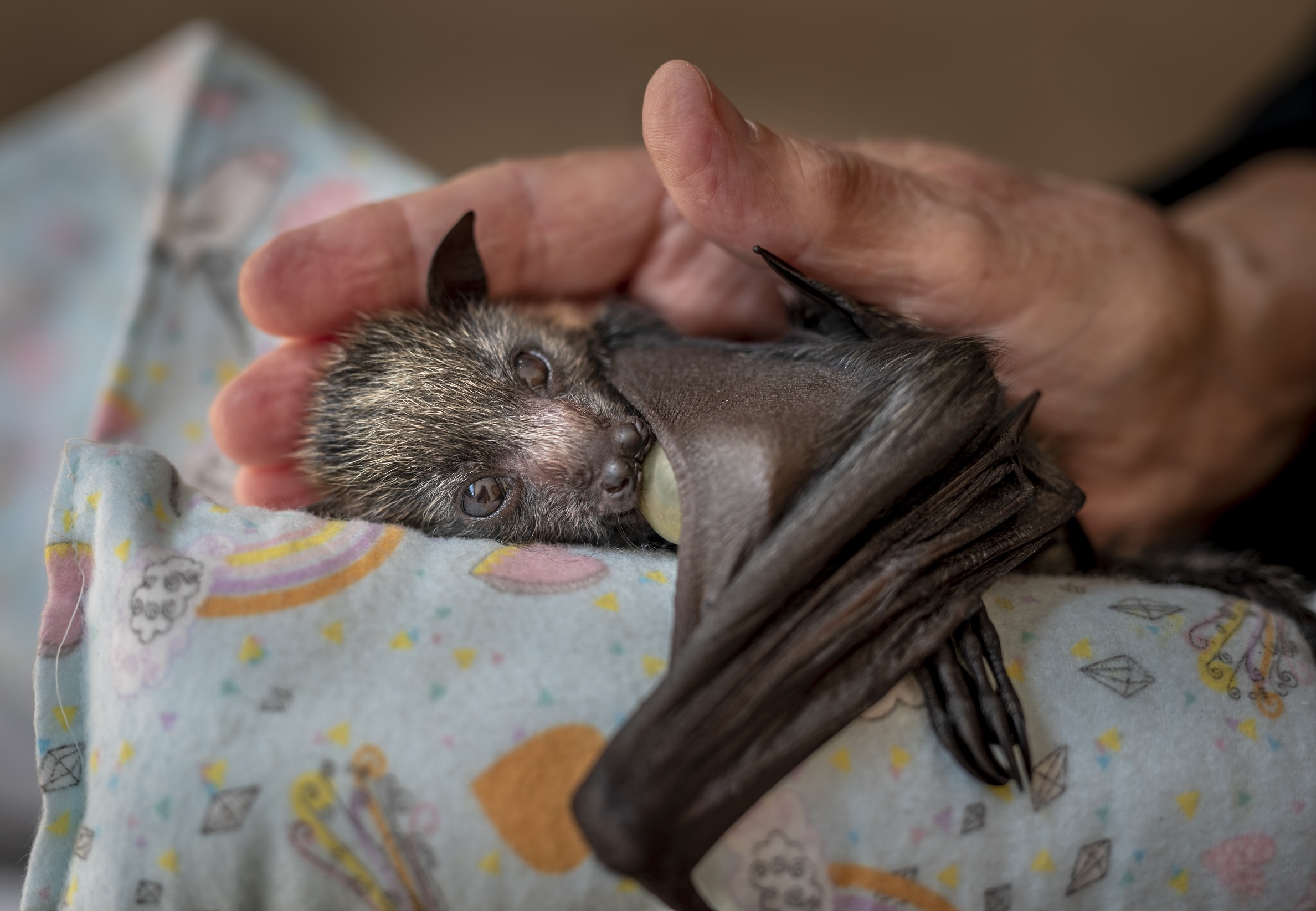
© Douglas Gimesy, Wildlife Photographer of the Year
Doug says ‘’I’m extremely honoured and humbled to share that my image ‘A caring hand’, has been awarded a Highly Commended in the Photojournalism category of this year's prestigious Wildlife Photographer of the Year (WPY) competition. ‘’
‘’My hope is the images and information I share, will inspire people to discover, value and protect the natural world. https://instagram.com/doug_gimesy’’
Mushroom Magic (Juergen Freund)
A glowing ghost fungus blooms in hand-sized fruiting bodies from a dead tree in Queensland, Australia.
Mushroom Magic was Highly Commended in the 2021 Plants and Fungi category
Jurgen used a torch to explore the rainforest near his home, turning it off every few metres to search for the eerie glow of the ghost fungus.
Once he found it, Jurgen spent 90 minutes crouching on the damp, dark floor in order to photograph the fungus at different focal points. He eventually took eight five-minute exposures which he later merged to create one, sharp-focus image.
Scientists know that the ghost fungus makes light through a chemical reaction (luciferin oxidising in contact with the enzyme luciferase), however the reason why the fungus glows is a mystery. No spore‑dispersing insects seem to be attracted by the light, which is produced constantly and may just be a by-product of the fungi's metabolism.
Juergen says ''I am finally able to announce that my glowing fungi "Mushroom Magic" image is honoured Highly Commended in the PLANTS AND FUNGI category at this year's 57th Wildlife Photographer of the Year competition.
I vividly remember this full moon night when Stella and I photographed bright bioluminescent fungi in the middle of a tropical highland.’’
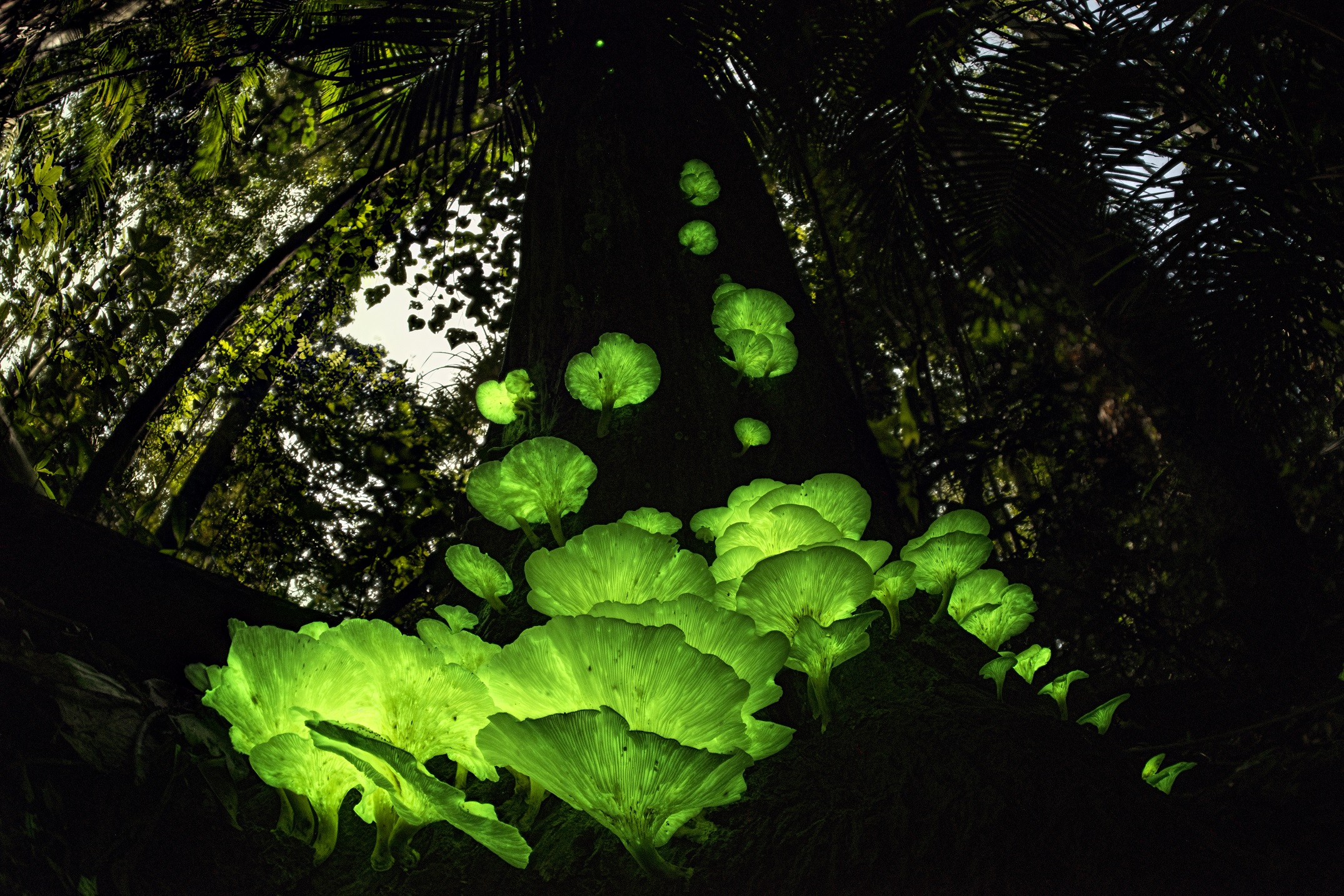
© Juergen Freund, Wildlife Photographer of the Year
From lynx making a comeback to a striking ecological disaster to Narwhal shrimp communicating at great depths; these are just some of the unique and fascinating images in a special selection of Highly Commended photographs that have been released ahead of the opening of the highly anticipated exhibition on Friday 15 October 2021, at the Natural History Museum in London.
Broadcast live from the Natural History Museum, the free event will once again be hosted by BBC presenters and wildlife experts Chris Packham and Megan McCubbin and feature photographers, Museum scientists and special guests.
Among the newly revealed Highly Commended images is Sergio Marijuán’s young Iberian lynx framed in the doorway of an abandoned hayloft; a species that was once on the brink of extinction is now rising in numbers thanks to ongoing conservation efforts. Other images tell the story of nature under pressure, like the vibrant designs captured by Gheorghe Popa, which are the result of heavy metals from mining seeping into the river.
Chair of the judging panel, Roz Kidman Cox says, 'It was the overall quality of entries that took us by surprise. With most travel plans cancelled over the past year, photographers seem to have spent extra time considering what gems to submit. There are stand-out pictures of unforgettable scenes and encounters – those unique wild moments, skillfully framed, that result from knowledge, experience and planning – but also fresh, beautiful observations of nature close to home or in close-up. The result is a collection of both thought-provoking images and ones that, in these dark times, remind us of the joy and wonder to be had from nature.’
Dr Doug Gurr, Director of the Natural History Museum says, 'These extraordinary images showcase the rich diversity of life on Earth and spark curiosity and wonder. Telling the story of a planet under pressure, the Wildlife Photographer of the Year exhibition illuminates the urgent challenges we face and the collective action we need to take. This year’s inspiring exhibition will move and empower audiences to advocate for the natural world.’
After the flagship exhibition is unveiled at the Natural History Museum, the 100 images will embark on a UK and international tour, bringing the emotive power of wildlife photography to millions of people, including those who live in Sydney.
Below run a selection from those early released highly commended images. Which is your favourite?
The Great Swim by Buddhilini de Soyza was Highly Commended in the 2021 Behaviour: Mammals category (leopards)
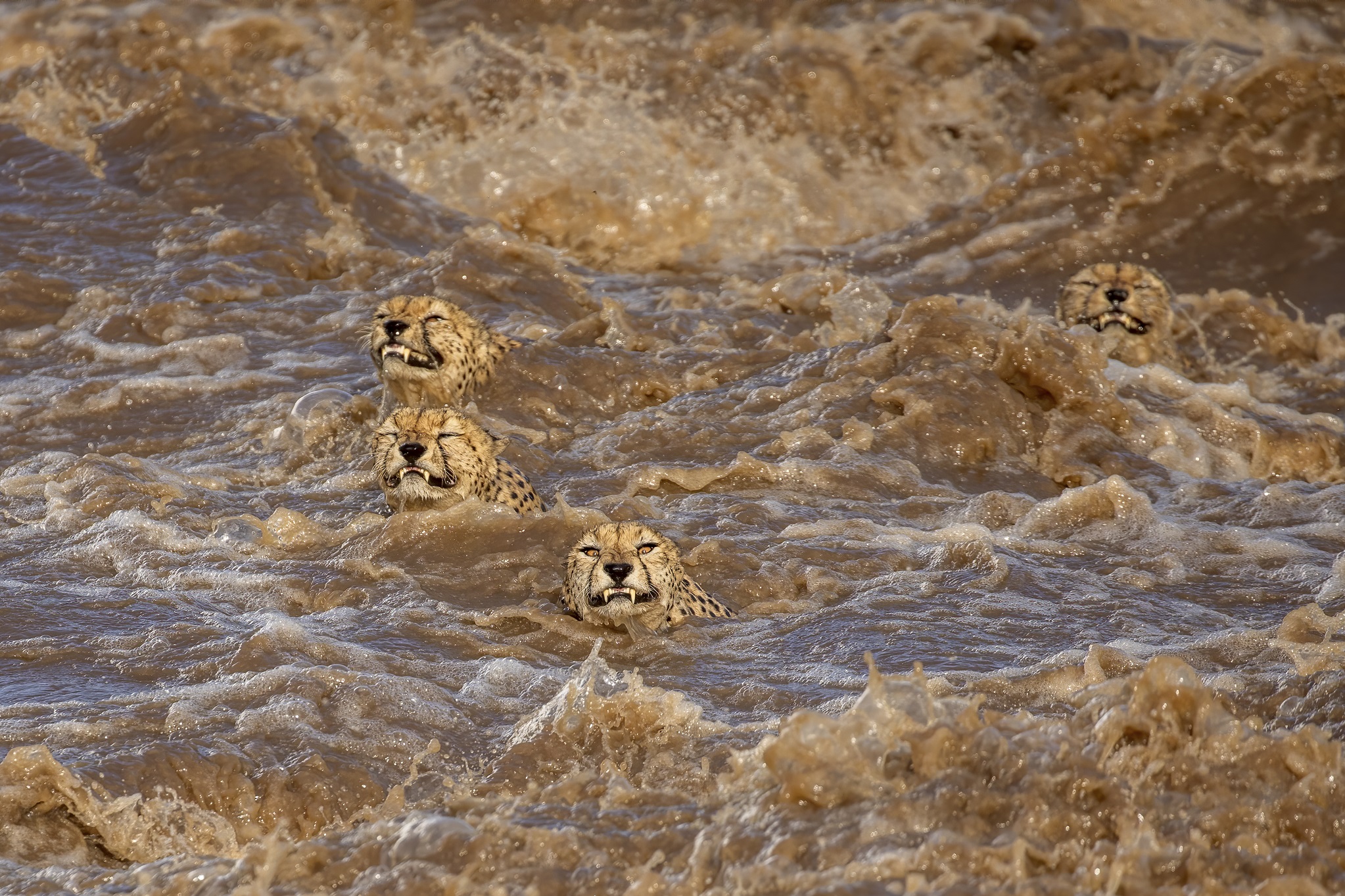
© Buddhilini de Soyza, Wildlife Photographer of the Year
Toxic Design (Gheorghe Popa)
Gheorghe was flying his drone over the Geamana Valley within Romania's Apuseni Mountains when he was struck by the unique colours and patterns of this small river.
Toxic Design was Highly Commended in the 2021 Natural Artistry category. While it may look beautiful, the unnatural colours are the result of toxic chemicals which flow downstream from the nearby Rosia Poieni mine which exploits one of the largest deposits of copper ore and gold in Europe.
The once picturesque valley has become a 'tailings pond' filled with an acidic cocktail, containing pyrite (fool's gold), iron and other heavy metals, laced with cyanide. These toxic materials have infiltrated the groundwater and threatened waterways more widely.
In the late 1970s, more than 400 families living in Geamana were forced to leave to make way for waste flowing in. Gheorghe hopes that his image will 'draw attention to the ecological disaster'.
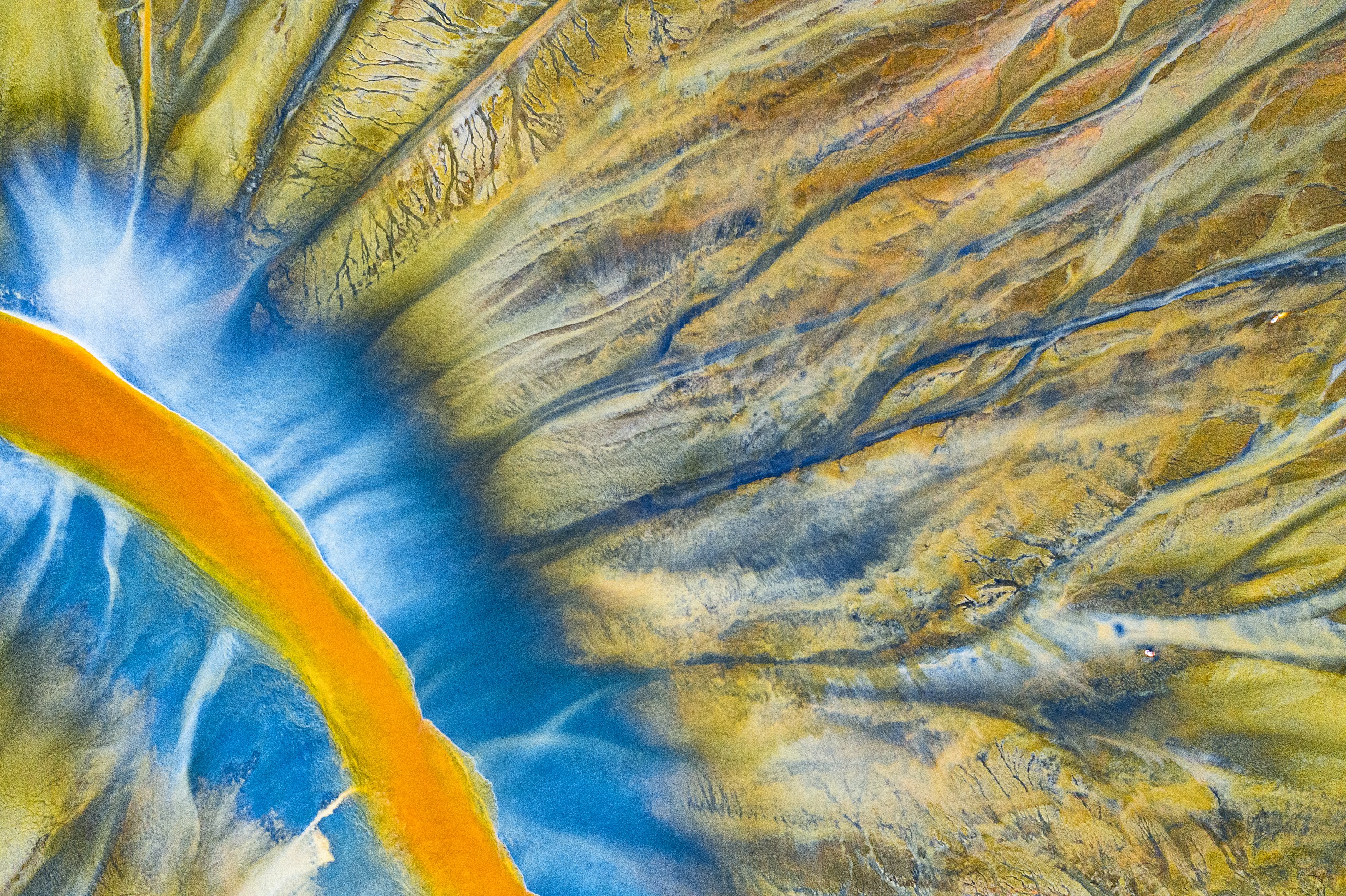
© Gheorghe Popa, Wildlife Photographer of the Year
Apollo Landing (Emelin Dupieux)
As dusk starts to fall, an Apollo butterfly settles on an oxeye daisy in the Haut-Jura Regional Nature Park on the French‑Swiss border.
Apollo Landing was Highly Commended in the 2021 11-14 Years category
The Apollo, a large mountain butterfly with a wingspan of up to 90 millimetres, has been affected by the warming climate and is now one of Europe's most threatened butterflies.
Emelin was on holiday when he found himself in an alpine meadow surrounded by butterflies. He had long dreamed of photographing an Apollo, so he set to work in the falling light to get his perfect shot.
Though slow flyers, the Apollos were constantly on the move and the gentle breeze meant the daisies were moving too.
After numerous adjustments of settings and focus, Emelin finally achieved his emblematic image: the whites standing out in stark contrast, and just daubs of colour from the yellow hearts of the daisies and the red eyespots of the Apollo.
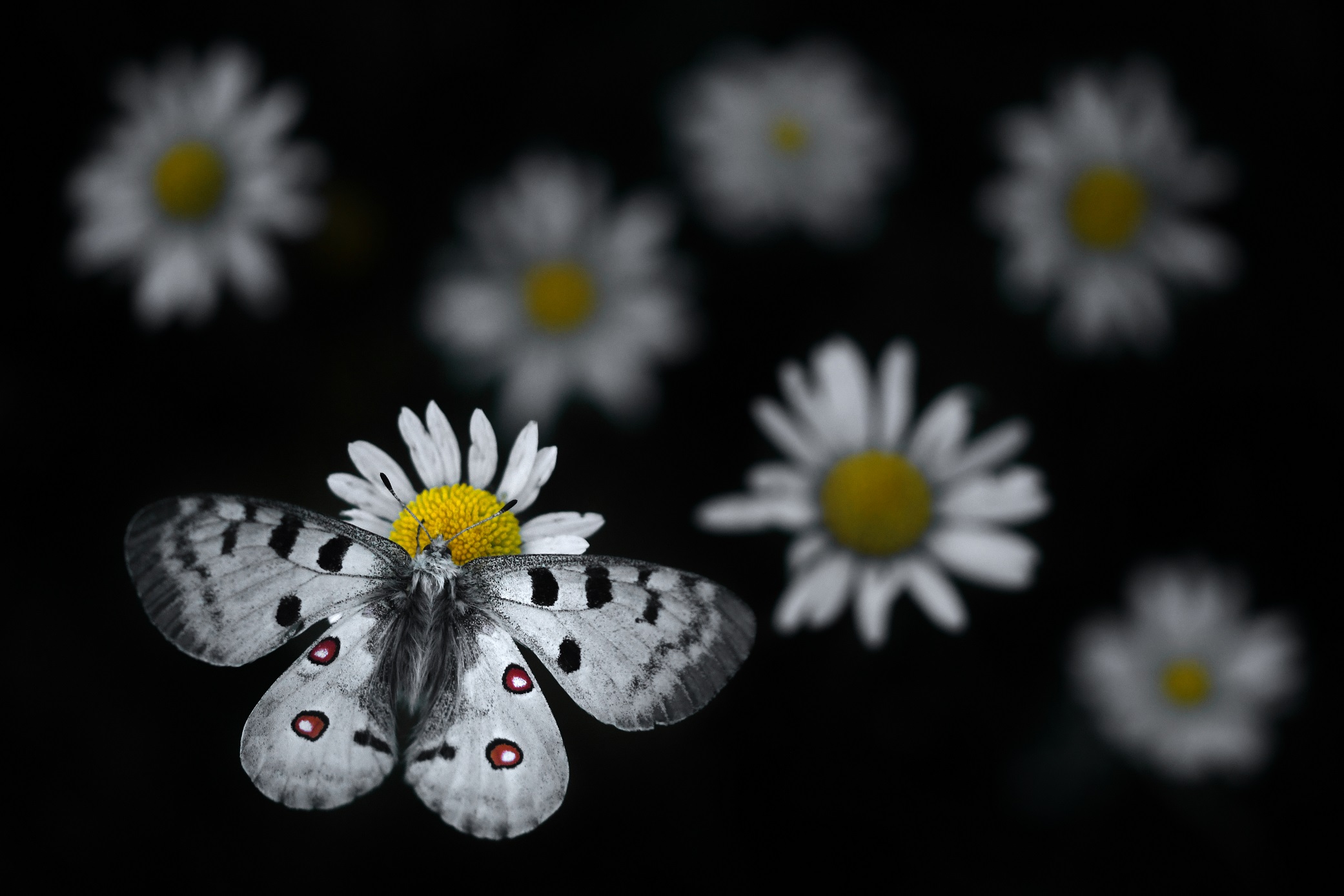
© Emelin Dupieux, Wildlife Photographer of the Year
Lockdown Chicks (Gagana Mendis Wickramasinghe)
10-year-old Gagana watched as three rose-ringed parakeet chicks emerged from their nest to greet their returning father.
Lockdown Chicks was Highly Commended in the 2021 10 Years and Under category
The family of parakeets had nested in a dead areca-nut palm in the backyard of Gagana's parents' home in Colombo, Sri Lanka. His parents had intentionally left the tree standing in the hopes of attracting wildlife. The tree proved to be an important source of entertainment as the island went into lockdown during the spring of 2020.
Gagana and his older brother spent hours experimenting with their cameras, sharing lenses and a tripod, in the hopes of getting a photo with the chicks showing themselves.
Also known as ring‑necked parakeets, these medium-sized parrots are native to Sri Lanka, India and Pakistan as well as parts of sub‑Saharan Africa, but feral populations are now found in many countries including the UK. Parakeets are a common sight in some urban settings, where they are known to breed in holes in brick walls.
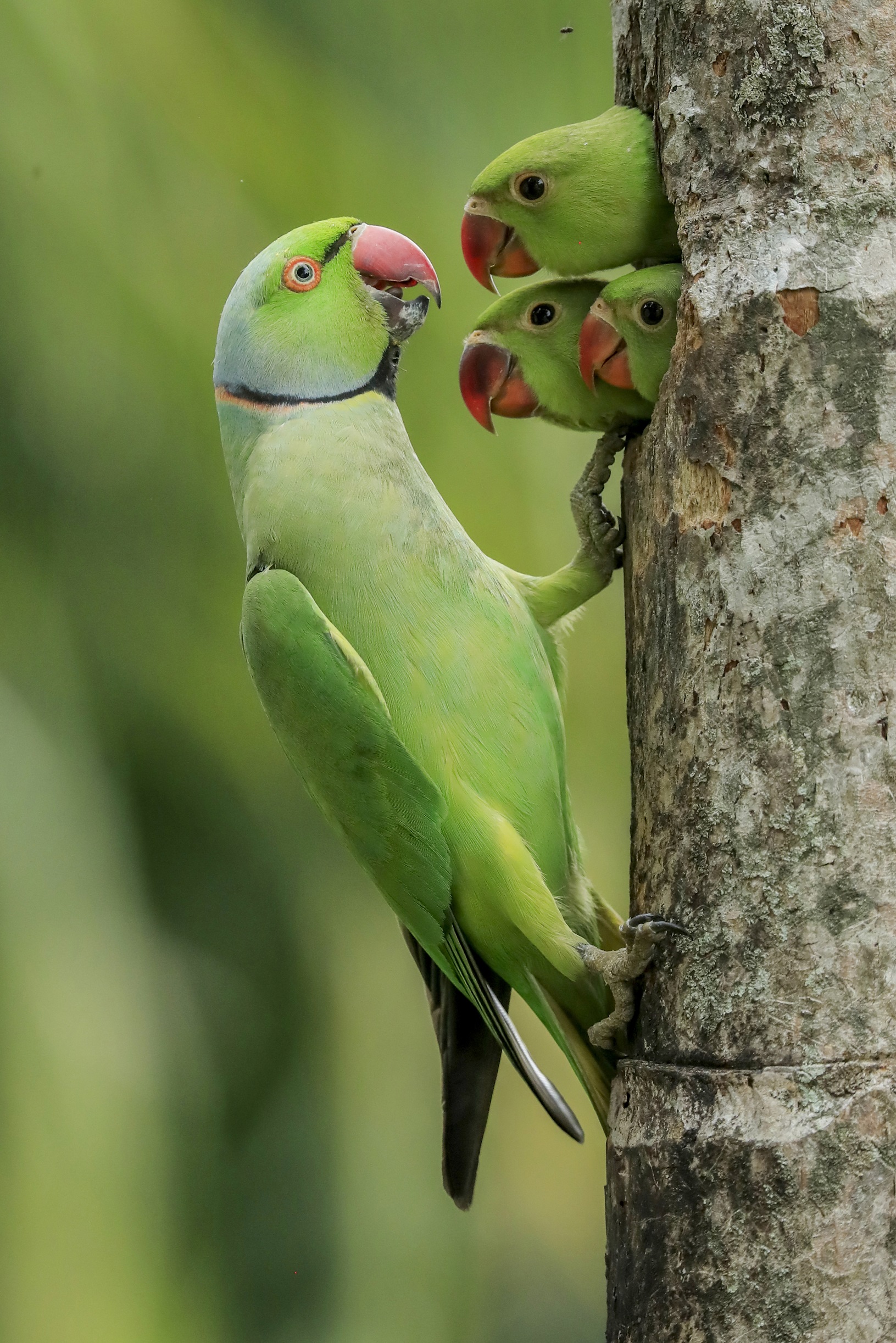
© Gagana Mendis Wickramasinghe, Wildlife Photographer of the Year
Deep Feelers (Laurent Ballesta)
In deep water off the French Mediterranean coast, a vibrant community of thousands of narwhal shrimps stay connected by their long outer antennae.
Deep Feelers was Highly Commended in the 2021 Underwater category
Laurent's photo shows each shrimp in touch with its neighbours via their antennae and suggests that, potentially, signals were being sent across a far‑reaching network. Research has shown that such contact is central to the shrimps' social behaviour, in pairing and competition.
Against the deep blue of the open water, floating among the feathery black coral - which is white when living - the translucent narwhal shrimps looked exceptionally beautiful with their red and white stripes, long orange legs and sweeping antennae.
These shrimps are fished commercially by bottom-trawling vessels which destroy the slow‑growing coral forests as well as the communities of shrimps that live among them.
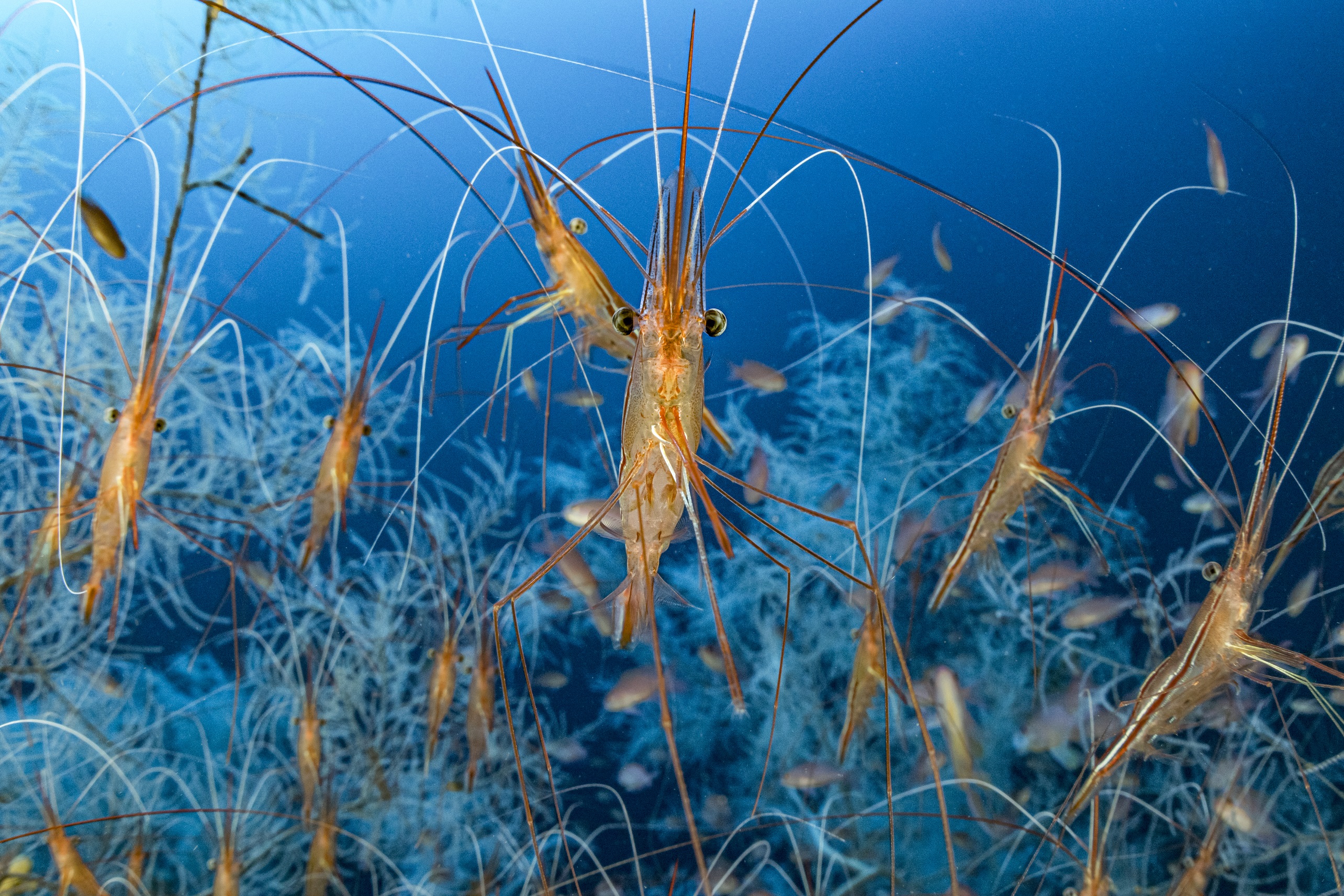
© Laurent Ballesta, Wildlife Photographer of the Year
Storm Fox (Jonny Armstrong)
A fox searches for salmon carcasses at the water's edge on a tiny island in Karluk Lake, Alaska.
Storm Fox was Highly Commended in the 2021 Animal Portraits category
As one of only two foxes on the tiny island, she was surprisingly bold. Jonny had followed this vixen over several days, watching her forage for berries, pounce after birds and playfully nip at the heels of a young brown bear.
Taking advantage of the dramatic light created by a storm rolling in, Jonny laid low on his chest, aiming for a low, wide angle.
Working with a manual flash, he preset the power for a soft spotlight - just enough to bring out the texture of her coat.
As the confident fox came closer, Jonny's companion and fellow researcher raised the diffused flash for him, piquing the curiosity of the fox.
When it looked up at the mysterious object Jonny got his atmospheric portrait which looks almost studio-shot, just in time before the storm rolled in and drenched the scene in rain.
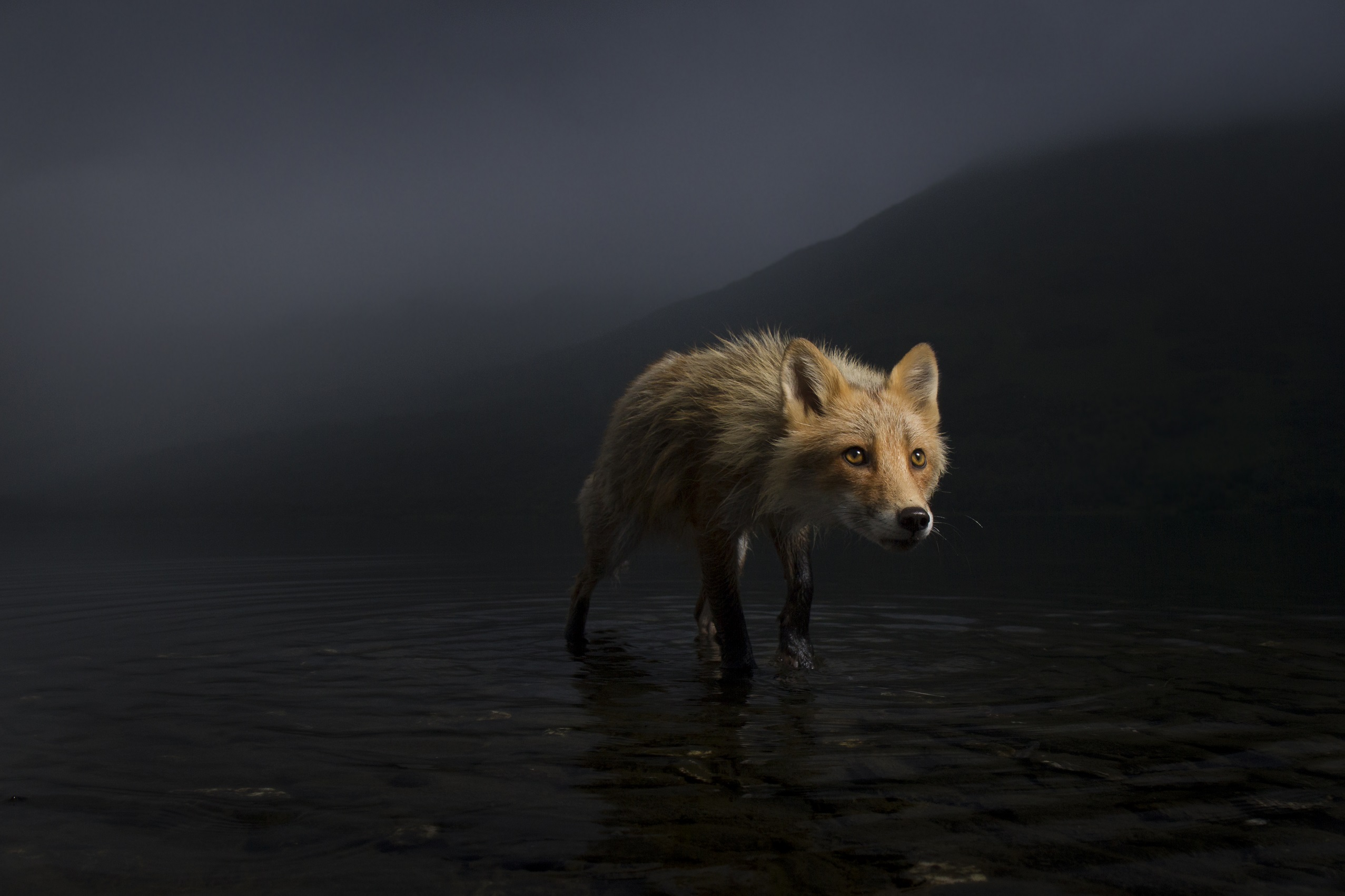
© Jonny Armstrong, Wildlife Photographer of the Year
Net Loss (Audun Rikardsen)
The devastating result of overfishing on our oceans. A mass of dead and dying herring cover the surface of the sea as far as the eye can see, just off the coast of Norway.
Net Loss was Highly Commended in the 2021 Oceans: The Bigger Picture category
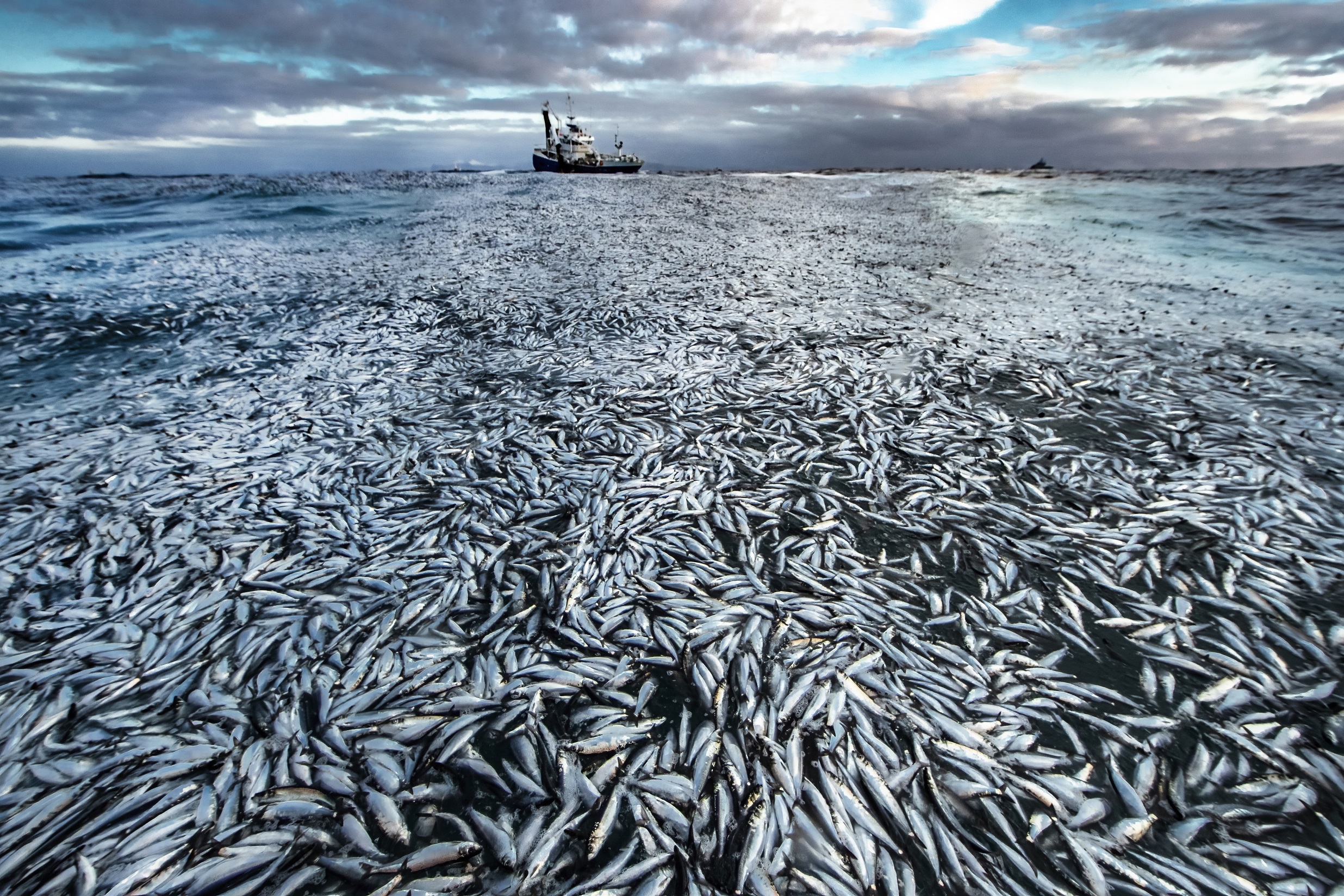
© Audun Rikardsen, Wildlife Photographer of the Year
From his position on board a Norwegian coastguard vessel, in the area to track killer whales, Audun was able to photograph the entire scene.
The boat had caught too many fish. When the net was winched up, it broke, releasing tonnes of crushed and suffocated animals back into the water. Audun's photos documented this crime against nature and were later used as evidence in a court case that resulted in a conviction and fine for the owner of the boat.
Overfishing poses a massive threat to our ocean ecosystems and according to the UN Food and Agriculture Organization, more than 60% of fisheries today are either fully fished or collapsed, and almost 30% are considered overfished.
Norwegian spring-spawning herring - part of the Atlantic herring population complex - was almost fished to extinction in the 1960s, in a classic example of how a combination of bad management, a lack of knowledge and greed can have a devastating and sometimes permanent effect on a whole ecosystem.
It took 20 years and a near‑ban on fishing for herring populations to recover. However, as Audun's picture shows, it is a recovery that needs continued monitoring.
Lynx on the Threshold (Sergio Marijuán)
Photographed through the doorway of an abandoned hayloft on a farm in eastern Sierra Morena, Spain, a young Iberian lynx pauses to survey its surroundings.
Lynx on the Threshold was Highly Commended in the 2021 Urban Wildlife category
The species was once widespread across the Iberian Peninsula of Spain and Portugal, but it declined following prolonged habitat loss, loss of prey and hunting and killing by farmers.
By 2002 there were fewer than 100 lynxes in Spain and none at all in Portugal.
Now, however, thanks to conservation practices, the Iberian lynx has escaped extinction and is fully protected across the region. Ongoing practices of rewilding, prey boosting and the creation of natural corridors and tunnels have helped numbers increase.
This individual is the latest in a family line to make use of the abandoned hayloft, where Sergio's carefully positioned camera-traps document family life.
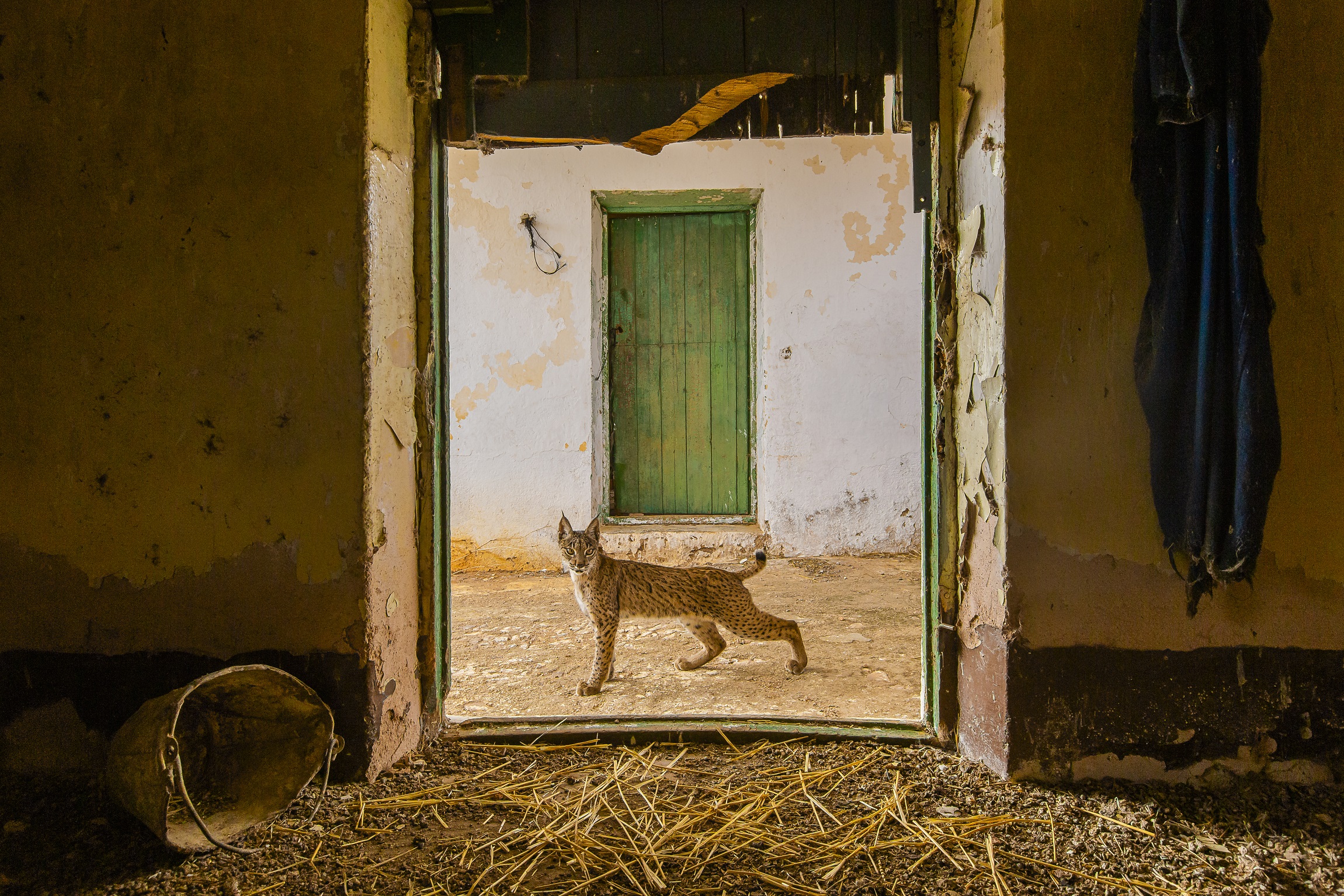
© Sergio Marijuán, Wildlife Photographer of the Year
Willoughby's Senior Volunteer Of The Year Award Goes To 92-Year-Old Resident

Can’t See The Forest For The Trees
Predicting Possible Alzheimer’s With Nearly 100 Percent Accuracy

Study Identifies Ways To Reduce Hospitalisations For Older Australians
Politics, flashmobs, Yolngu dancers: the Australian story of Mikis Theodorakis’ legendary song Zorba
Andonis Piperoglou, Griffith UniversityFor those with only a cursory familiarity with Greece and Greek music, the name of Mikis Theodorakis, who died last week aged 96, may conjure flashbacks to the 1964 film Zorba the Greek . That moment on a Cretan beach when Alexis (Anthony Quinn) teaches Basil (Alan Bates) how to dance the sirtaki, now universally known as the “Zorba dance”, is etched into our collective memory.
Born in 1925, Theodorakis began writing music when he was a child. During his lifetime, he was a political figure as much as a composer. Under the Greek junta (1967-1974) the dictatorship banned his music. Theodorakis was jailed, tortured, put under house arrest and, from 1970 until 1974, lived in exile. His Journals of Resistance (1973) was a statement of defiance to the military regime.
As a composer he fused poetry and popular musical idioms, achieving wide appeal at home and abroad. Reworking Greek folk rhythms, he incorporated past tradition with present inspiration and future hope. His Mauthausen Trilogy, a cycle of four arias composed in 1965, is credited as a standout composition on the Holocaust.
His composition of the Zorba is one of the most recognisable sounds of the 20th century. Its accompanying dance — with its slow, smooth actions that gradually transform into faster, more vivid movements in unison with the metallic sound of the bouzouki — is both loved and despised.

His 1972 Australian Tour
In 1972, while still living in exile, Theodorakis toured Australia. The Tribune newspaper called it “one of the big events of the year” which would be enjoyed by both “Greek migrants and other Australians”.
Interviewed in Melbourne, also for the Tribune, one Greek migrant expressed her elation: “Do you see what Theodorakis means to our country? […] The best poetry in the country was being sung in the streets to his music.”
Coinciding with an emergent Australian multicultural ethos, Theodorakis’ concerts also prompted a critique of the country’s desire to assimilate migrants.
If Greek culture is lost to us by assimilation […] rather than retained and developed by its integration into a multi-nation, multi-racial Australia, a crime will have been committed.
The Communist Party of Australia also praised his tour. In a statement, Greek members of the party said:
Never before in the history of Greeks in Australia has there been such an immense and spontaneous popular excitation for the Greece of struggle, justice and beauty as has happened during the Theodorakis concerts.
Theodorakis clearly ignited impassioned sentiments.
A few years after his tour, the White Australia Policy would be abolished, and multiculturalism would become official state doctrine, with Zorba becoming a mainstay at multicultural festivals.
Read more: Australian politics explainer: the White Australia policy
An Australian Multicultural Dance
Promoting cultural retention, these performances have contributed to the formation of a Greek Australian identity.
Greek festivals bring Australians from differing regional backgrounds together, and the dance has contributed to how Greekness can be acquired and expressed. For third or fourth generation children of Greek background — who often lack Greek language skills — learning Zorba facilitates an awareness of distinctive ethnic roots.
Read more: ‘Where are you from?’ is a complicated question. This is how young Australians answer
The performance isn’t limited to the Greek community. It has spread to be taught in school sports classes and performed at events like the Sydney Olympics and at the NRL’s multicultural round.
In 2018, as part of the Melborune’s Lonsdale Street Greek Festival, attempts were made via a “Big Fat Greek Flashmob” to set a world record for the largest number of people dancing to the familiar tune. They were unable to beat the record of 5,614 people in Volos, Greece, in 2012.
But perhaps the most famous rendition of the dance came from an unexpected source.
Remastering Zorba, Yolngu Style
In 2007 a group of young Yolngu dancers from Elcho Island made global headlines. The Chooky Dancers (later renamed Djuki Mala) became famous when Frank Djirrimbilpilwuy uploaded an inconspicuous video recording on YouTube.
The viewer awaits a traditional dance routine. Instead, the young men move in sync to a pop techno remix of Zorba, performing movements usually reserved for Greek weddings and christenings.
As a way of saying thank you to a Greek friend named Liliane, the dance strengthened the relationship between Yolngu people and the Northern Territory’s Greek community.
The video went viral. Djuki Mala performed their hit on Australia’s Got Talent and toured Europe and the Middle East, including an invitation from Theodorakis’s family to dance in Athens.
The original video has now been viewed over three million times. It remains an uplifting cultural accomplishment: both poking fun at and remastering Zorba.
A way of sharing of Yonglu cultural expression, and a hallmark example of the way Greek Australian culture has become firmly part of the fabric of modern Australia.
Read more: What's so funny about Aboriginal and Torres Strait Islander humour? ![]()
Andonis Piperoglou, Adjunct Research Fellow, Griffith Centre for Social and Cultural Research, Griffith University
This article is republished from The Conversation under a Creative Commons license. Read the original article.
‘I tell everyone I love being on my own, but I hate it’: what older Australians want you to know about loneliness

Over the past 18 months of COVID lockdowns, many of us have experienced the heaviness of loneliness — missing family, friends, and meaningful social contact.
But even before the pandemic, loneliness was a daily experience for almost 20% of older Australians, particularly those over 75.
Being older does not mean being lonely. Loneliness can affect us all. But it disproportionally affects older people living alone or in aged care facilities, and whose health issues limit their social interaction.
Loneliness increases an older person’s risk of illness, from cardiovascular diseases to dementia.
The older people we spoke to for our research also talked openly about how devastating loneliness can be. As Scarlett* explains:
You get teary for the want of human company.
Yet, the success of initiatives to tackle loneliness has been limited by the complexity of loneliness, the stigma around it and the diversity of people’s situations in later life.
Listening To Older People
We know loneliness is a serious social and health issue. So, what can those experiencing loneliness tell us and what are their suggestions for addressing it?
During two lockdowns in 2020, we explored these questions with 35 Victorians aged 65 and above who were living alone. We used a combination of interviews, surveys and diary-keeping.

What Changed With COVID?
Before COVID many participants felt lonely in the morning or evening, but during lockdowns, they felt it throughout the entire day.
On top of the isolation of lockdown, the restrictions disrupted their regular coping strategies such as “keeping busy”, volunteering, engaging in community activities or clubs. As Scarlett noted:
With COVID, the strategies that one puts in place to try to deal with loneliness have ceased to be, not by choice but necessity.
Jacko similarly explained the only people he had contact with were shop assistants.
You must understand that, for me, lonely is the norm. Pre-COVID, I would get some respite by going out on activities, but the lockdown has killed all of them.
What Helps?
Despite the disruption to their usual strategies, most participants sought other options during lockdowns.
Maintaining social contact, through calls with loved ones or via small daily interactions, was vital. While for most, communication via technology was not the same as meeting in-person, video calls and emails eased their loneliness. Online activities with grandchildren, including gaming or assisting with homework, made them feel included and needed.
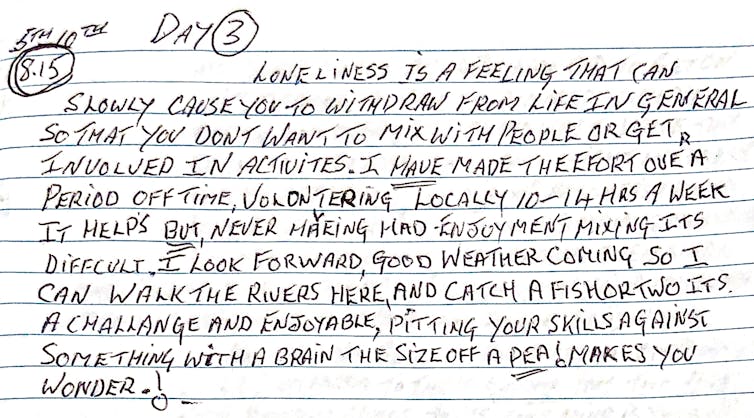
But technology only helped ease loneliness if it wasn’t used for superficial contact. Short video calls, for example, were not enough. Many hoped technology would not encourage loved ones to reduce visits after lockdowns. As Lisa explained:
Technology is not my favourite means of communication. You miss out on small nuances in body language and spontaneity on phoning or video conferencing.
Although small talk was insufficient to fully tackle loneliness, daily interactions with neighbours, passersby and supermarket staff took on greater importance during lockdowns. Some would go to specific shops because staff would chat to them.
Other helpful strategies were having a well-defined routine and going for walks. Planning enjoyable things they could do on their own, such as painting or gardening, and appreciating “small things” outside in nature, during a walk, gave participants a sense of purpose.
What Older People Want Others To Know About Loneliness
The older people in our study had three key messages about their experience.
The first was, admitting to feeling lonely is not easy, especially for older people living alone. They want to remain independent and not be seen as a failure. As June wrote in her diary:
I tell everyone I love being on my own, but in fact, I hate it.
Second, many waited for their phone to ring to break the silence. A house can seem like a prison when you can’t leave it. As Fred told us:
Loneliness kicks in as silence descends on the home.
Third, the lonelier you feel, the more rejected you feel by family, the community and society at large. Our participants started believing no-one cared about them and even reported suicidal ideation. As Bob wrote:
who wants anything to do with an old-age pensioner regarded as unproductive, invalid, good-for-nothing-old-man, parasite on the community?
This sentiment was made worse by the way older people were portrayed during the pandemic as either disposable or too vulnerable.
Pick Up The Phone
Our research suggests if we don’t initiate conversations with our older friends and family members about loneliness, it is unlikely they will mention it.
It also shows older people already put a lot of effort into managing their loneliness. But they could do with more help from the rest of us.
We know that simple things, such as picking up the phone for a meaningful chat, or planning another routine interaction, are incredibly important. Not only do they improve the quality of older people’s lives, they could be life saving as well.
*Pseudonyms have been used.
If this article has raised issues for you or if you’re concerned about someone you know, call Lifeline on 13 11 14 or beyondblue on 1300 22 46 36.
This piece was produced as part of Social Sciences Week, running 6-12 September. A full list of events can be found here. Barbara Barbosa Neves will appear in a webinar “Emotion inequality in pandemic Australia” at 11am, Wednesday September 8.![]()
Barbara Barbosa Neves, Senior Lecturer in Sociology, Monash University; Alexandra Sanders, Sociology Research & Teaching Associate, Monash University; David Colón Cabrera, Lecturer in Anthropology, Monash University, and Narelle Warren, Associate Professor in Sociology and Anthropology, Monash University
This article is republished from The Conversation under a Creative Commons license. Read the original article.
Five Exercises To Stay Fit During Lockdown
Dementia Action Week
20 – 26 September 2021
- Give a little support to a person living with dementia.
- Give a little support to a carer, friend or family member of a person living with dementia.
- Help healthcare professionals make their practice more dementia-friendly.
Faster Horses Consulting’s Inside Aged Care 2021 Report
- The Australian public’s views of the aged care industry, including (but not limited to) levels of trust, perceptions of openness and transparency, adequacy of funding and care levels
- How well the industry performs across the Age Care Quality Standards
- Demand for different types of care provided by the industry
- Triggers to actively pursuing the care required
- Emotional reaction to the potential need for aged care services
- The perspectives of both family members and those receiving care of the industry and the service they receive
- Brand performance nationally across spontaneous and prompted awareness, and provider consideration and imagery
- Choice drivers motivating provider selection
- Views on workforce challenges and key drivers of workforce shortages in the sector
- Community views on the extent to which uptake of technology can drive improve the quality of age care provision
2021 Australian Museum Eureka Prizes Finalists
NSW Environment, Energy And Science (DPIE) Eureka Prize For Applied Environmental Research
Eureka Prize For Excellence In Interdisciplinary Scientific Research
Australian Infectious Diseases Research Centre Eureka Prize For Infectious Diseases Research
Macquarie University Eureka Prize For Outstanding Early Career Researcher
Defence Science And Technology Eureka Prize For Outstanding Science In Safeguarding Australia
UNSW Eureka Prize For Scientific Research
Leadership
AstraZeneca Eureka Prize For Emerging Leader In Science
Eureka Prize For Leadership In Innovation And Science
University Of Technology Sydney Eureka Prize For Outstanding Mentor Of Young Researchers
Science Engagement
Department Of Industry, Science, Energy And Resources Eureka Prize For Innovation In Citizen Science
Finkel Foundation Eureka Prize For Long-Form Science Journalism
- Kate Cole-Adams
- Dr Dyani Lewis
- Dr Jackson Ryan
Celestino Eureka Prize For Promoting Understanding Of Science
- Dr Niraj Lal
- Professor Veena Sahajwalla
- Associate Professor Adriana Vergés
Australian Museum Eureka Prize For Science Journalism
- Nicole Hasham, Wes Mountain, Anthea Batsakis, Sunanda Creagh, Ben Clark and Michael Lund
- Patient Zero
- Dr Jackson Ryan
Department Of Industry, Science, Energy And Resources Eureka Prize For STEM Inclusion
- Little Scientists Australia
- STEM Enrichment Academy
- Corey Tutt and Team DeadlyScience
School Science
University Of Sydney Sleek Geeks Science Eureka Prize - Primary
- Leon H. St Andrew's Cathedral School, NSW- A self-proclaimed car enthusiast, Leon was fascinated by how his tiny toy cars defied gravity and travelled upside down around a loop track without falling to the floor. In Tour de Force, he uses a delightful combination of demonstrations, illustration and performance to examine the role of centripetal force in this natural phenomenon.
- Zara M. PLC Sydney, NSW - Big Problem: Coral Bleaching is an entertaining investigation into one of the most widespread issues affecting coral reefs. Inspired by her passion for the ocean, Zara sets out to educate viewers on some of the main causes of coral bleaching, the scientific process behind it and ways that everyone can work together to help minimise the issue.
- Scarlett O. and Scarlett P. Oak Flats Public School, NSW - If a super volcano erupted, the impacts would be widespread and catastrophic. In their film Super Volcanoes, Scarlett and Scarlett demonstrate the science behind these high magnitude eruptions and explain how they could be used as a source of power, providing green energy for future generations.
University Of Sydney Sleek Geeks Science Eureka Prize - Secondary
- Jonathan D. Townsville Grammar School, Qld - In Rewilding Earth, Jonathan discusses the implications of climate change and investigates how enhancing biodiversity could help address this pressing issue. Through a series of interviews, he shares community concerns about the future of climate change then draws on research to explain the process of rewilding.
- Isaac N., Ethan P., Reuben R. and Alex S. Willetton Senior High School, WA - The square-cube law states that as an object increases in size, its mass grows at a faster rate than its surface area. After considering whether it would be possible for Godzilla to exist, Isaac, Ethan, Reuben and Alex apply this principle to explore how large an animal could realistically get. Their film Square-Cube Law is a comprehensive presentation of the group’s findings.
- Sonya R. Eltham High School, Vic - Have you ever contemplated what life would be like on Mars? In How to Get to Mars - A Big Question, Sonya uses clay modelling to explore a series of obstacles that humans would need to overcome before they could live on the Red Planet and proposes some practical solutions for each.
University Of Sydney Sleek Geeks Science - Highly Commended
Sleek Geeks Science Highly Commended - Primary School
Sleek Geeks Science Highly Commended - Secondary School
2021 Eureka Prizes Award Ceremony
Over 200 Health Journals Call On World Leaders To Address 'Catastrophic Harm To Health' From Climate Change
Social Housing Going Backwards In NSW
The Warming Climate Is Causing Animals To 'Shapeshift'
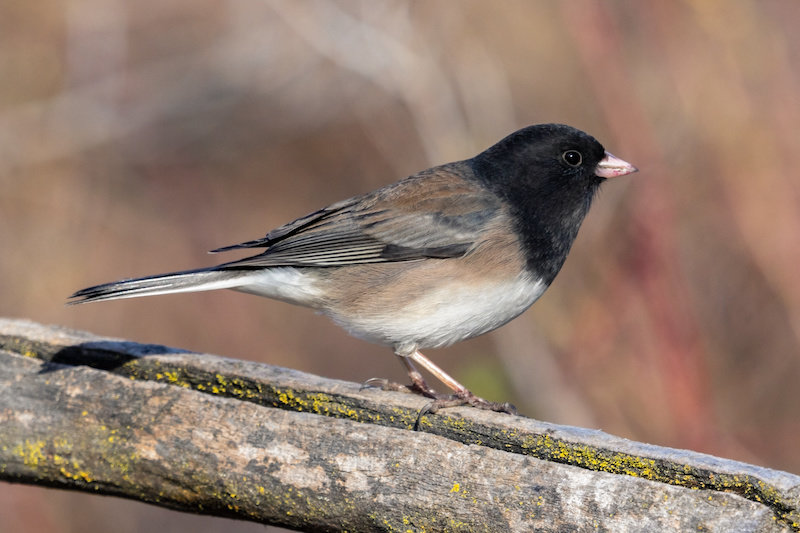
Blue-Tongue Vs Red-Bellied Black: An Australian Evolutionary Arms Race
Funding Awarded To Collaborative UNSW Research Projects
Grim Warning For Aussie Species In Conservation Checklist
Explainer: do the states have to obey the COVID national plan?
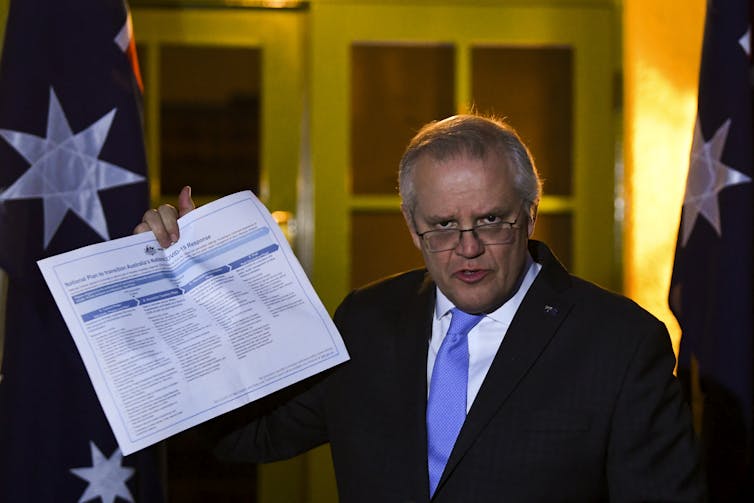
In August 2021, the national cabinet agreed to a National Plan to transition Australia’s National COVID-19 Response. It was based upon epidemiological modelling of the Delta variant by the Doherty Institute. It sets out four phases, with phase B starting when about 70% of those aged 16 and over are fully vaccinated, and phase C starting when over 80% are fully vaccinated.
Read more: Morrison battles to get hardline premiers to accept the inevitable spread of COVID
Is The Plan ‘Set In Stone’?
The national plan is based on modelling that relies on a range of assumptions. In its advice, the Doherty Institute stated:
Ongoing situational assessment of measured transmission potential and circulating SARS-CoV-2 variants in the Australian population over coming months will allow benchmarking of these hypothetical scenarios to guide real time policy decision making about the transition to phase B of the national plan.
In other words, there will have to be ongoing assessment of the facts to help decide when to move to phase B. For example, the breadth of coverage of vaccinations would have to be considered, to ensure there are no under-vaccinated groups, such as Indigenous communities. The emergence of any new variants would have to be assessed to see how they respond to the vaccine.
Whether a State’s health system was coping with existing numbers of infections and its “test, trace, isolate, quarantine” capacity was running effectively or swamped would also need to be considered.
The national plan expressly says at the bottom:
The plan is based on the current situation and is subject to change if required.
So, the national plan is not set in stone. It was always intended to be adjusted to take into account changed facts.
What Does The National Plan Say About Border Closures?
The national plan does not say anything about state border closures. It does refer to lockdowns being less likely to occur in phase B – but lockdowns are different from border closures. States that close their borders primarily do so to keep the disease out so they don’t need to impose lockdowns.
Phase B also refers to the easing of restrictions on vaccinated residents, but it does not make clear what they are.
As for borders, phase B only explicitly refers to international border caps, including increasing caps for inbound travellers, allowing capped entry of students and economic visa holders and introducing reduced quarantine arrangements for vaccinated residents. This is primarily a federal matter, as the Commonwealth has power over entry to Australia, even though the states have been managing hotel quarantine for incoming passengers.
Phase C does not refer to state border closures either. But it does refer to exempting vaccinated residents from all domestic restrictions. This could be interpreted as exempting vaccinated Australians from border restrictions, but does not seem to deal with the unvaccinated.
Read more: Nowhere to hide: the significance of national cabinet not being a cabinet
If National Cabinet Makes A Law, Don’t All The States Have To Comply With It?
The national cabinet does not make laws. It has no legal powers at all. It is simply an intergovernmental body whose members discuss and agree on matters. As with any inter-governmental agreement, the national plan is not legally enforceable.
The members of the national cabinet – the prime minister, state premiers and chief ministers – are each responsible to their own parliament and, through it, their own people. The decisions of the national cabinet can only be implemented by each jurisdiction in accordance with its own laws. If a state government and parliament object to something agreed on by national cabinet, then it can choose not to implement it.
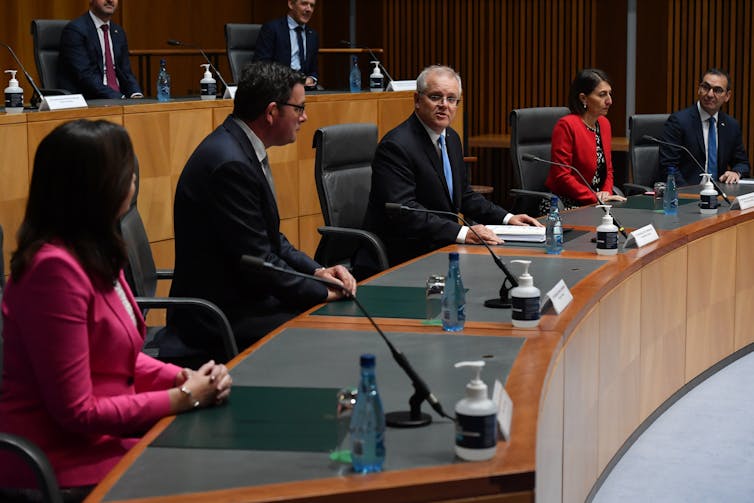
This was recognised when the national cabinet was created. The minutes of the national cabinet meeting of March 15 2020, which record its terms of reference, state:
The National Cabinet does not derogate from the sovereign authority and powers of the Commonwealth or any State or Territory government. The Commonwealth and the States and Territories, as appropriate, remain responsible for the implementation of responses to the Coronavirus.
The prime minister also recognised this in a press conference on May 5 2020. He said:
We’re a federation and, at the end of the day, states have sovereignty over decisions that fall specifically within their domain […] At the end of the day, every Premier, every Chief Minister has to stand in front of their state and justify the decisions that they’re taking in terms of the extent of the restrictions that are in place […] I respect the fact that they’ve each got to make their own call, just like I do, and they’ve got to explain it to the people who live in their state and they’ve got to justify it. And I think that’s the appropriate transparency and accountability.
Isn’t The Commonwealth Boss In The Federation? Can’t It Just Override State Laws?
The Australian Constitution gives certain specific powers to the Commonwealth and general powers to the states. Where their laws conflict, Commonwealth laws override state laws.
For example, the Commonwealth parliament could rely on its external affairs power to enact a law that guarantees freedom of movement, which could override a state law. But this could be difficult while the Commonwealth is restricting movement in and out of Australia.
Alternatively, the Commonwealth parliament could enact a comprehensive quarantine law that covers the whole field of quarantine and associated restriction on movement, to the exclusion of any state law. But the Commonwealth has chosen not to do so. It has left the states to deal with quarantine and public health measures, as they have greater competence and public health facilities to manage the situation.
What About The Constitution? Doesn’t Reaching 80% Vaccination Mean A State Can No Longer Block My Right To Cross State Borders?
Section 92 of the Constitution protects freedom of movement among the states. But the High Court has long accepted there may be exceptions if a law is reasonably necessary and proportionate to achieving another legitimate purpose, such as the protection of public health.
In the Palmer case, it upheld the validity of the Western Australian law that empowered the closure of state borders. In doing so, the Justices noted the restrictions on movement were severe, but were amply justified by the importance of protecting public health.
If it became the case that border restrictions were no longer reasonably necessary and proportionate to protect public health, a challenge might well be successful.
But a court would be likely to take into account all the relevant facts at the time, rather than simply whether a particular percentage of the population has been vaccinated. By the time such a challenge was heard, there would be new evidence to inform the assumptions on which the Doherty Institute relied and a court would be able to take this new evidence into account in making a more informed assessment.
Anne Twomey, Professor of Constitutional Law, University of Sydney
This article is republished from The Conversation under a Creative Commons license. Read the original article.
Facebook or Twitter posts can now be quietly modified by the government under new surveillance laws

A new law gives Australian police unprecedented powers for online surveillance, data interception and altering data. These powers, outlined in the Surveillance Legislation Amendment (Identify and Disrupt) Bill, raise concerns over potential misuse, privacy and security.
The bill updates the Surveillance Devices Act 2004 and Telecommunications (Interception and Access) Act 1979. In essence, it allows law-enforcement agencies or authorities (such as the Australian Federal Police and the Australian Criminal Intelligence Commission) to modify, add, copy or delete data when investigating serious online crimes.
The Human Rights Law Centre says the bill has insufficient safeguards for free speech and press freedom. Digital Rights Watch calls it a “warrantless surveillance regime” and notes the government ignored the recommendations of a bipartisan parliamentary committee to limit the powers granted by the new law.
What’s more, legal hacking by law enforcement may make it easier for criminal hackers to illegally access computer systems via the same vulnerabilities used by the government.
What’s In The Law?
The bill introduces three new powers for law-enforcement agencies:
“data disruption warrants” allow authorities to “disrupt data” by copying, deleting or modifying data as they see fit
“network activity warrants” permit the collection of intelligence from devices or networks that are used, or likely to be used, by subject of the warrant
“account takeover warrants” let agencies take control of an online account (such as a social media account) to gather information for an investigation.
There is also an “emergency authorisation” procedure that allows these activities without a warrant under certain circumstances.
How Is This Different To Previous Laws?
Previous legislation, such as the Telecommunications (Interception and Access) Act 1979 and the Telecommunications Act 1997, contained greater privacy protections. Those laws, and others such as the Surveillances Devices Act 2004, do permit law-enforcement agencies to intercept or access communications and data under certain circumstances.
Read more: Australia's privacy laws gutted in court ruling on what is 'personal information'
However, the new bill gives agencies unprecedented interception or “hacking” powers. It also allows “assistance orders”, which could require selected individuals to assist government hacking or face up to ten years in prison.
Why Do Police Argue This Bill Is Required?
According to the Department of Home Affairs, more and more criminal activity makes use of the “dark web” and “anonymising technologies”. Previous powers are not enough to keep up with these new technologies.
In our view, specific and targeted access to users’ information and activities may be needed to identify possible criminals or terrorists. In some cases, law enforcement agencies may need to modify, delete, copy or add content of users to prevent things like the distribution of child exploitation material. Lawful interception is key to protecting public and national security in the fight of global community against cybercrimes.
How Does Lawful Data Interception Work?
“Lawful interception” is a network technology that allows electronic surveillance of communications, as authorised by judicial or administrative order. There are standards (which means regulations and rules) for telecommunication and internet service providers to achieve this, such as those recommended by the European Telecommunications Standards Institute.
Law-enforcement agencies may require service providers to hand over copies of communications data, decrypted data, or intercepted data without notifying users. Service providers may also have to make available analytical tools such as graphs or charts of target behaviours.
What Are The Privacy Concerns?
The Office of the Australian Information Commissioner and others have also raised privacy concerns. The bill may impact third parties who are not suspected in the investigation of criminal activities. In particular, the bill can authorise access to third party computers, communication and data.
The Human Rights Law Centre argues the proposed broad powers can potentially compel any individual with relevant knowledge of the targeted computer or network to conduct hacking activities. In some cases this may clash with an individual’s right to freedom from self-incrimination.
Enabling law enforcement agencies to modify potential evidence in a criminal proceeding is also a major issue of concern. The detection and prevention of inappropriate data disruption will be a key issue.
The implementation of the new warrants needs to be in line with Privacy Act 1988 which was introduced to promote and protect the privacy of individuals and to regulate Australian government agencies and organisations. Where some agencies may have exemption against the Privacy Act, it is important to balance between public safety and privacy impacts.
What Are The Security Issues And Impacts?
The Identify and Disrupt Bill is a part of an extensive set of Australian digital surveillance laws, including the Telecommunications and Other Legislation Amendment (Assistance and Access) Act 2018 (TOLA), and the Telecommunications (Interception and Access) Amendment (Data Retention) Act 2015 (the Mandatory Metadata Retention Scheme).
Under the Identify and Disrupt Bill, access can be gained to encrypted data which could be copied, deleted, modified, and analysed even before its relevance can be determined. This significantly compromises users’ privacy and digital rights.
Modern encryption can be very hard to crack, so hackers often exploit other vulnerabilities in a system to gain access to unencrypted data. Governments too are reportedly using these vulnerabilities for their own lawful hacking.
Specifically, they depend on “zero-day exploits”, which use software vulnerabilities that are unknown to software vendors or developers, to hack into a system. These vulnerabilities could be exploited for months or even years before they are patched.
Read more: From botnet to malware: a guide to decoding cybersecurity buzzwords
A conflict of interest may arise if law enforcement agencies are using zero-day exploits for lawful hacking. To protect citizens, we would expect these agencies to report or disclose any software vulnerabilities they discover to the software manufacturers so the weakness can be patched.
However, they may instead choose not to report them and use the vulnerabilities for their own hacking. This puts users at risk, as any third party, including criminal organisations, could exploit these so-called zero day vulnerabilities.
It’s not an abstract concern. In 2016, the CIA’s secret stash of hacking tools itself was stolen and published, highlighting the risk of these activities. The Chinese government has claimed the CIA was hacking targets in China for more than a decade using these and similar tools.
Government use of hacking tools may result in worse cyber security overall. The warrant powers given to Australian law enforcement agencies may protect public safety and national interests, but they may also provide powerful means for adversaries to access government data.
This includes the data and online accounts of targeted individuals like state officials, which may significantly impact national security. This possibility needs to be considered in light of the passing of the new bill.
Whilst the justification of the bill for public safety over personal privacy can be debatable, there is no doubt that the security aspects should not be undermined.![]()
James Jin Kang, Lecturer, Computing and Security, Edith Cowan University and Jumana Abu-Khalaf, Research Fellow in Computing and Security, Edith Cowan University
This article is republished from The Conversation under a Creative Commons license. Read the original article.
Disclaimer: These articles are not intended to provide medical advice, diagnosis or treatment. Views expressed here do not necessarily reflect those of Pittwater Online News or its staff.